Search Result
Results for "
dose dependently
" in MedChemExpress (MCE) Product Catalog:
2
Biochemical Assay Reagents
10
Isotope-Labeled Compounds
| Cat. No. |
Product Name |
Target |
Research Areas |
Chemical Structure |
-
- HY-104073
-
-
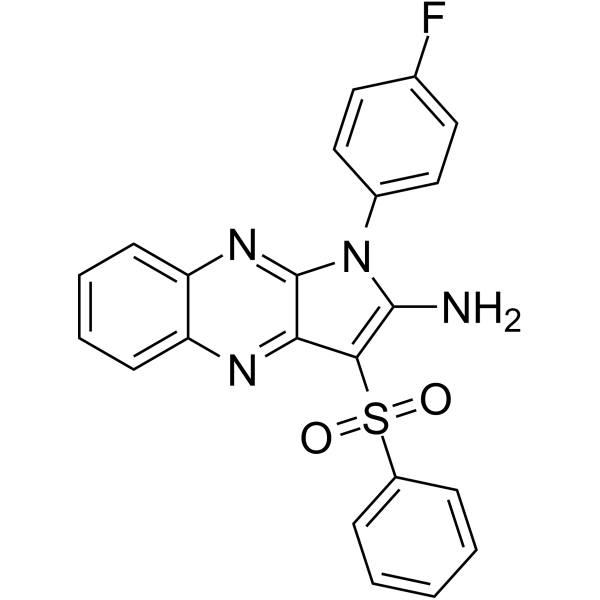
-
- HY-142052
-
|
5a(6)-Anhydrotetracycline
|
Antibiotic
|
Infection
|
Anhydrotetracycline shows dose-dependent and potent inhibition of tetracycline destructases in vitro .
|
-
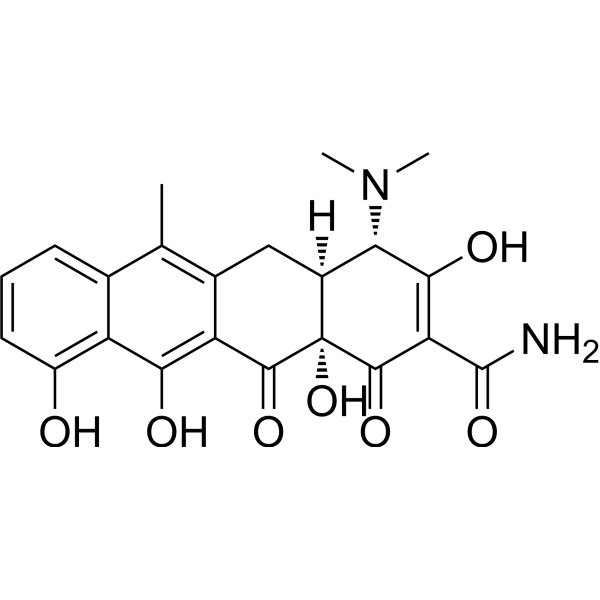
-
- HY-N1960
-
|
|
|
|
|
Ophiopogonin A is a natural steroid that can be found in Ophiopogon japonicus. Ophiopogonin A dose-dependently inhibits hemorrhagic shock (HS)-induced tissue damage and apoptosis. ophiopogonin A dose-dependently promotes the phosphorylation of ERK in HS kidney tissues and hypoxia-treated HK-2 cells .
|
-
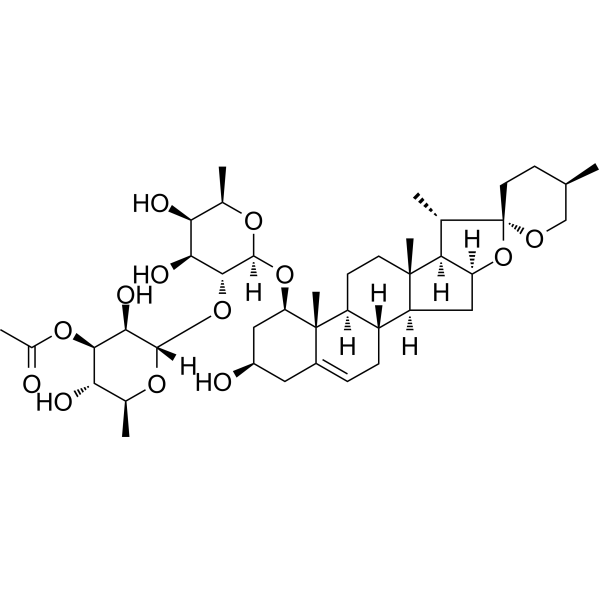
-
- HY-N11922
-
|
|
Others
|
Neurological Disease
|
|
Ipalbidine is an alkaloid extracted from ipomoea Hardwickki Hemsl. Ipalbidine has dose-dependent analgesic effects .
|
-
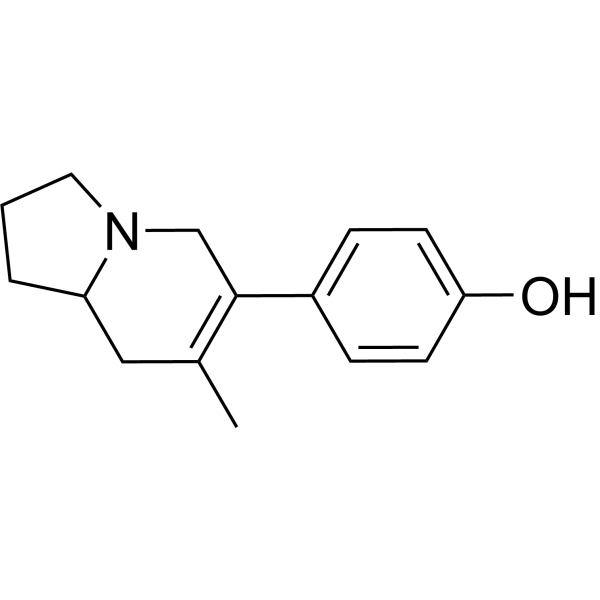
-
- HY-157533
-
|
|
Bacterial
|
Others
|
|
AcrB-IN-5 (compound 8) inhibits AcrB and blocks the efflux pump in a dose-dependent manner .
|
-
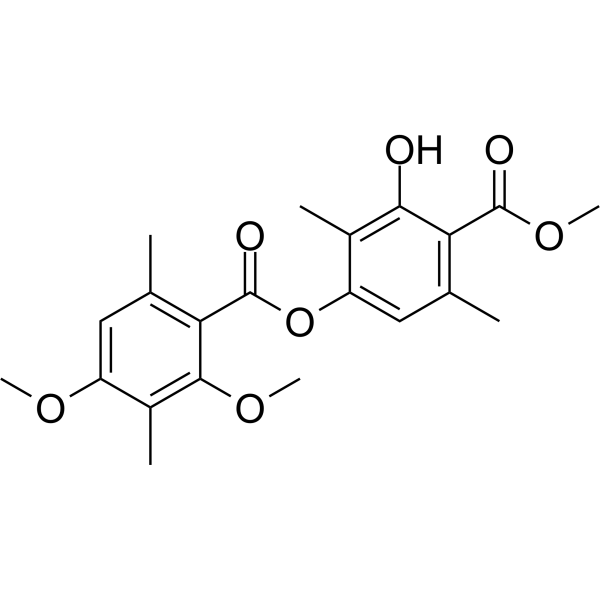
-
- HY-W127334
-
|
|
Biochemical Assay Reagents
|
Others
|
|
N-Palmitoyl phosphatidylethanolamine (Tripelargonin) is endogenous lipid anorectic hormone, significantly reduces food intake in a dose-dependent manner
|
-
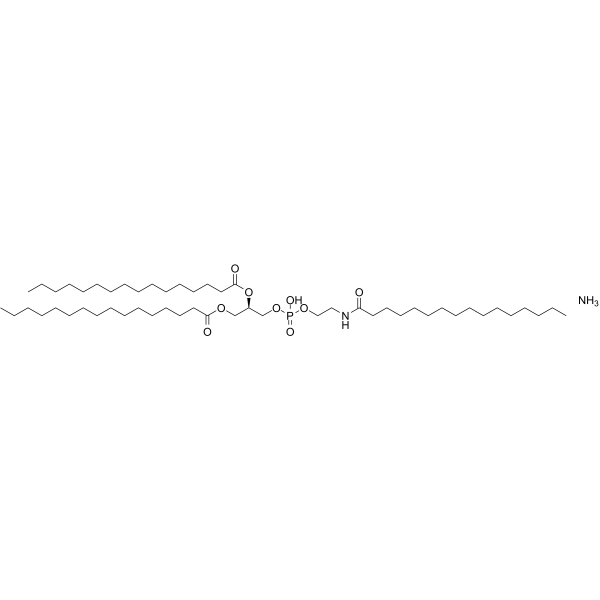
-
- HY-N2383
-
|
(1R,2S,3S,4S,6R)-4-Amino-6-(hydroxymethyl)cyclohexane-1,2,3-triol
|
Glucosidase
|
Metabolic Disease
|
|
Validamine competitively inhibits β-glucosidase in a pH-dependent and dose-dependent manner, with an IC50 value of 2.92mM, and the maximum inhibitory ability is at the optimum pH value of this enzyme .
|
-
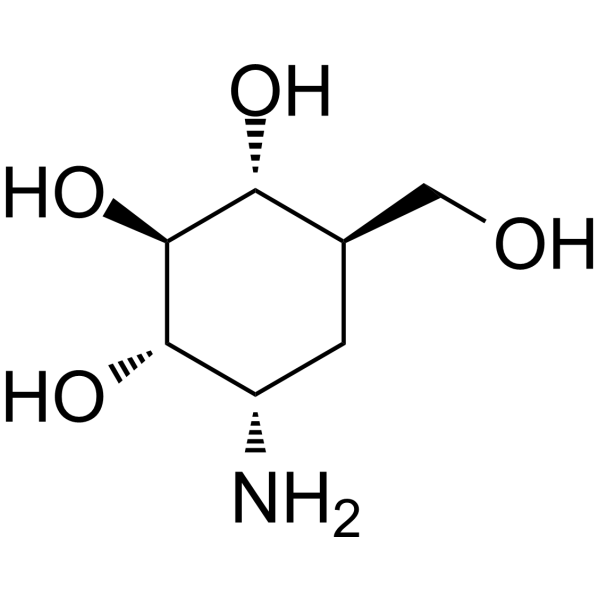
-
- HY-19539
-
|
|
|
|
|
NSC-658497 is an effective inhibitor of Ras-GEF, SOS1. NSC-658497 binds to SOS1, competitively suppresses SOS1-Ras interaction, and dose-dependently inhibits SOS1 GEF activity. NSC-658497 showed dose-dependent efficacy in inhibiting Ras, downstream signaling activities, and associated cell proliferation .
|
-
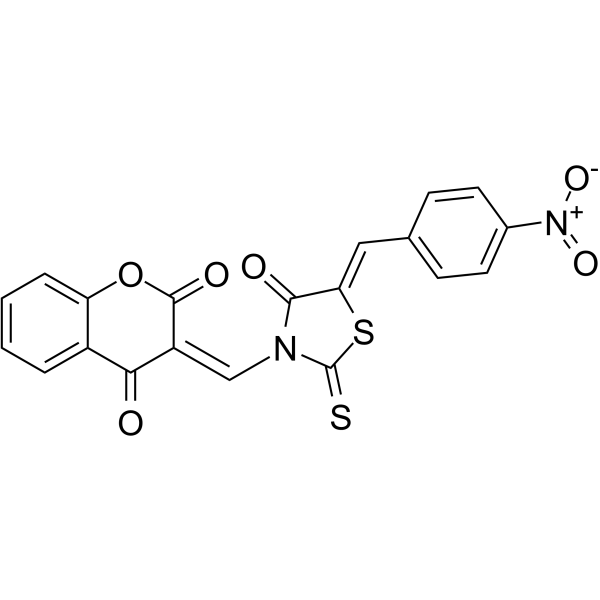
-
- HY-P0249
-
-
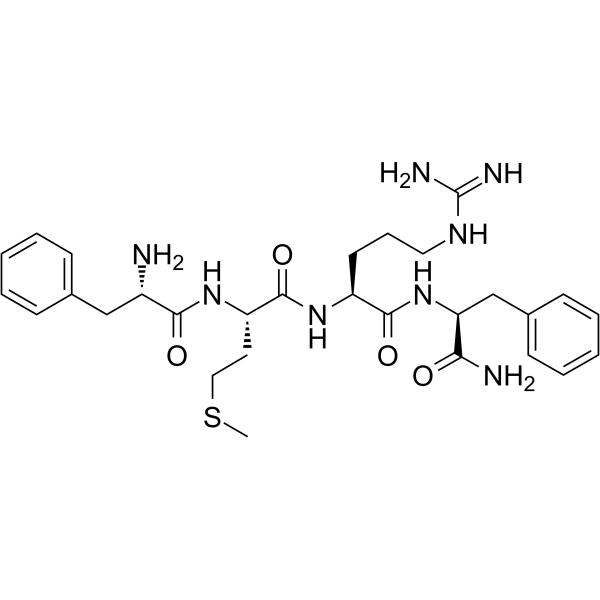
-
- HY-N0528
-
|
Buddleoside; Linarine
|
Cholinesterase (ChE)
|
Neurological Disease
|
|
Linarin (Buddleoside), isolated from the flower extract of Mentha arvensis, shows selective dose dependent inhibitory effect on acetylcholinesterase (AChE) .
|
-
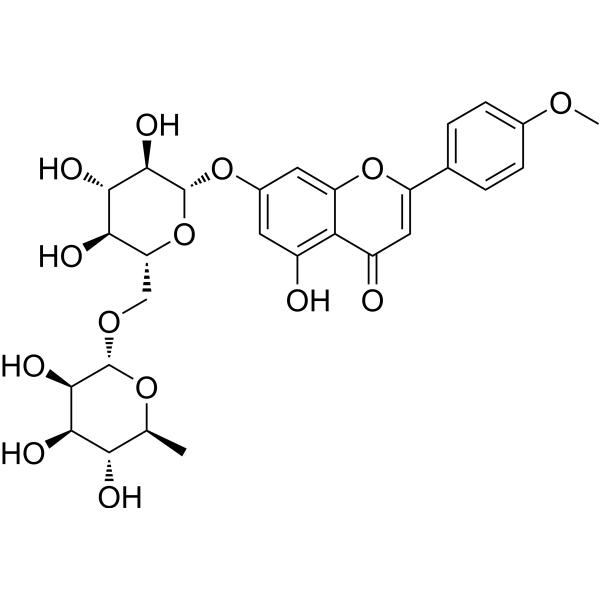
-
- HY-100585
-
|
Splitomycin
|
HDAC
|
Cancer
|
|
Splitomicin (Splitomycin) is a selective Sir2p inhibitor. Splitomicin inhibits NAD +-dependent HDAC activity of Sir2 protein. Splitomicin induces dose-dependent inhibition of HDAC in the yeast extract with an IC50 of 60 μM .
|
-
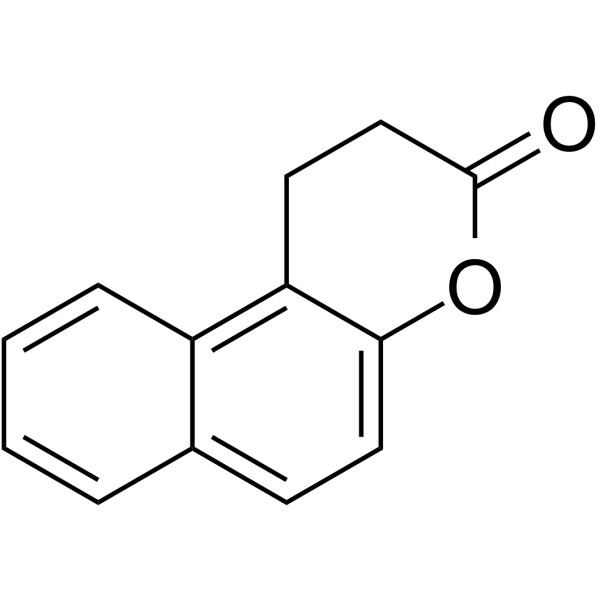
-
- HY-P0249B
-
-
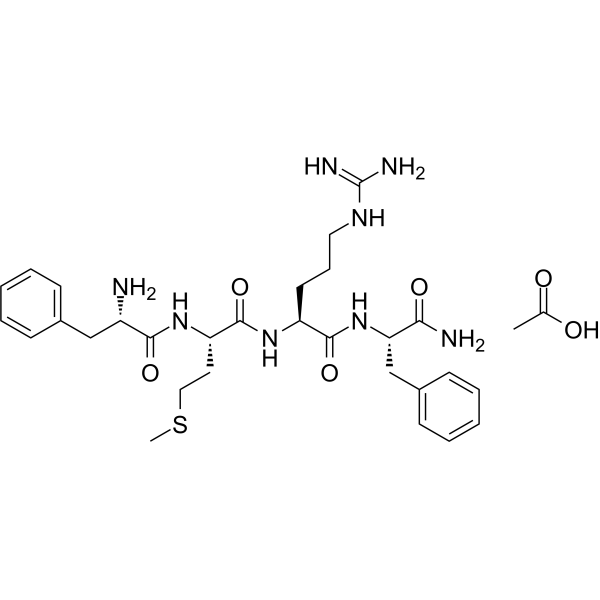
-
- HY-101595
-
|
|
Others
|
Others
|
|
RPH-2823, a basic triamterene derivative, induces a dose-dependent decrease in short-circuit current (SCC) and increase in transepithelial electrical resistance .
|
-
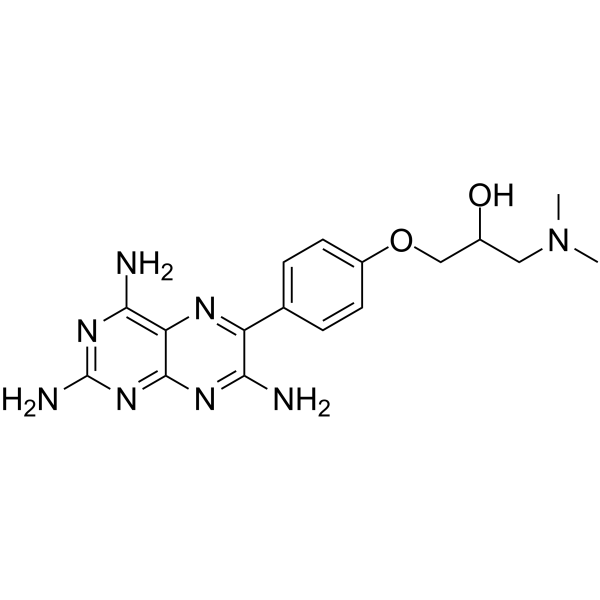
-
- HY-N5099
-
|
|
Others
|
Metabolic Disease
|
|
N-Vanillyldecanamide, a capsaicinoid isolated from the fruits of Capsicum annuum, significantly reduced the radical length of Lactuca sativa seedling in a dose-dependent manner .
|
-
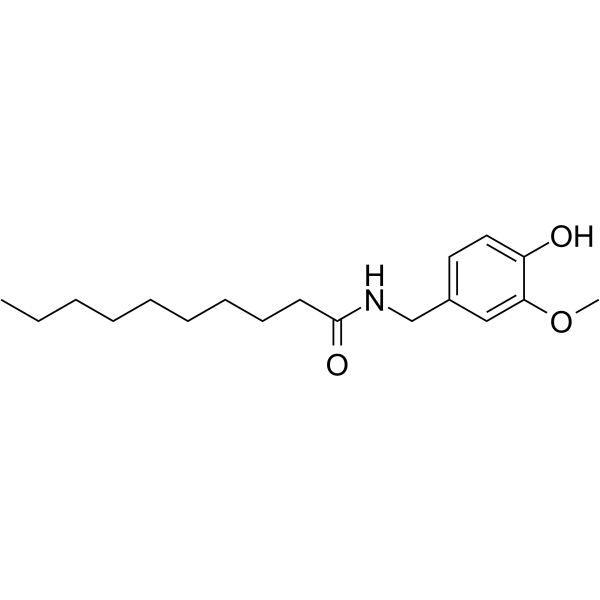
-
- HY-N8816
-
|
|
NF-κB
|
Inflammation/Immunology
|
|
Stipuleanoside R2 inhibits NF-κB activation stimulated by TNFα in a dose-dependent manner with IC50 value of 4.1 μM .
|
-

-
- HY-103188
-
|
|
Adenosine Receptor
|
Neurological Disease
|
|
PD81723 is an adenosine receptor binding enhancer. PD81723 enhances the inhibition of exogenous adenosine in a dose-dependent manner in hippocampal brain sections .
|
-

-
- HY-B0163
-
-

-
- HY-B0163A
-
-
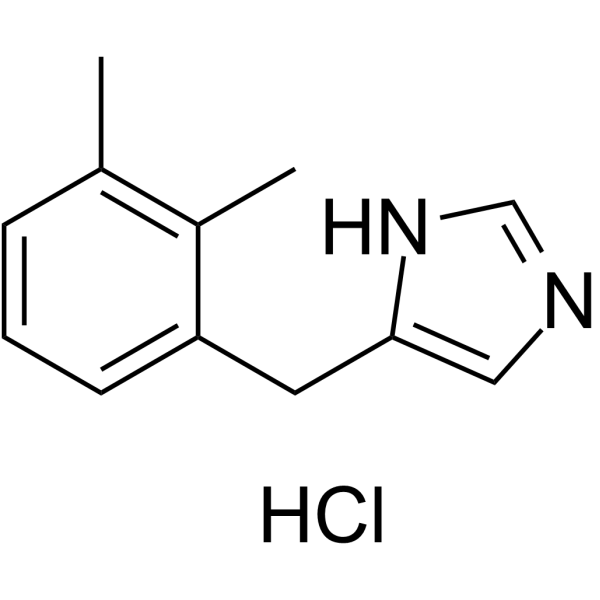
-
- HY-12289A
-
|
VS-6063 hydrochloride; PF 04554878 hydrochloride
|
FAK
|
Cancer
|
|
Defactinib hydrochloride (VS-6063 hydrochloride; PF 04554878 hydrochloride) is a novel FAK inhibitor, which inhibits FAK phosphorylation at the Tyr397 site in a time- and dose-dependent manner.
|
-

-
- HY-19832
-
SC66
5 Publications Verification
|
Akt
Apoptosis
|
Cancer
|
|
SC66 is an Akt inhibitor, reduces cell viability in a dose- and time-dependent manner, inhibits colony formation and induces apoptosis in hepatocellular carcinoma (HCC) cells.
|
-
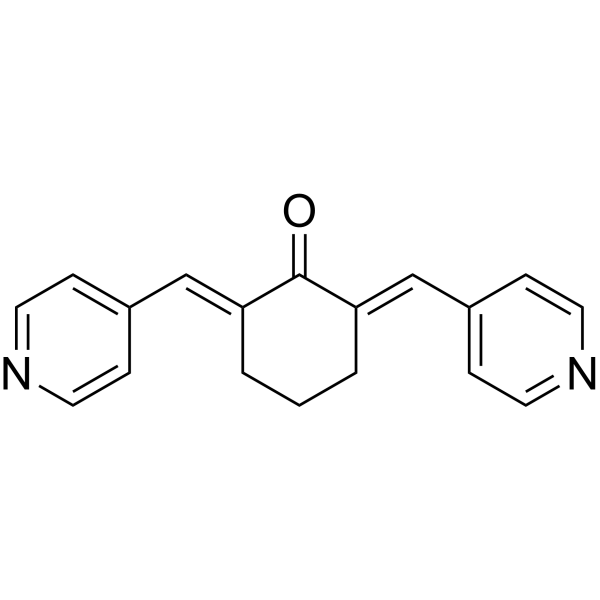
-
- HY-111408
-
|
|
Deubiquitinase
|
Cancer
|
|
EOAI3402143 is a deubiquitinase (DUB) inhibitor, which inhibits dose-dependently inhibits Usp9x/Usp24 and Usp5.
|
-
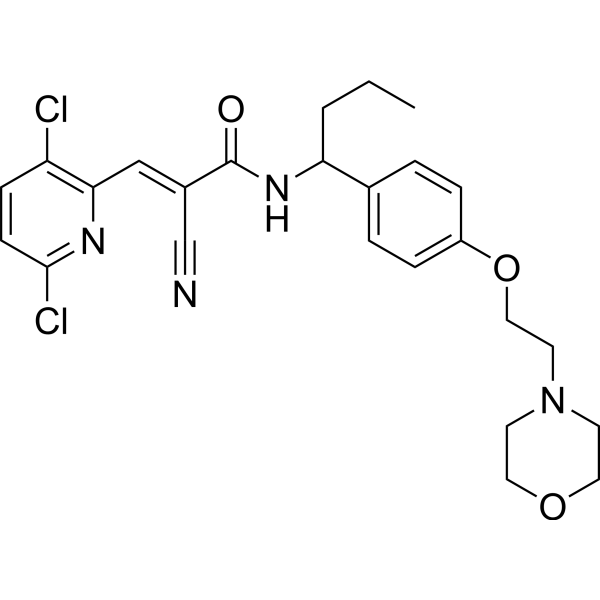
-
- HY-123786
-
|
|
Others
|
Cancer
|
|
NSC745887 (compound 25) is an anti-cancer agent. NSC745887 exhibits dose-dependent inhibition of proliferation in all 60 cancer cell lines .
|
-
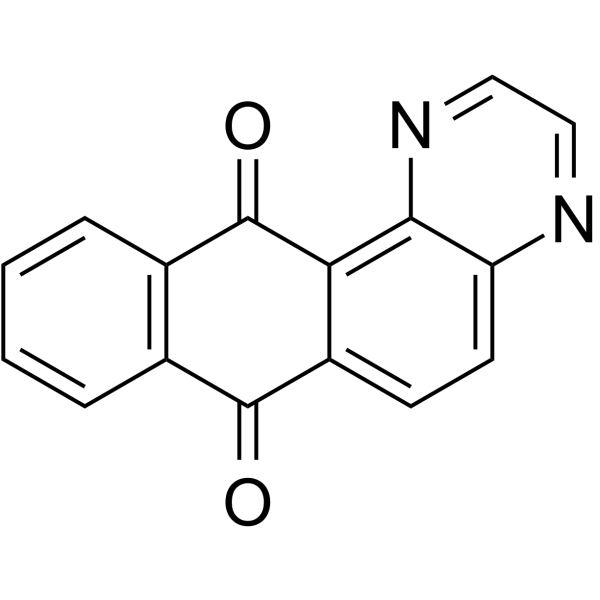
-
- HY-150739A
-
-

-
- HY-143468
-
|
|
Apoptosis
MEK
|
Cancer
|
|
MEK-IN-5 is a potent MEK inhibitor and NO donor. MEK-IN-5 significantly reduces the levels of pMEK and pERK in a dose-dependent and time-dependent manner. MEK-IN-5 induces apoptosis in MDA-MB-231 cells .
|
-
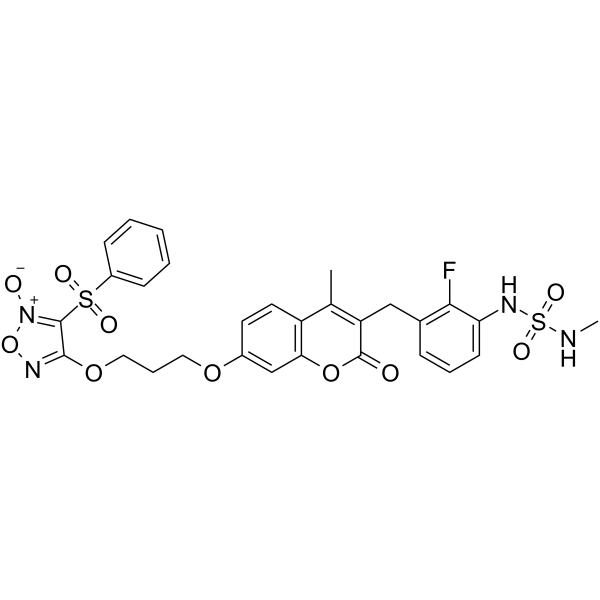
-
- HY-108436
-
|
|
Phosphodiesterase (PDE)
|
Cancer
|
|
Deltazinone 1, a pyrazolopyridazinone, is a highly selective PDEδ inhibitor with a KD of 8 nM. Deltazinone 1 inhibits the PDEδ-Ras interaction. Deltazinone 1 shows a dose-dependent inhibitory response on proliferation in oncogenic KRas-dependent cell lines .
|
-
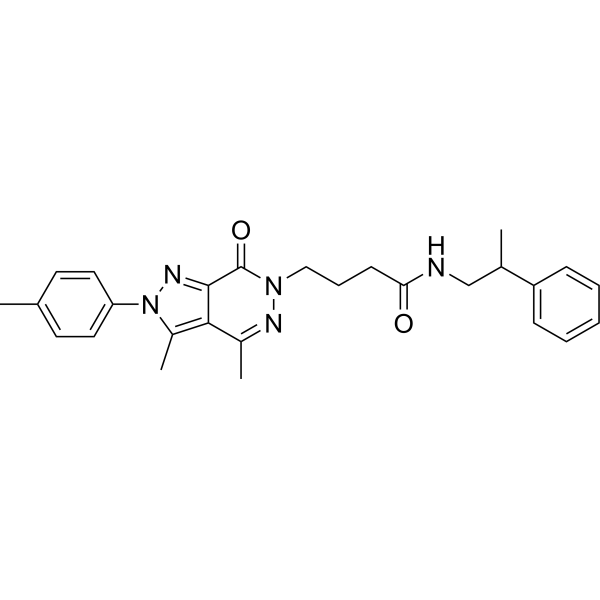
-
- HY-112650
-
-
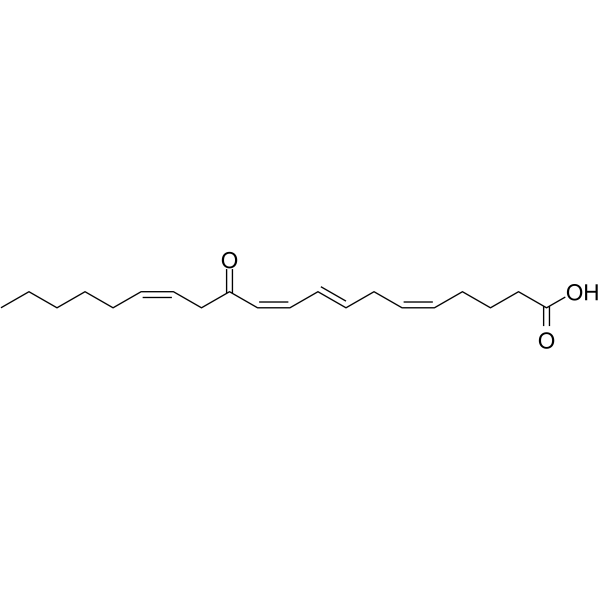
-
- HY-138054
-
|
|
MDM-2/p53
|
Cancer
|
|
Cjoc42 is a compound capable of binding to gankyrin. Cjoc42 inhibits gankyrin activity in a dose-dependent manner. Cjoc42 prevents the decrease in p53 protein levels normally associated with high amounts of gankyrin. Cjoc42 restores p53-dependent transcription and sensitivity to DNA damage .
|
-

-
- HY-N0775
-
|
7-Isocorynoxeine
|
5-HT Receptor
|
Neurological Disease
|
|
Isocorynoxeine, an isorhynchophylline-related alkaloid, exhibits a dose-dependent inhibition of 5-HT2A receptor-mediated current response with an IC50 of 72.4 μM.
|
-
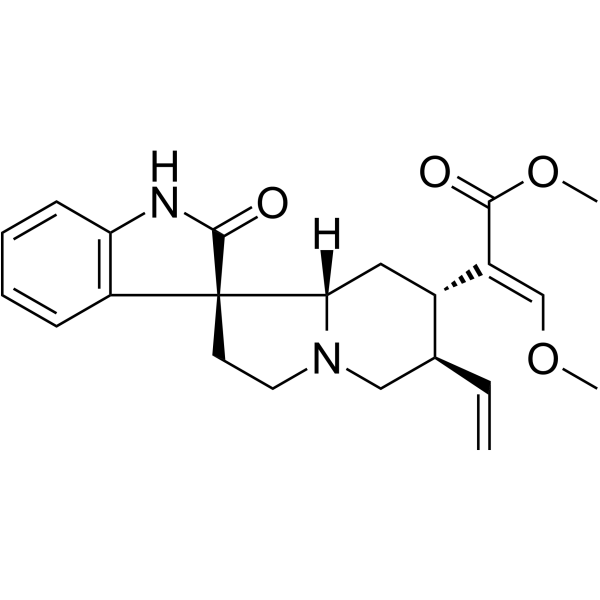
-
- HY-N6621
-
|
|
Topoisomerase
|
Cancer
|
|
Hippeastrine, an active alkaloid, exhibits a good dose-dependent inhibitory effect against topoisomerase I (Top I) with an IC50 at 7.25 μg/mL. Antiproliferative and anticancer activities .
|
-
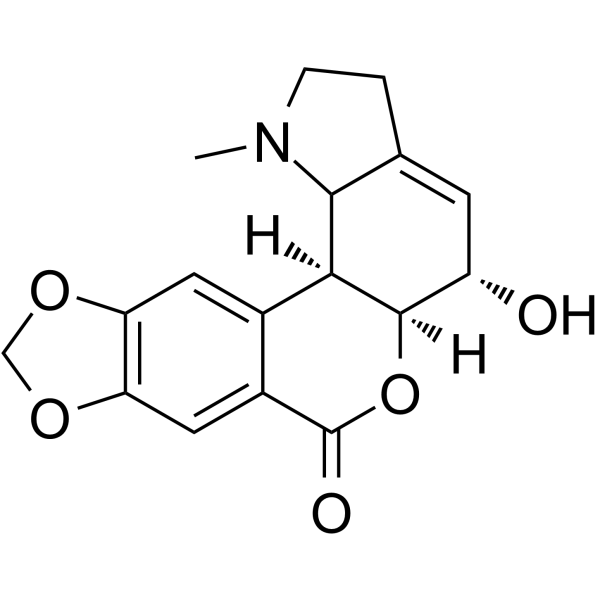
-
- HY-119977
-
|
|
Reactive Oxygen Species
|
Others
|
|
APF is a fluorescence probe that can selectively, and dose dependently detect certain species among ROS and that are highly resistant to autoxidation. APF can be used in enzymatic and cellular systems .
|
-
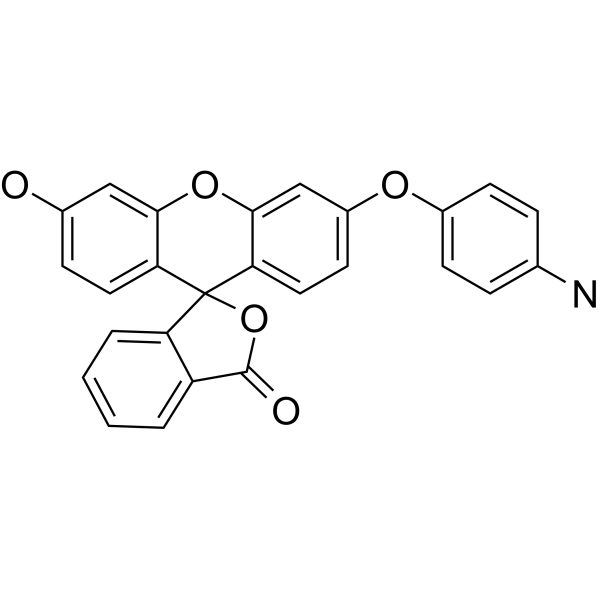
-
- HY-147391
-
|
|
Sodium Channel
|
Neurological Disease
|
|
ASIC-IN-1 is a potent acid sensing ion channel inhibitor with an IC50 value of < 10 µM. ASIC-IN-1 causes a dose- dependent reduction of the pain intensity .
|
-
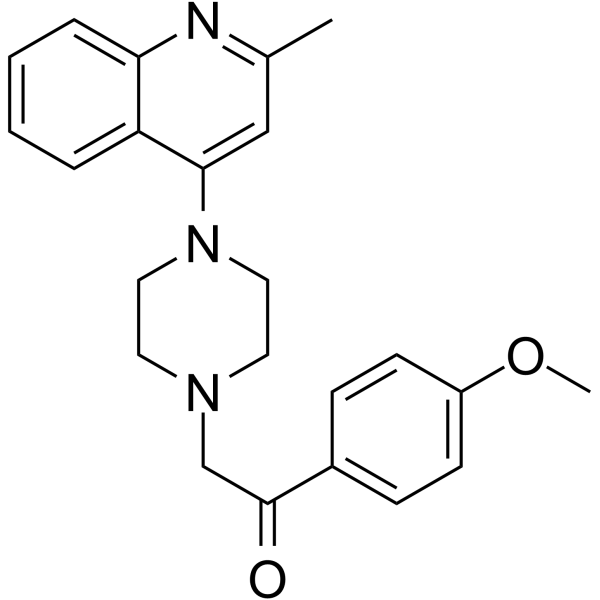
-
- HY-N1159
-
|
|
NF-κB
|
Inflammation/Immunology
|
|
Teuclatriol is an NF-κB inhibitor can be isolated from salvia mirzayanii, has anti-inflammatory effects. Teuclatriol inhibits TNF-α secretion in a dose-dependent manner .
|
-
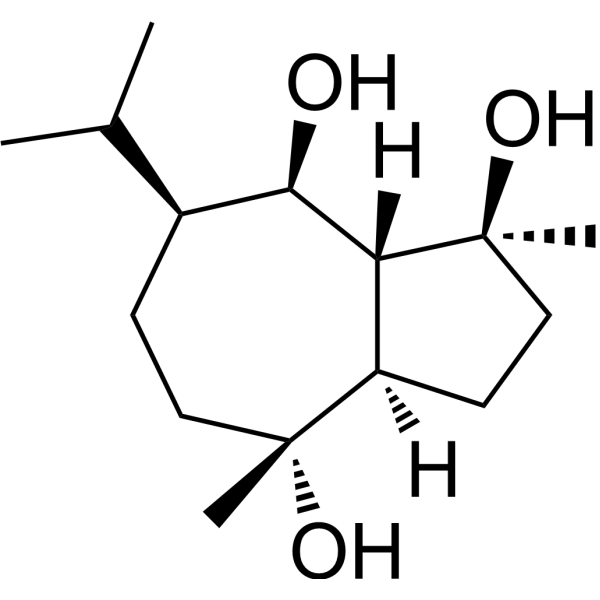
-
- HY-150190
-
|
|
Histone Methyltransferase
|
Cancer
|
|
F5446 (compound 1) is an inhibitor of SUV39H1 methyltransferase. F5446 induces human colon carcinoma cell death in a dose-dependent manner .
|
-
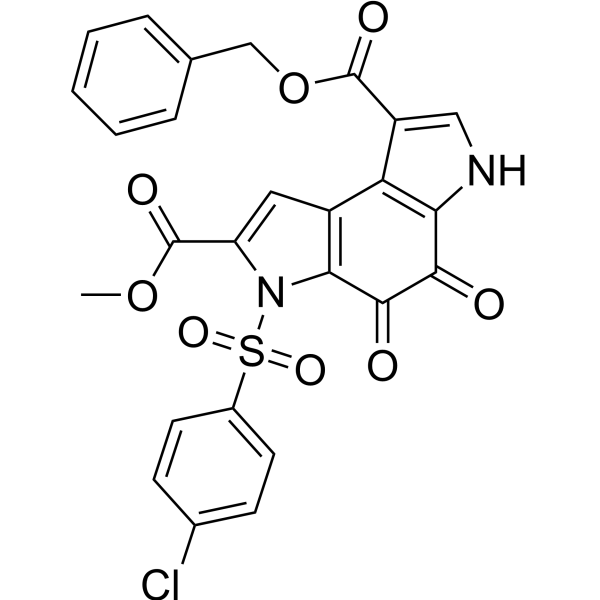
-
- HY-124597
-
|
|
Others
|
Inflammation/Immunology
|
|
ARN726 is a potent NAAA (N-acylethanolamine acid amidase) inhibitor with an IC50 of 0.073 µM. ARN726 decreases alcohol self-administration in a dose-dependent manner .
|
-
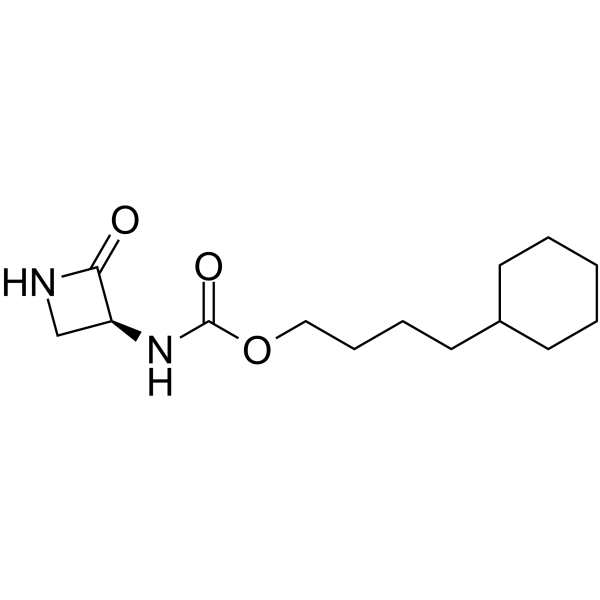
-
- HY-P3730
-
|
|
CDK
|
Cancer
|
|
Cdk2/Cyclin Inhibitory Peptide I (Tat-LFG), a CDK2 inhibitor, kills U2OS osteosarcoma cells in a dose-dependent manner .
|
-

-
- HY-P3731
-
|
|
CDK
|
Cancer
|
|
Cdk2/Cyclin Inhibitory Peptide II (Tat-LDL), a CDK2 inhibitor, kills U2OS osteosarcoma cells in a dose-dependent manner .
|
-

-
- HY-122874
-
-
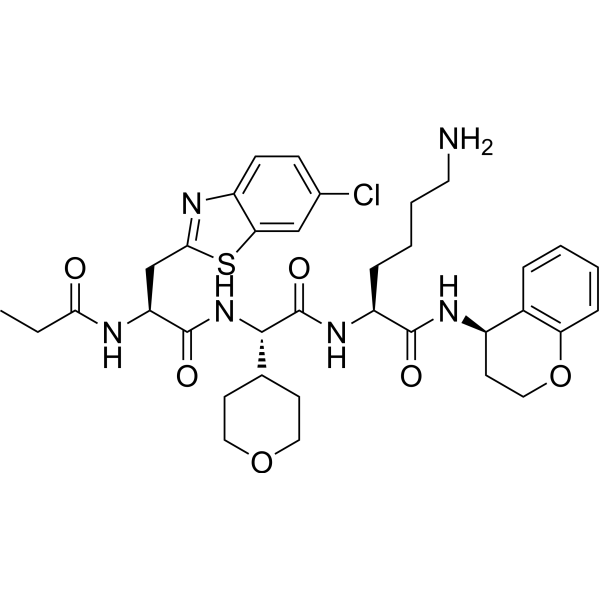
-
- HY-150739
-
-

-
- HY-N1410
-
|
|
|
|
|
Triacetylresveratrol, an acetylated analog of Resveratrol. Triacetylresveratrol decreases the phosphorylation of STAT3 and NF-κB in a dose- and time- dependent manner in PANC-1 and BxPC-3 cells. Anticancer effects .
|
-

-
- HY-137131
-
|
DC-Cholesterol hydrochloride
|
Amyloid-β
Liposome
|
Neurological Disease
|
|
DC-Chol hydrochloride could inhibit Aβ40 fibril formation under appropriate experimental conditions. DC-Chol hydrochloride strongly inhibits amyloidogenesis of oxidized hCT in a dose-dependent manner .
|
-
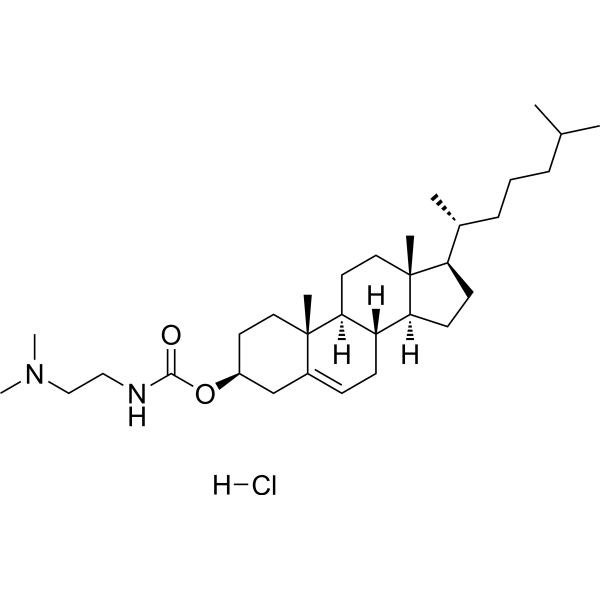
-
- HY-107164
-
|
4-Hydroxythiomarinol C
|
Antibiotic
Bacterial
|
Infection
|
|
Thiomarinol A (4-Hydroxythiomarinol C) is a potent antibiotic. Thiomarinol A is a hybrid of dithiolopyrrolone and marinolic acid. Thiomarinol A shows antimicrobial activity. Thiomarinol A inhibits MRSA IleRS in a dose-dependent with a Ki app value of 19 nM .
|
-
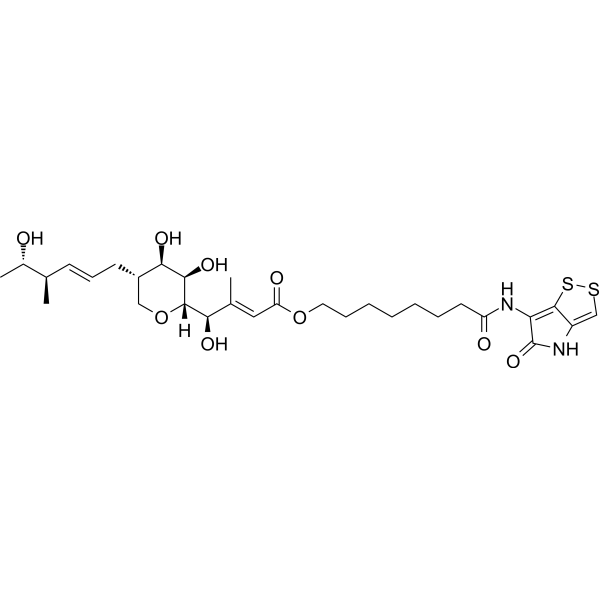
-
- HY-13809
-
|
XL-139
|
Smo
Apoptosis
|
Cancer
|
|
BMS-833923 (XL-139) is an orally biocompatible Smoothened (Smo) inhibitor with anti-tumor activity. It can inhibit the binding of BODIPY cyclopamine to SMO in a dose-dependent manner with an IC50 of 21 nM .
|
-
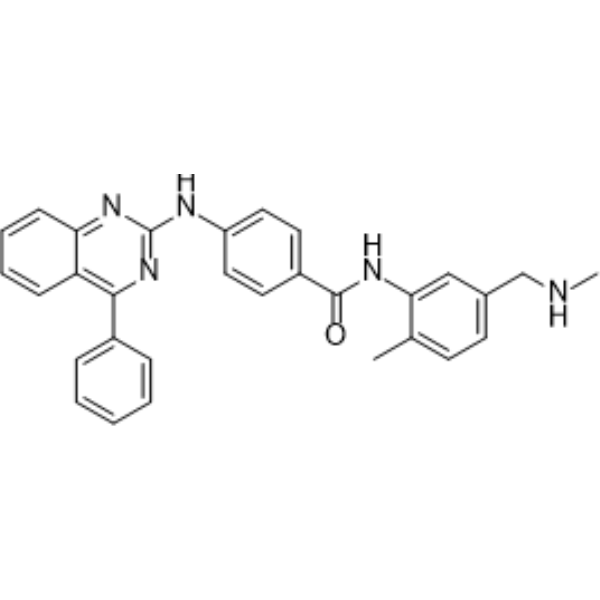
-
- HY-110241
-
|
|
nAChR
|
Neurological Disease
|
|
Dianicline dihydrochloride is a α4β2 nicotinic acetylcholine receptor partial agonist, a class of agents that includes varenicline and cytisine for smoking cessation. Dianicline dihydrochloride increases cessation rates in a dose-dependent manner .
|
-

-
- HY-111317
-
|
|
Sirtuin
|
Metabolic Disease
|
|
SIRT1 activator 3 is a potent activator of Sirt1 and suppresses TNF-α in a dose-dependent manner. SIRT1 activator 3 has the potential for anti-obesity or anti-diabetic researches .
|
-
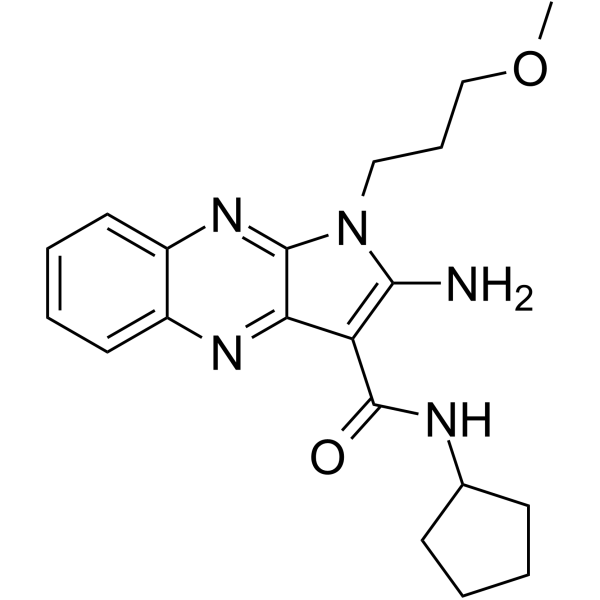
-
- HY-12956B
-
|
Prostaglandin F2β; PGF2β
|
Endogenous Metabolite
|
Others
|
|
(5R)-Dinoprost is a metabolite produced by cyclooxygenase metabolism of arachidonic acid. (5R)-Dinoprost (Prostaglandin F2β) induces dose-dependent release of hexose containing mucin .
|
-

-
- HY-123767
-
|
|
HBV
|
Infection
|
|
HEC72702 is a potent and orally active hepatitis B virus capsid inhibitor with an EC50 values of 0.039 µM. HEC72702 dose-dependently reduced HBV DNA in both the plasma and livers .
|
-
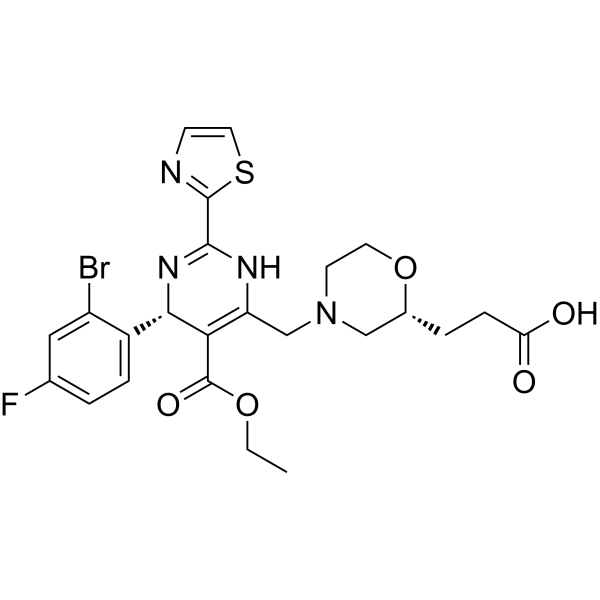
-
- HY-118541
-
|
|
Others
|
Others
|
|
RH-5849 is an orally active agonist for non-steroidal ecdysteroid, which inhibits the larval growth of Plodia inferpuncteila in a dose-dependent manner. RH-5849 exhibits molting hormone activity .
|
-
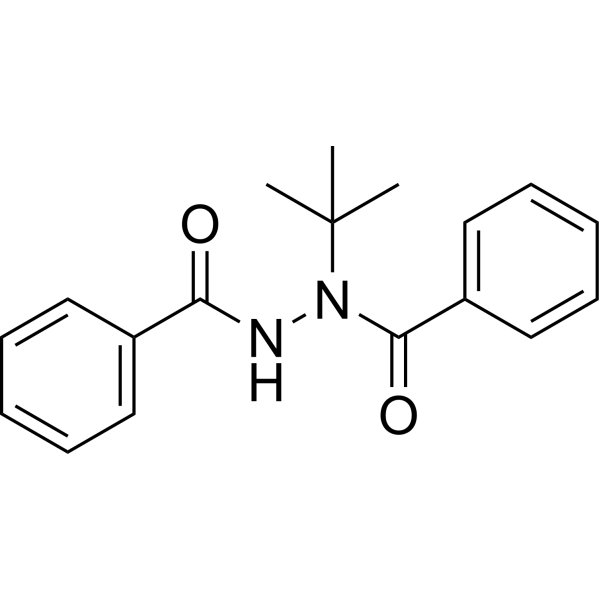
-
- HY-P2080
-
|
|
Insulin Receptor
|
Metabolic Disease
|
|
GIP (1-30) amide,human is a glucose-dependent insulinotropic polypeptide (GIP) fragment. GIP is an incretin hormone that stimulates insulin secretion and reduces postprandial glycaemic excursions. GIP (1-30) amide,human dose-dependently promotes insulin secretion over the range 10 -9-10 -6 M .
|
-

-
- HY-P2080B
-
|
|
Insulin Receptor
|
Metabolic Disease
|
|
GIP (1-30) amide,human acetate is a glucose-dependent insulinotropic polypeptide (GIP) fragment. GIP is an incretin hormone that stimulates insulin secretion and reduces postprandial glycaemic excursions. GIP (1-30) amide,human acetate dose-dependently promotes insulin secretion over the range 10 -9-10 -6 M .
|
-

-
- HY-N6681
-
|
|
Caspase
Bacterial
Apoptosis
Antibiotic
|
Infection
|
|
15-acetoxyscirpenol, one of acetoxyscirpenol moiety mycotoxins (ASMs), strongly induces apoptosis and inhibits Jurkat T cell growth in a dose-dependent manner by activating other caspases independent of caspase-3 .
|
-
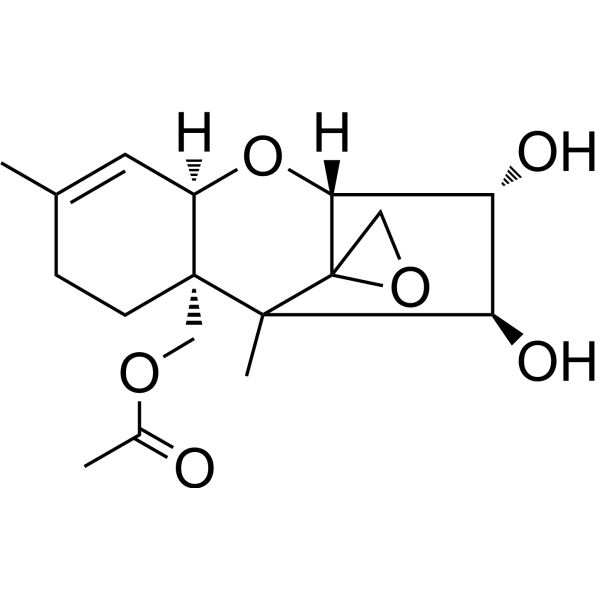
- HY-N0220
-
-

- HY-107627
-
|
|
Melanocortin Receptor
|
Inflammation/Immunology
|
|
MCL0020 is a potent and selective melanocortin MC4 receptor antagonist, with an IC50 of 11.63 nM. MCL0020 dose-dependently and significantly attenuates restraint stress-induced anorexia without affecting food intake .
|
-
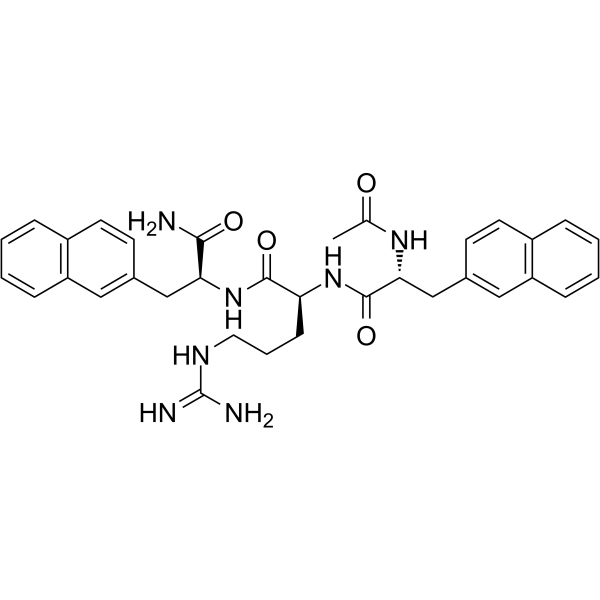
- HY-15648C
-
GSK-J5
1 Publications Verification
|
Histone Demethylase
Parasite
|
Cancer
|
|
GSK-J5 is a potent inhibitor of Schistosome and worm. GSK-J5 increases schistosomula mortality and adult worm motility and mortality, as well as egg oviposition, in a dose- and time-dependent manner .
|
-

- HY-N5060
-
|
4-Allylanisole
|
Parasite
|
Neurological Disease
|
|
Estragole (4-Allylanisole), a relatively nontoxic volatile terpenoid ether, is a major component of the essential oil of many plants. Estragole dose-dependently blocks nerve excitability . Estragole displays anti-toxoplasma activity .
|
-

- HY-119819
-
|
|
Bacterial
Parasite
Antibiotic
|
Infection
|
|
Psicofuramine a nucleoside antibiotic and has the inhibition of xanthosine 5'-phosphate aminase. Psicofuranine also specifically inhibits GMP synthase, and interrupts parasite growth. Psicofuranine exhibits a dose-dependent inhibition of P. falciparum growth .
|
-
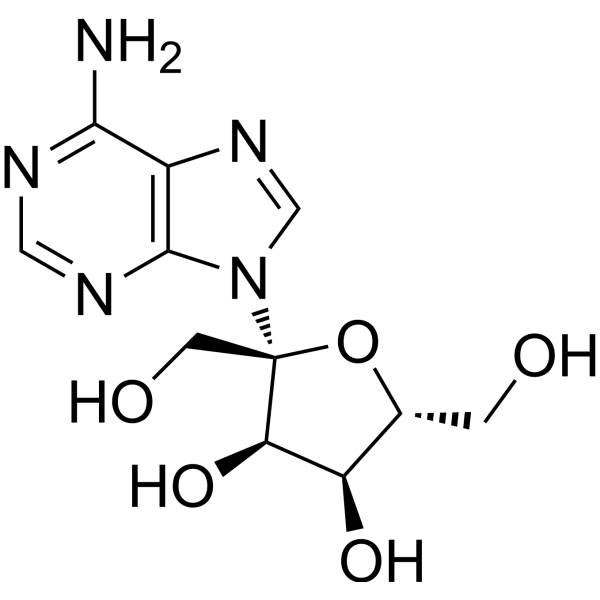
- HY-121377
-
-
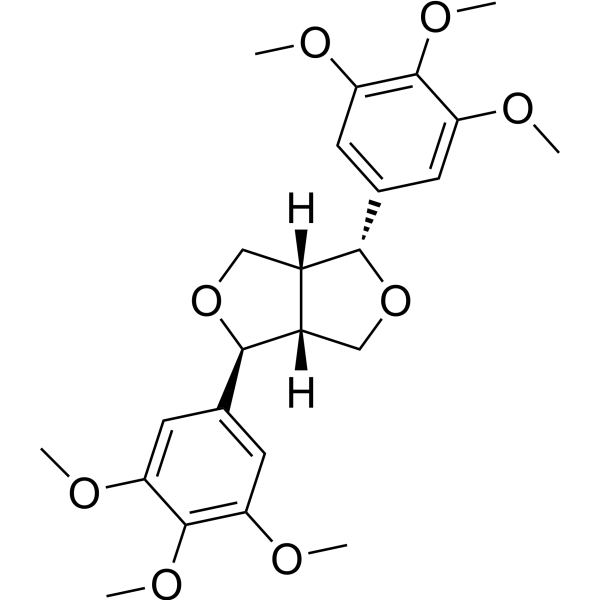
- HY-122049
-
-
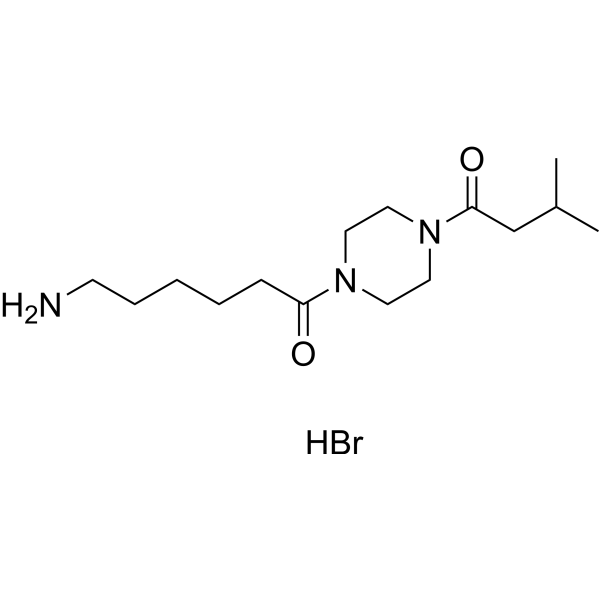
- HY-P10032
-
-
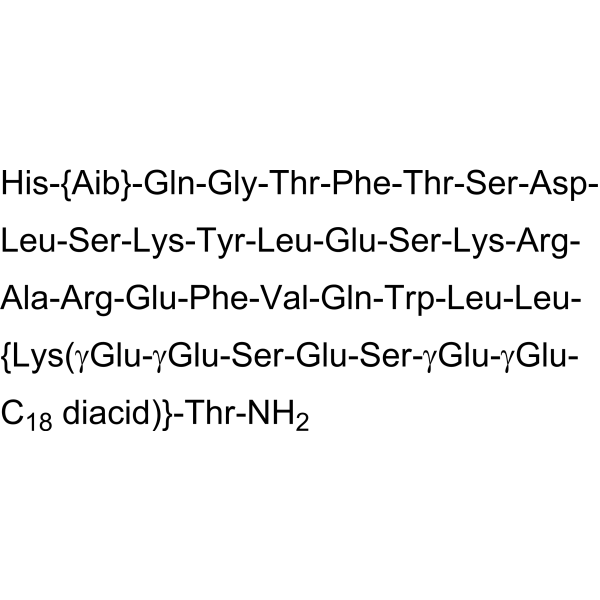
- HY-P2080C
-
|
|
Insulin Receptor
|
Metabolic Disease
|
|
GIP (1-30)-Myr is the Myr-modified GIP (1-30), which is a glucose-dependent insulinotropic polypeptide (GIP) fragment. GIP is an incretin hormone that stimulates insulin secretion and reduces postprandial glycaemic excursions. GIP (1-30) dose-dependently promotes insulin secretion over the range 10 -9-10 -6 M .
|
-

- HY-137820
-
|
|
DNA/RNA Synthesis
|
Others
|
|
Brr2-IN-3 is a potent and selective Brr2 helicase allosteric Inhibitor. Brr2-IN-3 inhibits helicase activity in dose-dependent manner with an IC50 value of 1.3 μM .
|
-
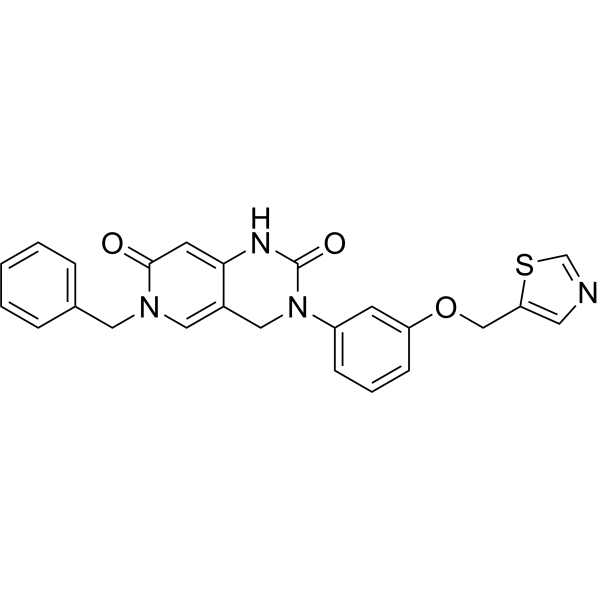
- HY-114850A
-
|
Prostaglandin F2β tromethamine; PGF2β tromethamine
|
Endogenous Metabolite
|
Others
|
|
(5R)-Dinoprost tromethamine (Prostaglandin F2β tromethamine) is a metabolite produced by the metabolism of arachidonic acid cyclooxygenase. (5R)-Dinoprost tromethamine induces dose-dependent release of hexosaccharide containing mucin .
|
-
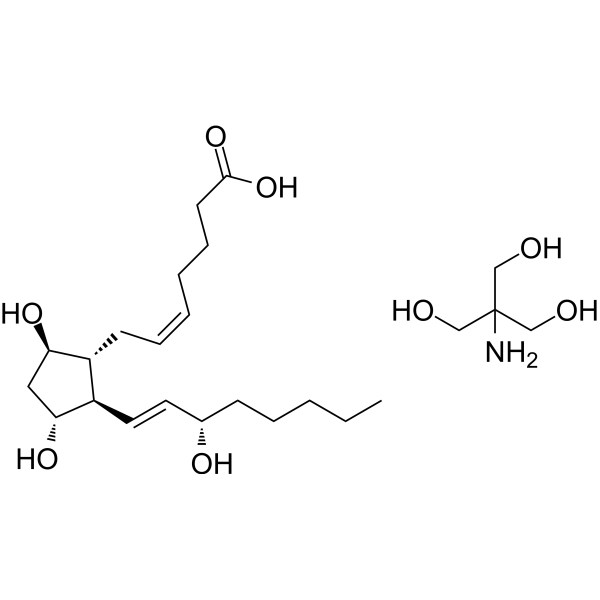
- HY-10787
-
|
H 376/95
|
Thrombin
|
Cardiovascular Disease
|
|
Ximelagatran (H 376/95) is an orally active thrombin inhibitor that selectively and competitively inhibits both free and clot-bound thrombin. Ximelagatran is an anticoagulant agent with a rapid onset of anticoagulant effect, predictable, dose-dependent pharmcokinetics and pharmacodynamics .
|
-
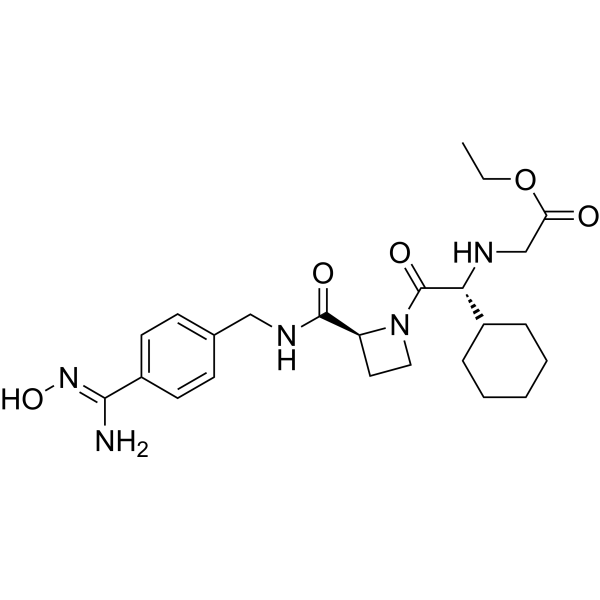
- HY-103101
-
|
|
5-HT Receptor
|
Others
|
|
LP44 (hydrochloride) is a selective 5-HT7 agonist with Ki of 0.22 nM. LP44 (hydrochloride) induces hypothermic effect in a dose-dependent manner by intracerebroventricular injection. LP44 (hydrochloride) not causes considerable hypothermic response by intraperitoneal administration .
|
-
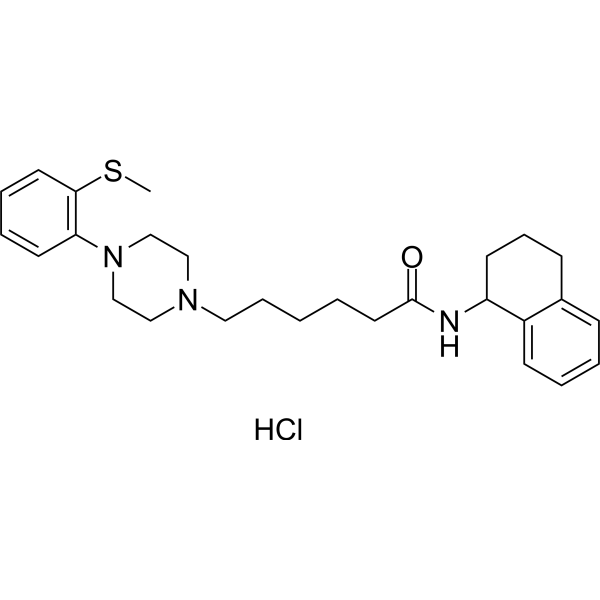
- HY-P3462A
-
|
|
CGRP Receptor
|
Metabolic Disease
|
|
Cagrilintide acetate is a non-selective AMYR/CTR agonist and long-acting acylated amylase analogue. Cagrilintide acetate causes a reduction in food intake and significant weight loss in a dose-dependent manner. Cagrilintide acetate can be used in obesity studies .
|
-

- HY-149856
-
|
|
Microtubule/Tubulin
Apoptosis
|
Cancer
|
|
Tubulin inhibitor 33, a tubulin polymerization inhibitor, inhibits tubulin polymerization in a dose-dependent manner with an IC50 of 9.05 μM. Tubulin inhibitor 33 has antitumor effects and induces cell apoptosis that can be used for antitumor research .
|
-
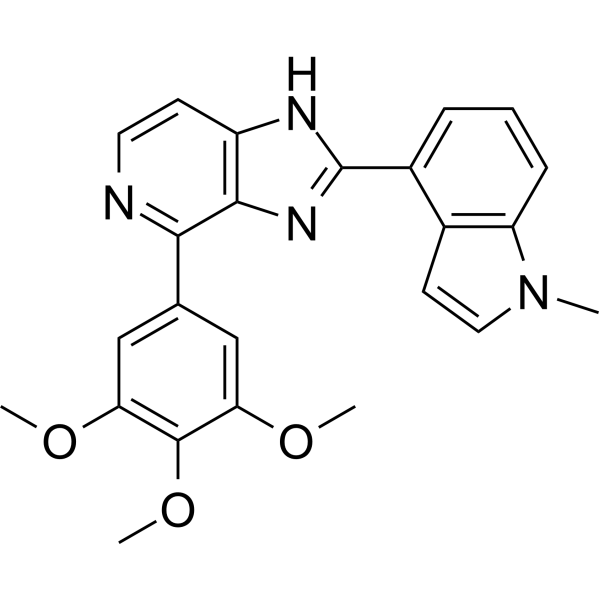
- HY-157124
-
|
|
Tyrosinase
|
Metabolic Disease
|
Tyrosinase-IN-19 (compound 9) is a competitive tyrosinase inhibitor. Tyrosinase-IN-19 has strong antioxidant activities against ROS, ABTS+, and DPPH radicals. Tyrosinase-IN-19 suppresses tyrosinase expression in a dose-dependent manner .
|
-
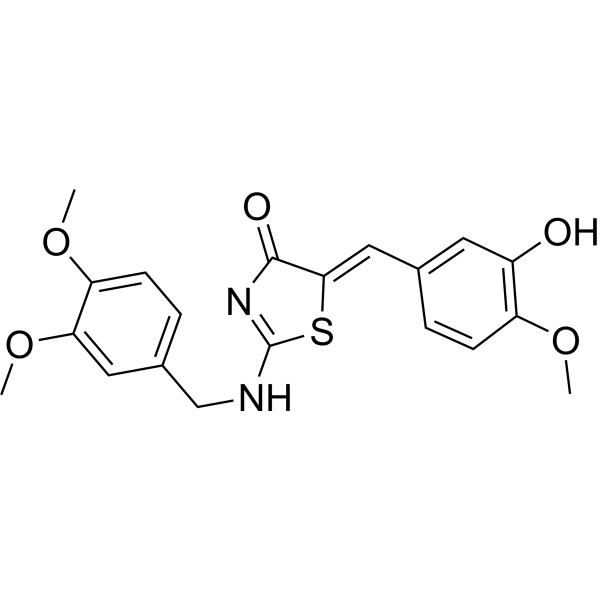
- HY-124726
-
|
|
Autophagy
|
Neurological Disease
Cancer
|
|
Aumitin is a diaminopyrimidine-based autophagy inhibitor which inhibits mitochondrial respiration by targeting complex I. Aumitin inhibits starvation- and rapamycin induced autophagy dose dependently with IC50s of 0.12 μM and 0.24 μM, respectively .
|
-
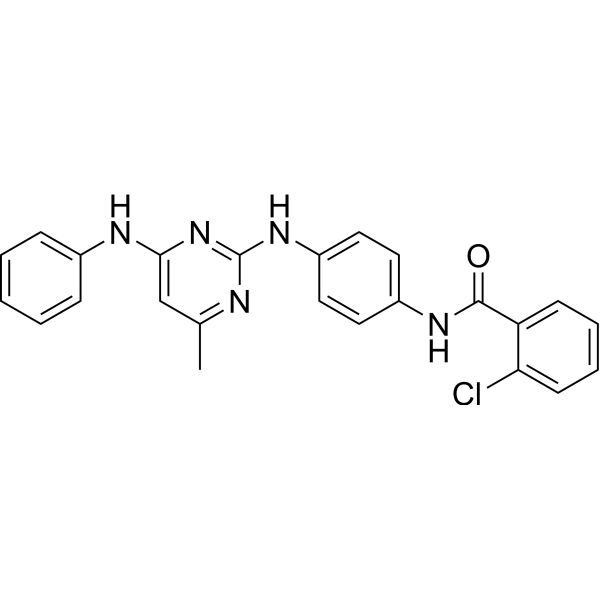
- HY-121356
-
-
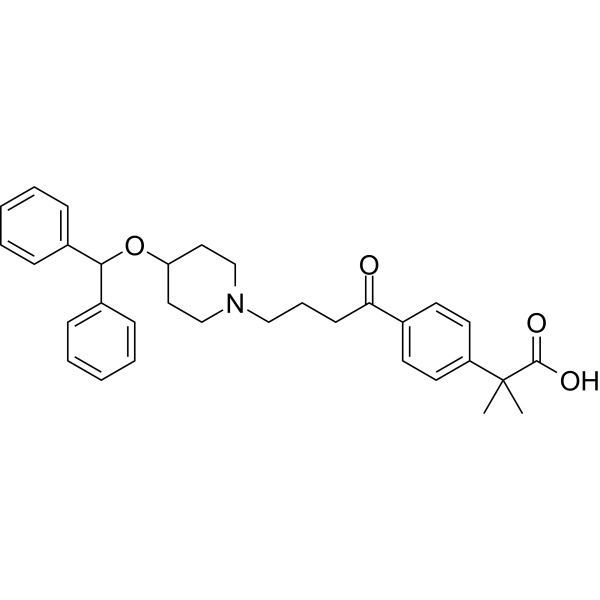
- HY-W042191
-
|
|
Fungal
Apoptosis
Caspase
Bcl-2 Family
MDM-2/p53
PARP
|
Infection
Cancer
|
|
Oxychloroaphine could be isolated from the bacterium Pantoea agglomerans naturally present in soil. Oxychloroaphine has broad-spectrum antifungal activity. Oxychloroaphine has cytotoxicity in a dose-dependent manner and induces apoptosis. Oxychloroaphine can be used in research of cancer .
|
-

- HY-101960A
-
|
AG-183
|
EGFR
|
Others
|
|
Tyrphostin A51 is a potent protein tyrosine kinase (PTK) inhibitor. Tyrphostin A51 inhibits the volume-dependent release of [ 3H]taurine in a dose-dependent manner. Tyrphostin A51 markedly reduces cellular tyrosyl phosphorylation level. Tyrphostin A51 inhibits both basal and EGF-induced human bone cell proliferation .
|
-

- HY-139342
-
|
|
CDK
|
Cancer
|
|
CDK7-IN-4 (compound I) is a potent CDK7 (Cyclin-dependent kinase 7) inhibitor. CDK7-IN-4 shows anticancer activity. CDK7-IN-4 inhibits the in vitro growth of cancer cell lines from a variety of histologies including colon , breast , lung , ovary and stomach , in a dose dependent manner .
|
-
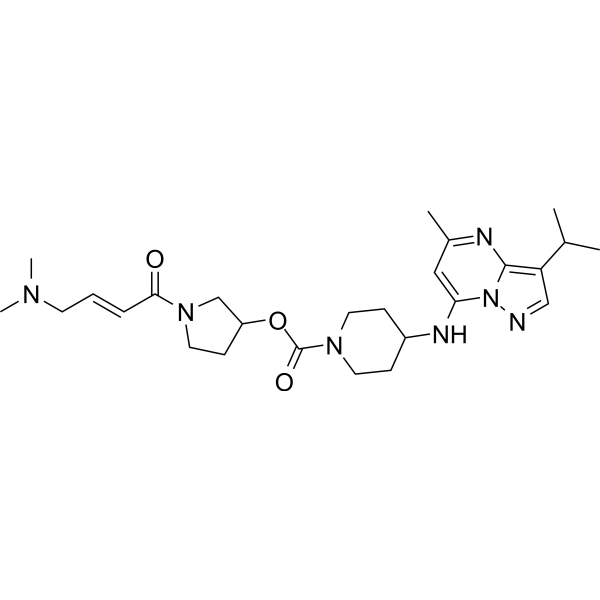
- HY-N0407
-
|
6'-Cinnamoylcatalpol
|
STAT
|
Inflammation/Immunology
|
|
Picroside I is the major ingredient of Picrorhiza scrophulariiflora. Picrorhiza scrophulariiflora is a high value medicinal herb due to rich source of hepatoprotective metabolites, Picroside-I and Picroside-II . Picroside I is a promising agent for the management of asthma. Picroside I reduces the inflammation significantly at its higher dose. Picroside I also downregulates pSTAT6 and GATA3 expressions. Picroside I dose-dependently increases the serum levels of IFN-γ .
|
-
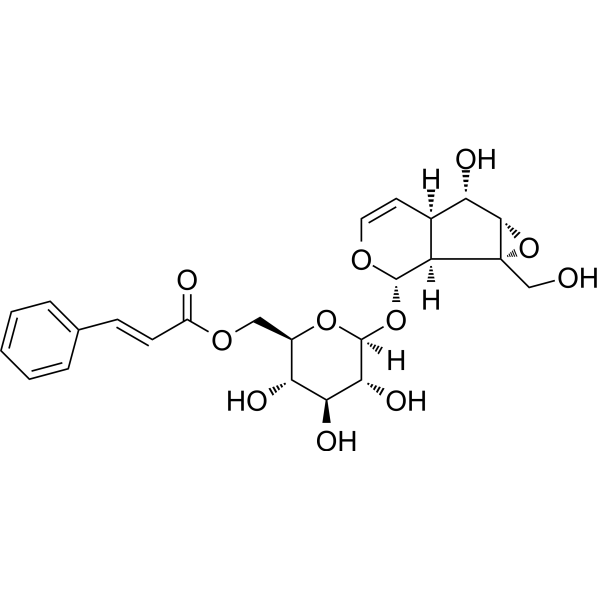
- HY-P1235A
-
|
Atrial Natriuretic Peptide (ANP) (1-28), human, porcine acetate
|
Endothelin Receptor
|
Cardiovascular Disease
Endocrinology
|
|
Carperitide acetate (Atrial Natriuretic Peptide (ANP) (1-28), human, porcine acetate) is a 28-amino acid hormone, that is normally produced and secreted by the human heart in response to cardiac injury and mechanical stretch. Carperitide acetate inhibits endothelin-1 secretion in a dose-dependent way.
|
-
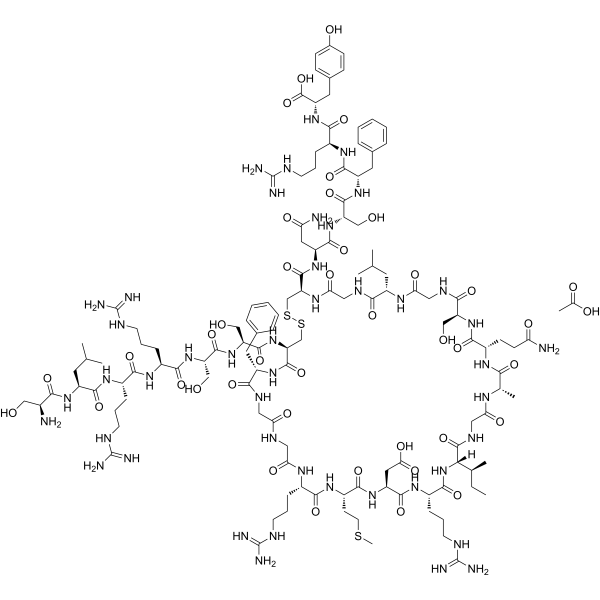
- HY-N6842
-
|
|
Others
|
Infection
Cancer
|
|
ArnicolideC is a sesquiterpene lactone isolated Centipeda minima . ArnicolideC exertes a cytotoxic effect on the panel of Nasopharyngeal carcinoma (NPC) cells, significantly inhibiting cell growth in a dose- and time- dependent manner. ArnicolideC also exhibits inhibitory effects on NPC proliferation .
|
-
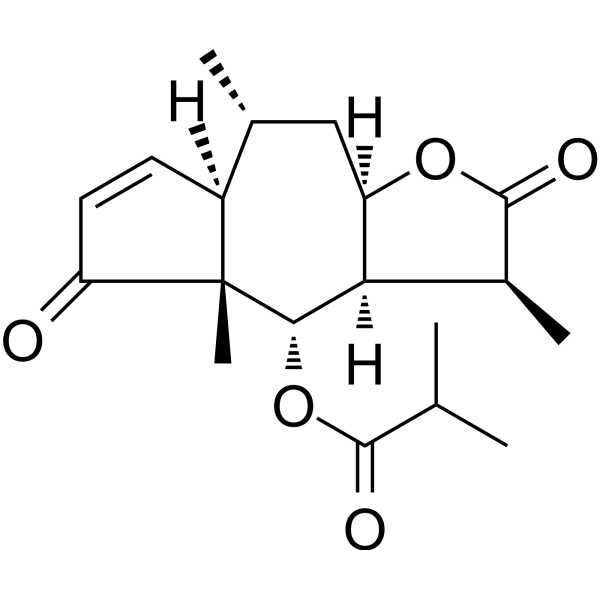
- HY-P1329
-
|
|
Opioid Receptor
|
Neurological Disease
|
|
CTOP is a potent and highly selective μ-opioid receptor antagonist. CTOP antagonizes the acute morphine-induced analgesic effect and hypermotility. CTOP enhances extracellular dopamine levels in the nucleus accumbens. CTOP dose-dependently enhances locomotor activity .
|
-

- HY-146681
-
|
|
PAK
|
Cancer
|
|
PAK1-IN-1 is a potent and selective PAK1 inhibitor with an IC50 of 9.8 nM. PAK1-IN-1 inhibits the migration and invasion of PAK1-related tumour cells in a dose-dependent manner .
|
-
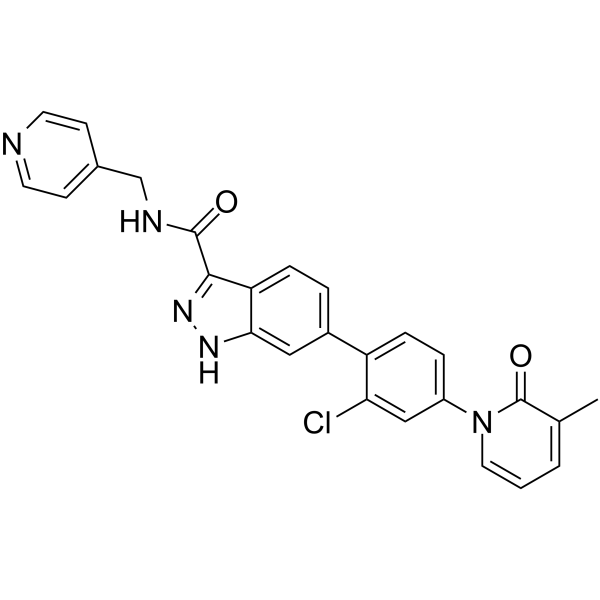
- HY-N4209
-
|
|
Others
|
Cardiovascular Disease
|
|
3α-Dihydrocadambine is a natural product isolated from the heartwoods of Anthocephalus cadamba.3α-Dihydrocadambine exhibits dose-dependent hypotensive and anti-hypertensive effects in anesthetized normotensive rats and in conscious spontaneously hypertensive rats .
|
-
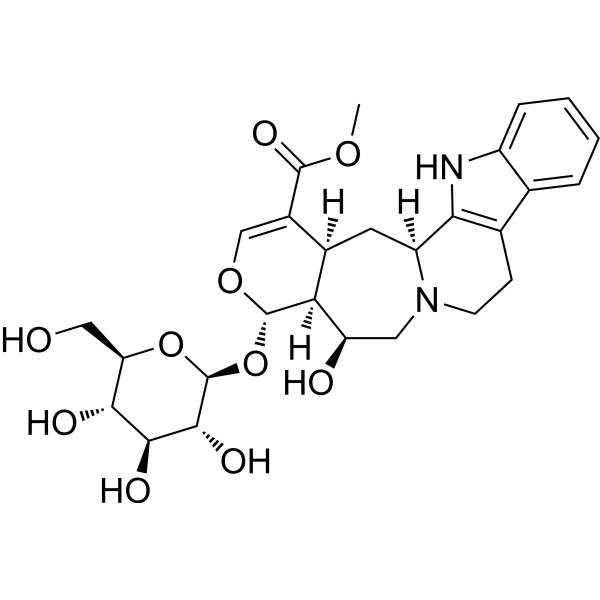
- HY-162153
-
|
|
FGFR
|
Cancer
|
|
CYY292 is an FGFR1 inhibitor that specifically targets the FGFR1/AKT/Snail pathway in GBM cells. CYY292 dose-dependently inhibits cancer cell proliferation, epithelial-mesenchymal transition, stemness, invasion, and migration in vitro .
|
-
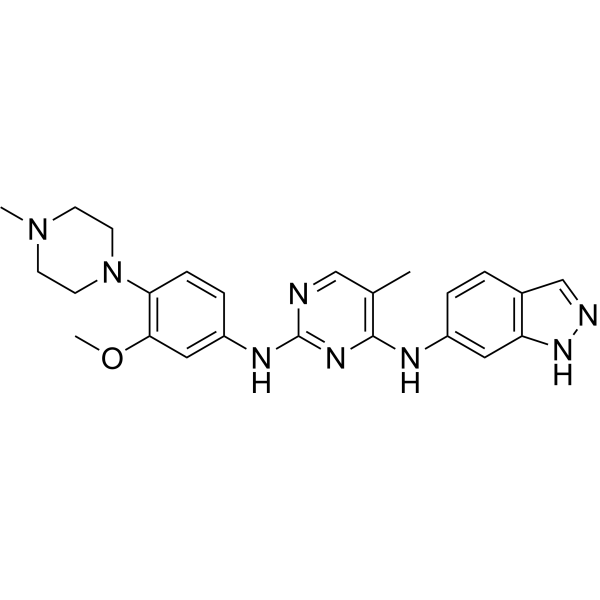
- HY-144818
-
|
|
Apoptosis
Microtubule/Tubulin
|
Cancer
|
|
Tubulin inhibitor 23 is a potent Tubulin inhibitor with an IC50 of 4.8 µM. Tubulin inhibitor 23 induces cell apoptosis. Tubulin inhibitor 23 shows antiangiogenic activity in a dose-dependent manner. Tubulin inhibitor 23 has the potential for the research of leukaemia .
|
-

- HY-16074
-
ATN-224
3 Publications Verification
Bis(choline)tetrathiomolybdate
|
SOD
|
Cancer
|
|
ATN-224 is an oral Cu 2+/Zn 2+-superoxide dismutase 1 (SOD1) inhibitor. ATN-224 inhibits SOD1 activity in endothelial cells, an effect that is dose dependent with an IC50 of 17.5±3.7 nM.
|
-

- HY-P5859
-
|
α-PMTX
|
Biochemical Assay Reagents
|
Neurological Disease
|
|
α-Pompilidotoxin (α-PMTX) is a neurotoxin that can be obtained from the venom of Anoplius safnariensis. α-Pompilidotoxin reversibly and dose-dependently enhances excitatory postsynaptic currents (EPSCs). α-Pompilidotoxin is a useful tool in the field of neuroscience research .
|
-
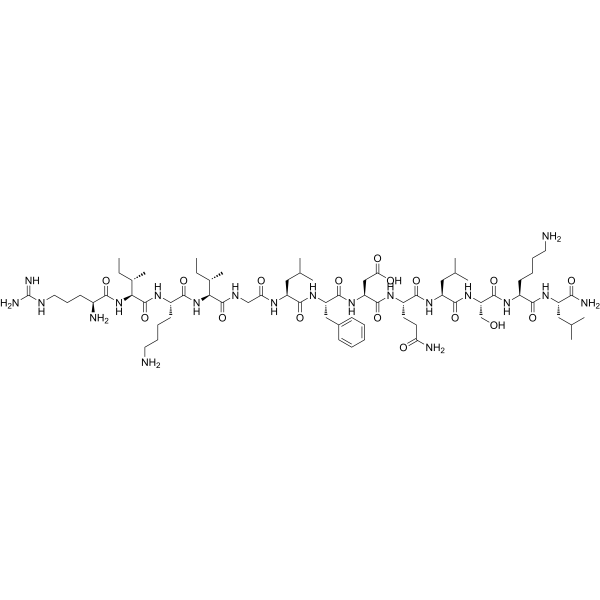
- HY-B1041
-
|
Pimagedine hydrochloride; GER-11; Aminoguanidinium chloride
|
NO Synthase
Apoptosis
|
Endocrinology
|
|
Aminoguanidine hydrochloride (Pimagedine hydrochloride) is an inhibitor of diamine oxidase and nitric oxide synthase. Aminoguanidine hydrochloride has a dose-dependent inhibitory effect on apoptosis induced by Doxorubicin (HY-15142). Aminoguanidine hydrochloride has antioxidant properties. Aminoguanidine hydrochloride can be used in diabetic nephropathy research .
|
-
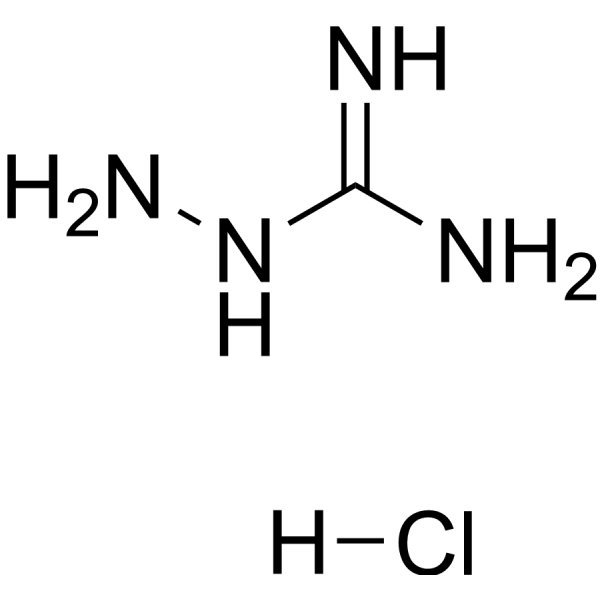
- HY-P1329A
-
|
|
Opioid Receptor
|
Neurological Disease
|
|
CTOP TFA is a potent and highly selective μ-opioid receptor antagonist. CTOP TFA antagonizes the acute analgesic effect and hypermotility. CTOP TFA enhances extracellular dopamine levels in the nucleus accumbens. CTOP TFA dose-dependently enhances locomotor activity .
|
-

- HY-139692
-
|
|
EAAT
|
Neurological Disease
|
|
EAAT2 activator 1 is the potent activator of excitatory amino acid transporter 2 (EAAT2). EAAT2 is the major glutamate transporter and functions to remove glutamate from synapses. EAAT2 activator 1 increases EAAT2 protein levels dose-dependently .
|
-
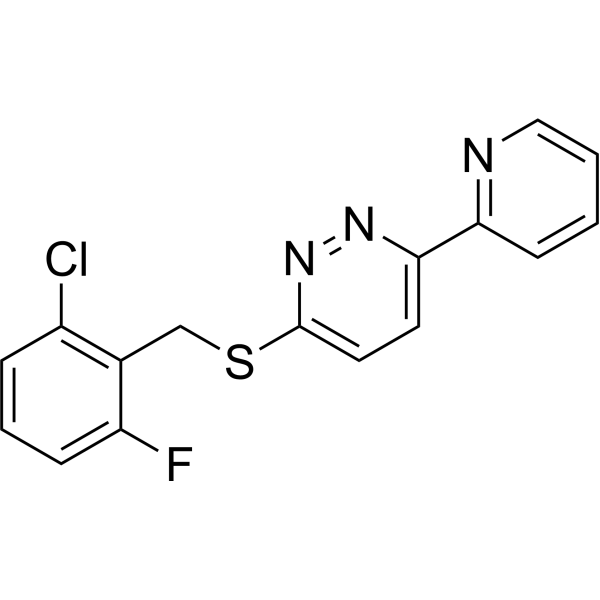
- HY-P0262A
-
|
|
Neuropeptide Y Receptor
|
Neurological Disease
Metabolic Disease
|
|
Galantide TFA is a reversible and non-specific galanin (GAL) receptor antagonist. Galantide TFA dose-dependently shows antagonism to galanin-induced K + conductance with an IC50 value of 4 nM. Galantide TFA can be used for the research of neurological disease and hormone metabolism research .
|
-

- HY-128431
-
|
|
Reactive Oxygen Species
|
Neurological Disease
Metabolic Disease
|
|
Arochlor 1254 is a polychlorinated biphenyl (PCB) mixture with biphenyl and 54% chlorine. Aroclor 1254 reduced cell viability and induced overproduction of intracellular reactive oxygen species in a dose-dependent manner. Arochlor 1254 exposure reduces calcium homeostasis, osteoblast differentiation and bone formation .
|
-

- HY-N11911
-
|
(-)-Verazine
|
Fungal
|
Infection
Neurological Disease
|
|
Verazine ((-)-Verazine) is an anti-Fungal Agent that can be found in the dried roots and rhizoma of Veratrum maackii Regel. Verazine causes DNA damage in the cerebellum and cerebral cortex of mice in a dose-dependent manner. Verazine can be used in the study of fungal infections and neurological diseases .
|
-
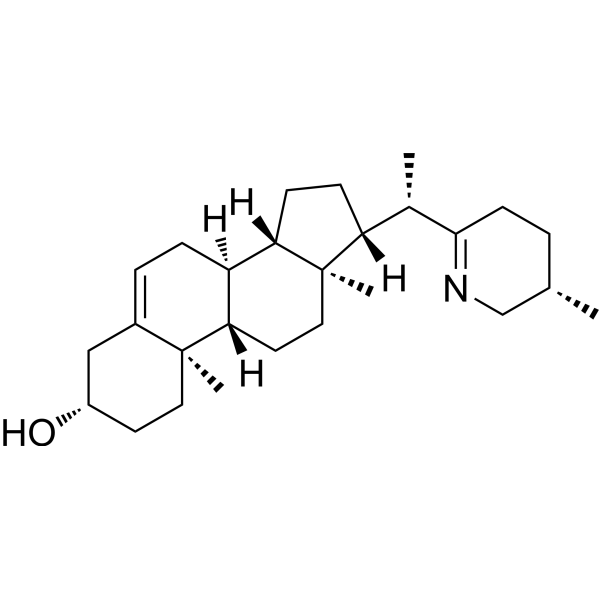
- HY-P10032A
-
-
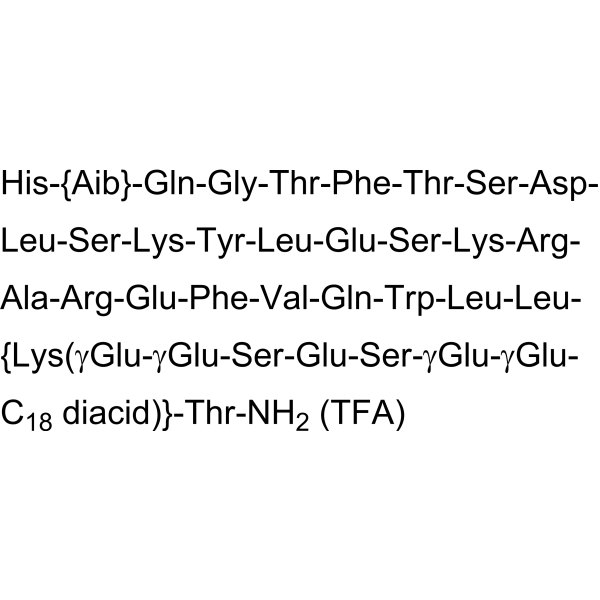
- HY-15297
-
|
OPC-8212
|
Phosphodiesterase (PDE)
|
Infection
Cardiovascular Disease
|
|
Vesnarinone (OPC-8212) is an orally active phosphodiesterase 3 (PDE3) inhibitor. Vesnarinone can increase in calcium flux and decrease in potassium flux. Vesnarinone shows dose-dependent positive inotropic activity. Vesnarinone can be used in heart failure research .
|
-
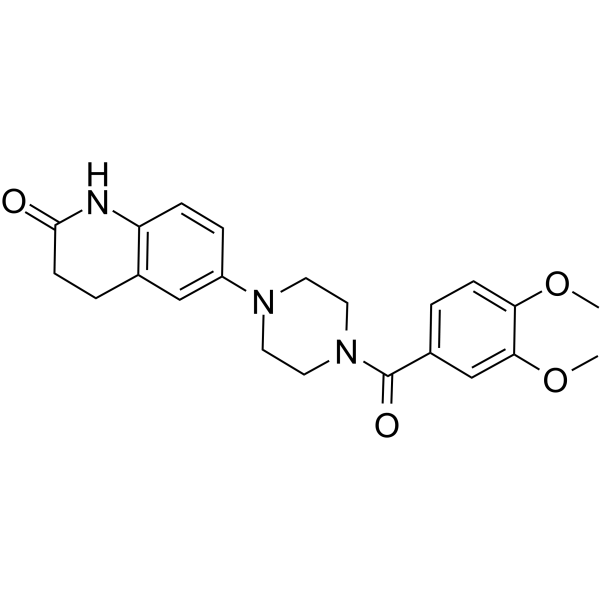
- HY-N5045
-
|
|
Others
|
Inflammation/Immunology
|
|
Jionoside A1 isolated from Radix Rehmanniae Praeparata displays dose dependent immune-enhancement activity and possesses moderate protective activities on H2O2-treated SH-SY5Y cells .
|
-
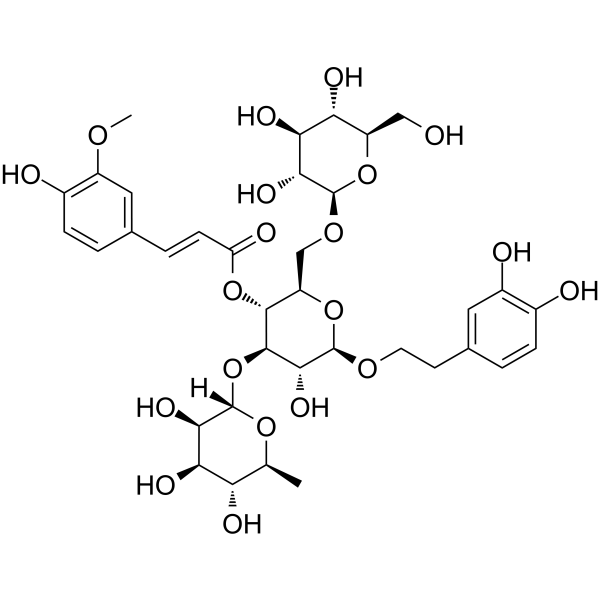
- HY-133130
-
|
|
MAGL
|
Neurological Disease
|
|
JNJ-42226314 is a competitive, highly selective and reversible non-covalent monoacylglycerol lipase (MAGL) inhibitor. JNJ-42226314 demonstrates dose-dependent enhancement of the major endocannabinoid 2-arachidonoylglycerol (2-AG) as well as efficacy in models of neuropathic and inflammatory pain .
|
-
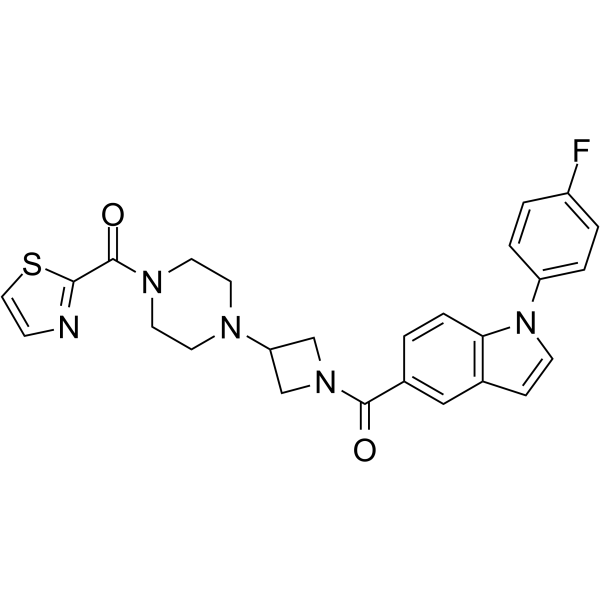
- HY-144448
-
|
|
FAK
Apoptosis
|
Cancer
|
|
FAK-IN-2 is a potent and orally active focal adhesion kinase (FAK) inhibitor, with anticancer activity (FAK IC50= 35 nM). FAK-IN-2 covalently inhibits the autophosphorylation of FAK in a dose-dependent manner, and inhibits the clone formation and migration of tumor cells, inducing apoptosis .
|
-
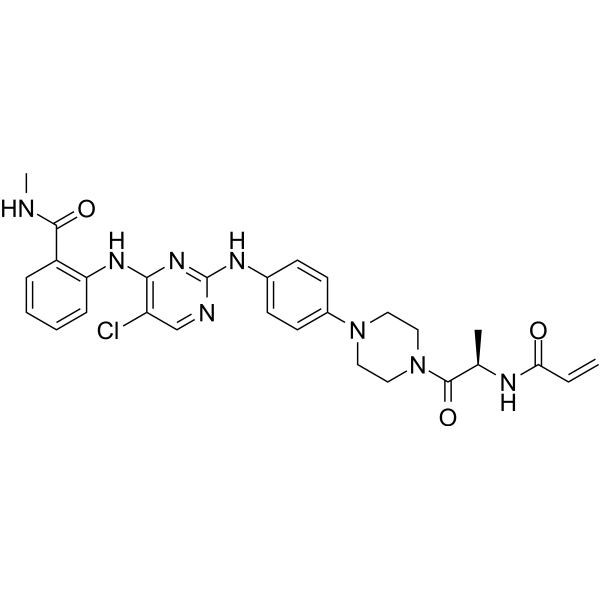
- HY-121725
-
|
|
STAT
|
Cancer
|
|
MM-206, a STAT3 activity inhibitor, potently inhibits the STAT3 SH2 domain-phosphopeptide interaction with IC50 of 1.2 μM. MM-206 demonstrates dose-dependent induction of apoptosis in acute myeloid leukemia (AML) cell lines .
|
-

- HY-118131
-
|
|
Ser/Thr Protease
|
Infection
|
|
PKR-IN-C51(compound 51) is an ATP-competitive double-stranded RNA-activated protein kinase (PKR) inhibitor with an IC50 of 9 μM. PKR-IN-C51 inhibits intracellular PKR activation in a dose-dependent manner in primary mouse macrophages .
|
-
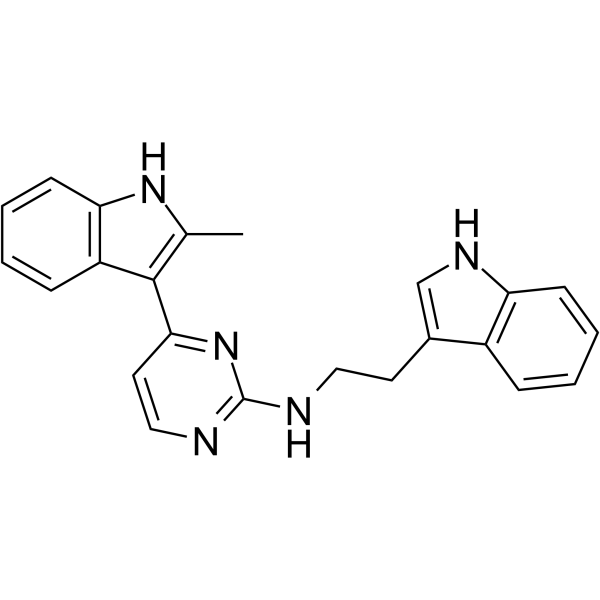
- HY-15480
-
|
JAK2 Inhibitor V; Z3
|
JAK
|
Cancer
|
|
NSC 42834 (JAK2 Inhibitor V), a novel specific inhibitor of Jak2, inhibits Jak2-V617F and Jak2-WT autophosphorylation in a dose-dependent manner but was not cytotoxic to cells at concentrations that inhibited kinase activity.
|
-
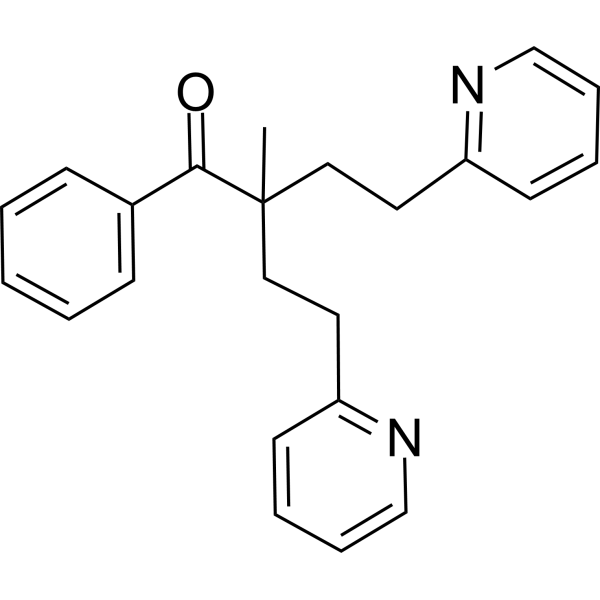
- HY-145846
-
|
|
NO Synthase
Interleukin Related
|
Inflammation/Immunology
|
|
iNOs-IN-1 (YPW) is a potent inducible nitric oxide synthase (iNOS) inhibitor. iNOs-IN-1 can significantly inhibit the expression of IL-6 and iNOS, as well as reduce LPS-induced NO generation with dose-dependent manner in mouse macrophages. Anti-inflammatory effects .
|
-

- HY-126910
-
|
|
Opioid Receptor
|
Metabolic Disease
|
|
Mesyl Salvinorin B is a potent and selective kappa opioid receptor (KOP-r) agonist. Mesyl Salvinorin B prevents the ADE (Alcohol deprivation effect) in mice. Mesyl Salvinorin B dose-dependently reduces alcohol intake and preference in CED (chronic escalation drinking) mice .
|
-
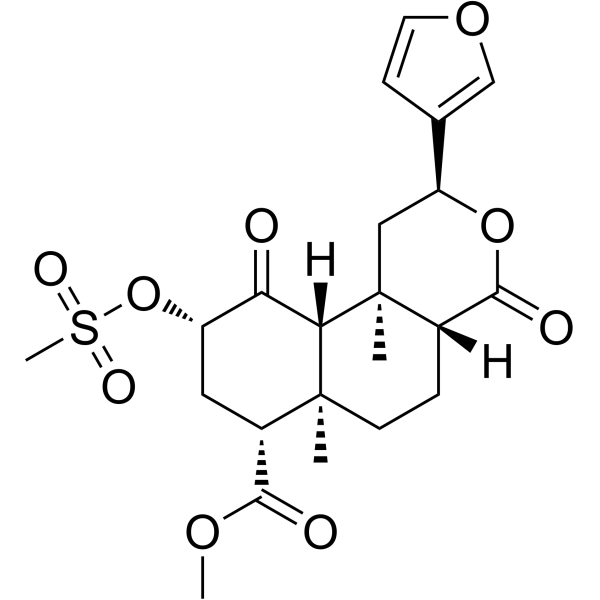
- HY-156466
-
|
|
JAK
|
Inflammation/Immunology
|
|
QL-1200186 is anorally activeand selective inhibitor ofTYK2. Oral administration of QL-1200186, dose-dependently inhibitsinterferon-γ(IFNγ) production afterinterleukin-12(IL-12) challenge and significantly ameliorates skin lesions in psoriatic mice .
|
-

- HY-157508
-
|
|
p97
|
Others
|
|
VCP Activator 1 is a VCP activator that dose-dependently stimulates VCP ATPase activity. VCP Activator 1 binds an allosteric pocket near the C-terminus. In addition, VCP Activator 1 binding site can also be occupied by a phenylalanine residue in the VCP C-terminal tail .
|
-

- HY-101960
-
|
(Z)-AG-183
|
EGFR
|
Others
|
|
(Z)-Tyrphostin A51 is the Z configuration of Lanoconazole A51. Tyrphostin A51 is a potent protein tyrosine kinase (PTK) inhibitor. Tyrphostin A51 inhibits the volume-dependent release of [ 3H]taurine in a dose-dependent manner. Tyrphostin A51 markedly reduces cellular tyrosyl phosphorylation level. Tyrphostin A51 inhibits both basal and EGF-induced human bone cell proliferation .
|
-

- HY-N5054
-
|
|
TNF Receptor
|
Inflammation/Immunology
|
|
(R)-5,7-Dimethoxyflavanone shows potent antimutagenic activity against MeIQ mutagenesis in Ames test using the S. typhimurium TA100 and TA98 strains . And (R)-5,7-Dimethoxyflavanone significantly and dose-dependently inhibits the inflammatory mediato .
|
-
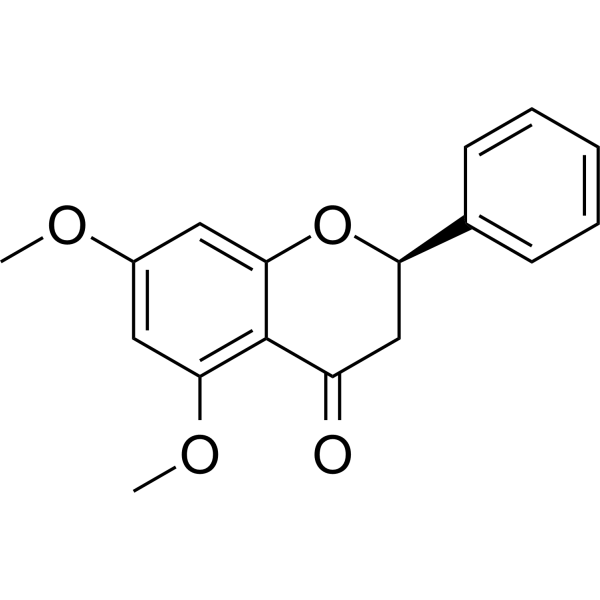
- HY-106200
-
|
|
Lipoxygenase
|
Inflammation/Immunology
|
|
CJ-13,610, a nonredox-type 5-LO inhibitor, dose dependently suppresses 5-LO product formation in ionophore A23187-stimulated PMNL in the absence of exogenous AA with an IC50 of about 70 nM . PMNL: polymorphonuclear leukocytes; AA: arachidonic acid
|
-
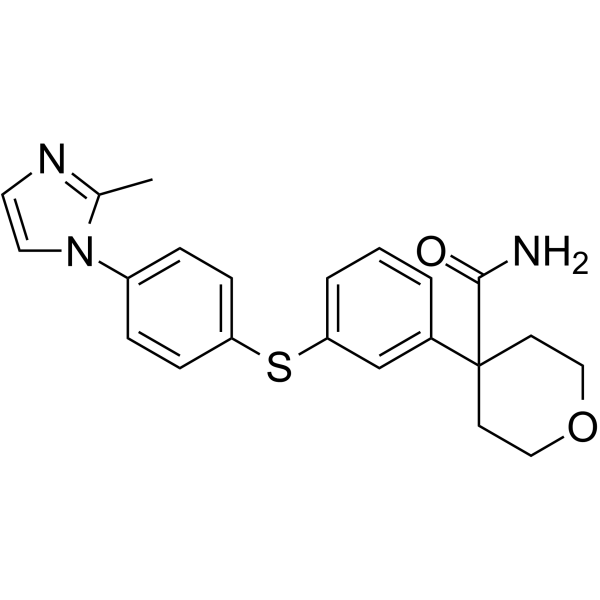
- HY-146433
-
|
|
Apoptosis
|
Cancer
|
|
Anticancer agent 55 is a potent anticancer agent. Anticancer agent 55 shows anticancer activity via reducing the cell viability and cell migration in a dose-dependent manner. Anticancer agent 55 induces apoptosis. Anticancer agent 55 has the potential for the research of prostate cancer and breast cancer .
|
-
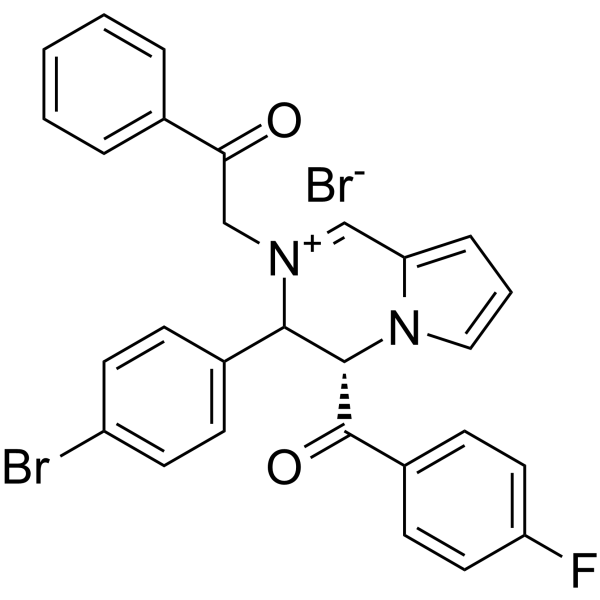
- HY-152524
-
|
|
Androgen Receptor
|
Cancer
|
|
Androgen receptor antagonist 7 is an effective androgen receptor (AR) antagonist with an IC50 value of 1.18 µM. Androgen receptor antagonist 7 has biological activity in vitro and inhibits the expression of AR target in a time and dose dependent manner with an GI50 value of 7.9 µM .
|
-

- HY-157029S
-
|
|
Ras
|
Cancer
|
|
KRASG12D-IN-1 (compound 22) is a KRAS G12D Inhibitor. KRASG12D-IN-1 has dose-dependent anti-tumor efficacy in the AsPC-1 xenograft mouse models with a tumor growth inhibition .
|
-
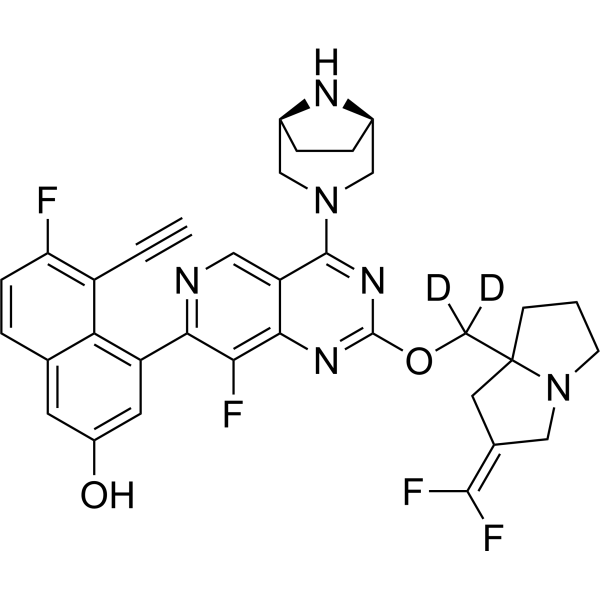
- HY-157031S
-
|
|
Ras
|
Cancer
|
|
KRASG12D-IN-2 (compound 28) is a KRAS G12D Inhibitor. KRASG12D-IN-1 has dose-dependent anti-tumor efficacy in the AsPC-1 xenograft mouse models with a tumor growth inhibition .
|
-
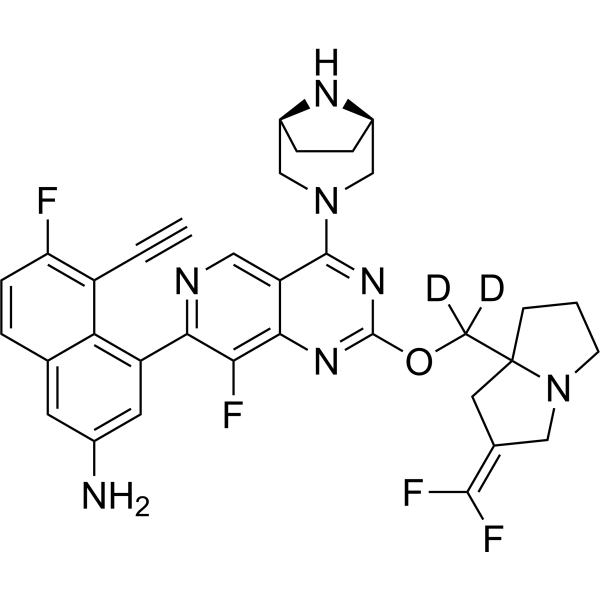
- HY-B0094
-
|
Qinghaosu; NSC 369397
|
HCV
Parasite
Akt
Ferroptosis
|
Infection
Neurological Disease
Cancer
|
|
Artemisinin (Qinghaosu), a sesquiterpene lactone, is an anti-malarial agent isolated from the aerial parts of Artemisia annua L. plants . Artemisinin inhibits AKT signaling pathway by decreasing pAKT in a dose-dependent manner. Artemisinin reduces cancer cell proliferation, migration, invasion, tumorigenesis and metastasis and has neuroprotective effects .
|
-

- HY-B0162A
-
|
|
HCN Channel
|
Cardiovascular Disease
Endocrinology
Cancer
|
|
Ivabradine hydrochloride is a potent and orally active HCN (hyperpolarization-activated cyclic nucleotide-gated) channel blocker that inhibits the cardiac pacemaker current (If). Ivabradine hydrochloride reduces dose-dependently heart rate without modification of blood pressure. Ivabradine hydrochloride shows anticonvulsant, anti-ischaemic and anti-anginal activity .
|
-

- HY-10119
-
|
SCH 530348
|
Protease Activated Receptor (PAR)
|
Cardiovascular Disease
|
|
Vorapaxar (SCH 530348), an antiplatelet agent, is a selective, orally active, and competitive thrombin receptor protease-activated receptor (PAR-1) antagonist (Ki=8.1 nM). Vorapaxar (SCH 530348) inhibits thrombin receptor-activating peptide (TRAP)-induced platelet aggregation in a dose-dependent manner .
|
-
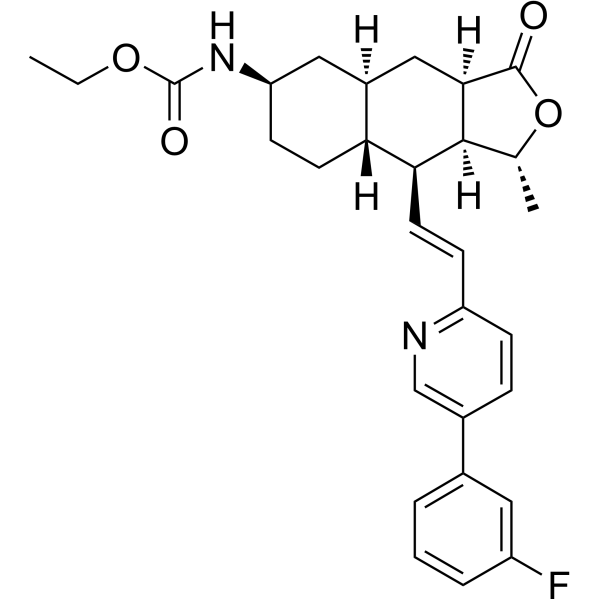
- HY-144127
-
|
|
Androgen Receptor
|
Cancer
|
|
AR antagonist 3 is a potent and selective androgen receptor (AR) antagonist with an IC50 of 0.47 µM. AR antagonist 3 exhibits a dose-dependent decrease of the FRET signal (IC50= 18.05 μM). AR antagonist 3 shows effective inhibition on tumor growth when administered intratumorally .
|
-
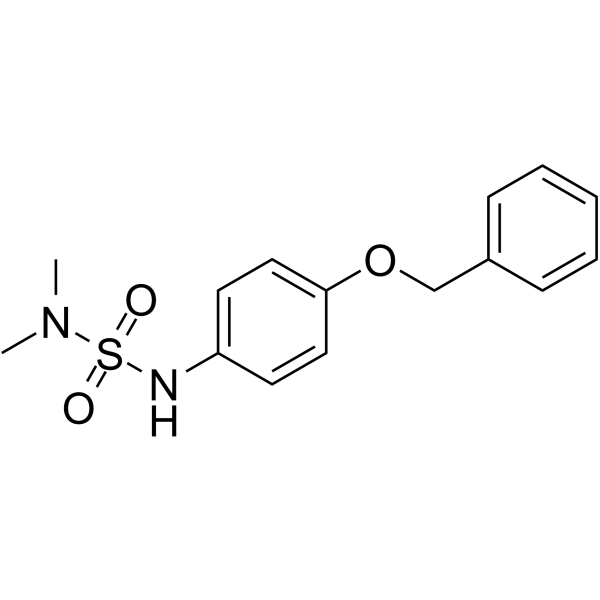
- HY-146260
-
|
|
PI3K
|
Cancer
|
|
NVP-CLR457 (compound 40) is an orally active, potent and balanced pan-class I PI3K inhibitor. NVP-CLR457 shows a clear dose-dependent PK/PD/efficacy relationship. NVP-CLR457 has antitumor activity .
|
-
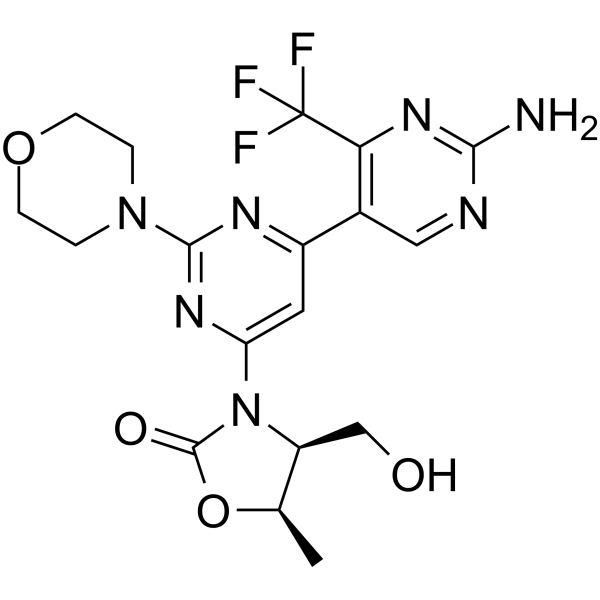
- HY-B0162
-
|
|
HCN Channel
|
Cardiovascular Disease
|
|
Ivabradine is a potent and orally active HCN (hyperpolarization-activated cyclic nucleotide-gated) channel blocker that inhibits the cardiac pacemaker current (If). Ivabradine reduces dose-dependently heart rate without modification of blood pressure. Ivabradine shows anticonvulsant, anti-ischaemic and anti-anginal activity .
|
-
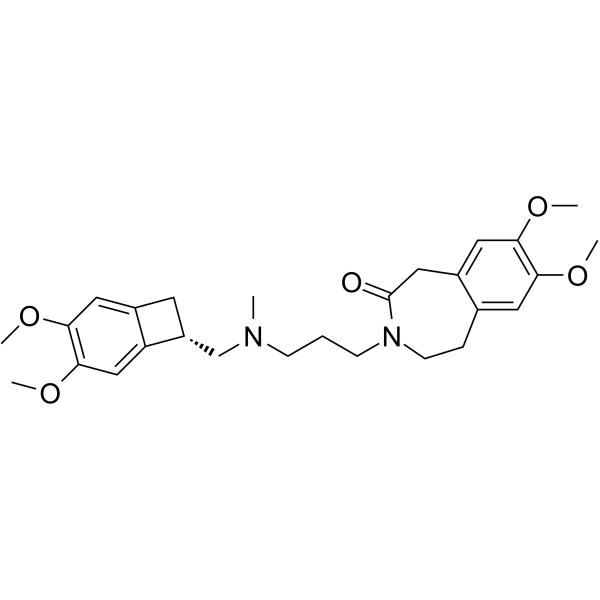
- HY-151926
-
|
|
Enterovirus
|
Infection
|
|
Antiviral agent 24 is a potent antiviral agent with EC50 values of 0.101, 19.9, 91.2 µM for EV71, CVA21, EV68, respectively. Antiviral agent 24 inhibits METTL3/METTL14 activity in a dose-dependent manner .
|
-

- HY-156500
-
|
|
ICMT
|
Cancer
|
|
ICMT-IN-1 (compound 75) is an inhibitor of ICMT (IC50=0.0013 μM). ICMT-IN-1 dose-dependently induces ICMT accumulation in the cytoplasm of HCT-116 cells and inhibits the proliferation of multiple cancer cell lines expressing K-Ras and N-Ras .
|
-
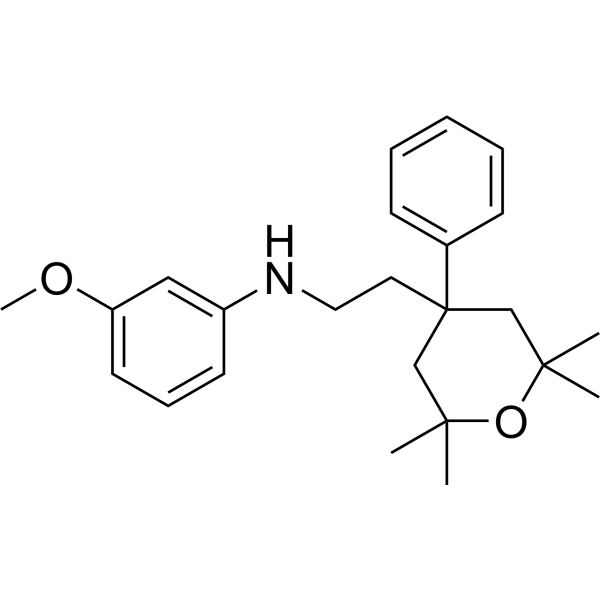
- HY-149705
-
|
|
ICMT
|
Cancer
|
|
ICMT-IN-7 (compound 74) is an inhibitor of ICMT (IC50=0.015 μM). ICMT-IN-7 dose-dependently induces ICMT accumulation in the cytoplasm of HCT-116 cells and inhibits the proliferation of multiple cancer cell lines expressing K-Ras and N-Ras .
|
-
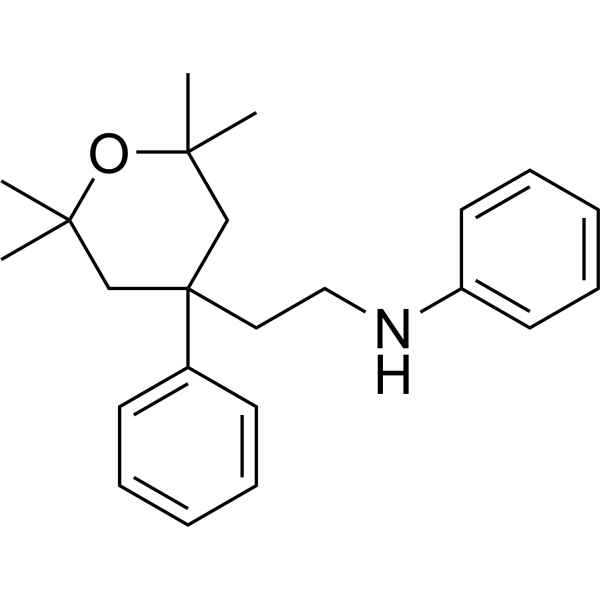
- HY-111143
-
|
|
nAChR
|
Metabolic Disease
|
|
SCH-900271 is an orally active, potent nicotinic acid receptor (NAR) agonist with an EC50 of 2 nM in the hu-GPR109a assay. SCH-900271 exhibits dose-dependent inhibition of plasma free fatty acid (FFA). SCH-900271 has an improved therapeutic window to flushing .
|
-
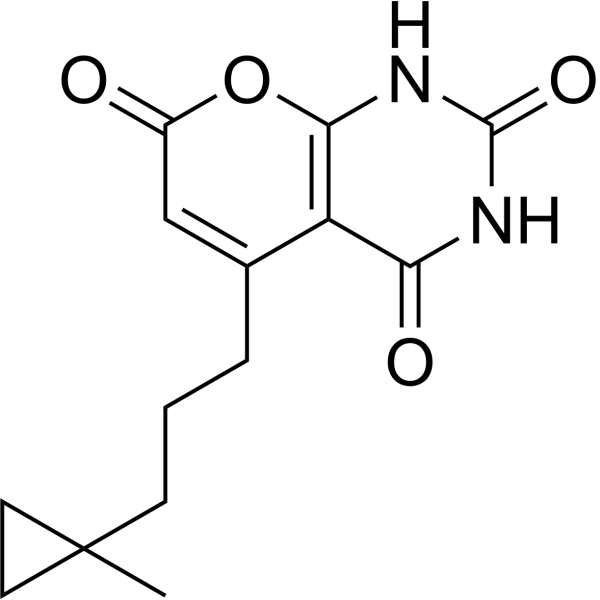
- HY-163172
-
|
|
Others
|
Neurological Disease
|
|
Miro1 Reducer is a small molecule that can repair this defect of Miro1 in Parkinson's disease (PD) fibroblasts. Miro1 Reducer reduces the delayed mitophagy phenotype in PD fibroblasts. Miro1 Reducer reduces Miro1 protein levels in dose-dependent manner (IC50 = 7.8 mM) .
|
-
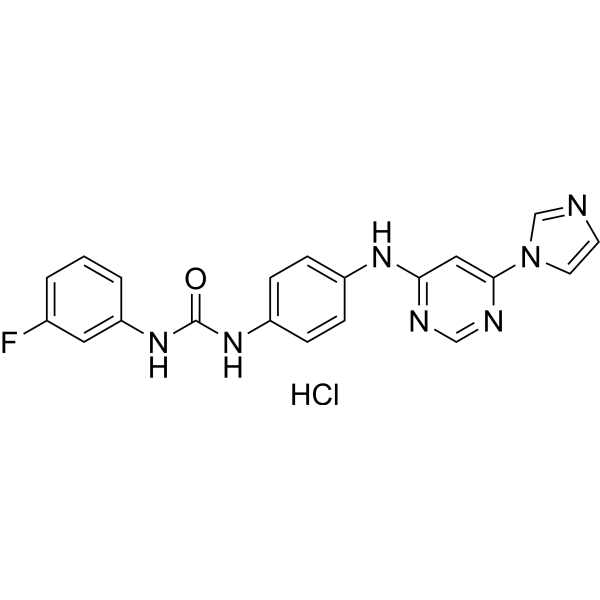
- HY-N0262
-
|
3'-Deoxyadenosine
|
MMP
Bacterial
Autophagy
Antibiotic
|
Infection
Inflammation/Immunology
Cancer
|
|
Cordycepin (3'-Deoxyadenosine) is a nucleoside derivative and inhibits IL-1β-induced MMP-1 and MMP-3 expression in rheumatoid arthritis synovial fibroblasts (RASFs) in a dose-dependent manner . Cordycepin kills Mycobacterium tuberculosis through hijacking the bacterial adenosine kinase .
|
-
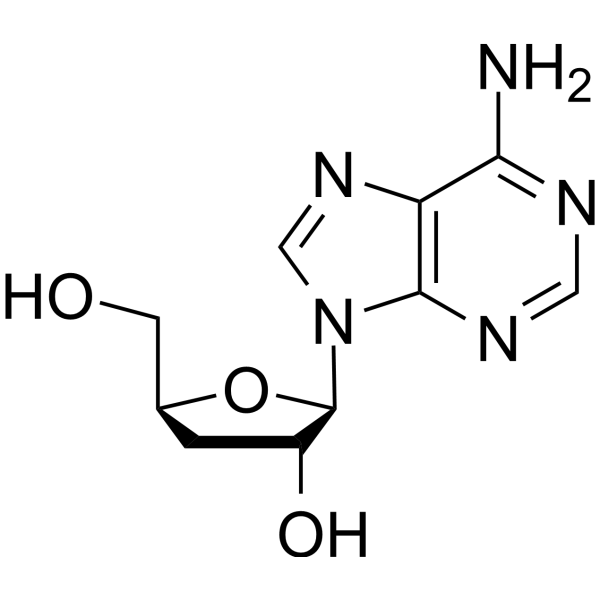
- HY-10119A
-
|
SCH 530348 sulfate
|
Protease Activated Receptor (PAR)
|
Cardiovascular Disease
|
|
Vorapaxar sulfate (SCH 530348 sulfate), an antiplatelet agent, is a selective, orally active, and competitive thrombin receptor protease-activated receptor (PAR-1) antagonist (Ki=8.1 nM). Vorapaxar sulfate inhibits thrombin receptor-activating peptide (TRAP)-induced platelet aggregation in a dose-dependent manner .
|
-
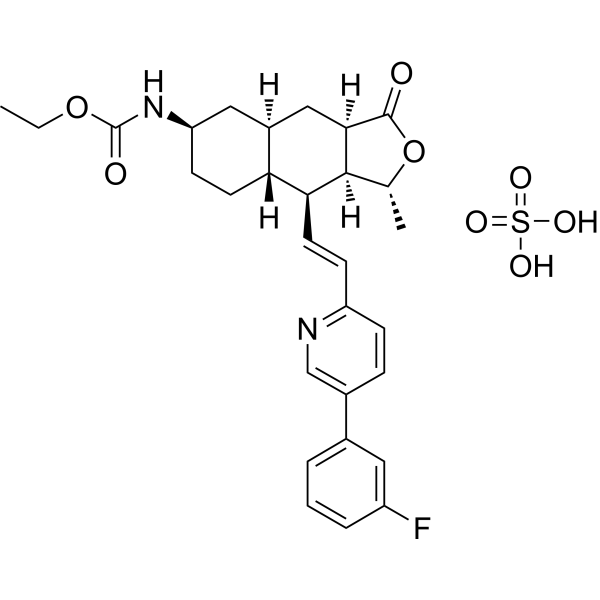
- HY-P1440A
-
|
|
Potassium Channel
|
|
|
BeKm-1 TFA is a potent and selective KV11.1 (hERG) channel blocker. BeKm-1 TFA is selective for KV11.1 over a panel of 14 other potassium channels. BeKm-1 TFA dose-dependently prolongs QTc interval in isolated rabbit heart.
|
-
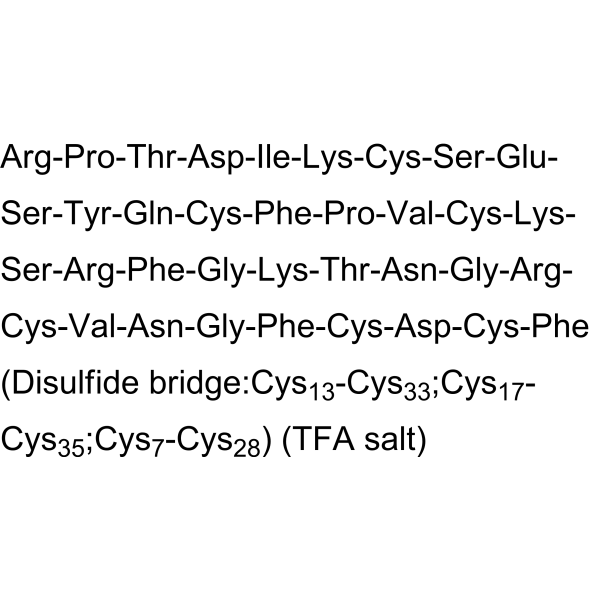
- HY-129421
-
|
|
PACAP Receptor
|
Neurological Disease
Inflammation/Immunology
|
|
PA-9 is a pituitary adenylate cyclase-activating polypeptide (PACAP) type I (PAC1) receptor antagonist. PA-9 dose dependently inhibits PACAP-induced cAMP elevation with an IC50 of 5.6 nM. PA-9 can be used for the research of neuropathic and/or inflammatory pain .
|
-
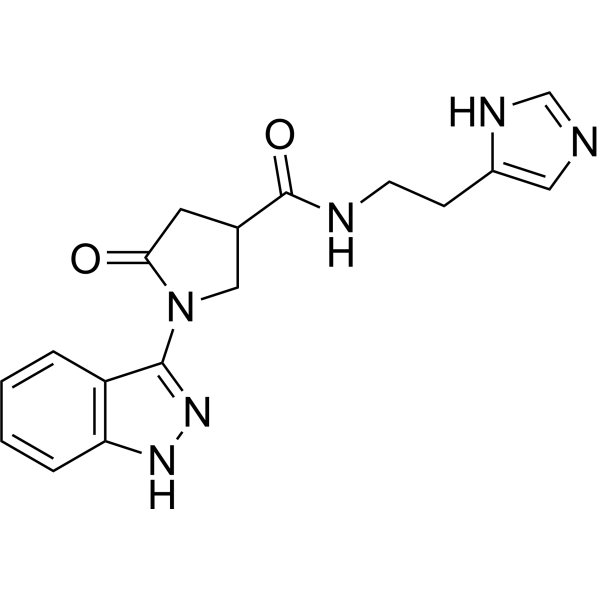
- HY-146782
-
|
|
EGFR
|
Cancer
|
|
EGFR-IN-49 is a potent and selective EGFR inhibitor with IC50s of 65.0 nM and 13.6 nM for EGFR T790M and EGFR T790M/L858R, respectively. EGFR-IN-49 induces late apoptosis in a dose-dependent manner .
|
-
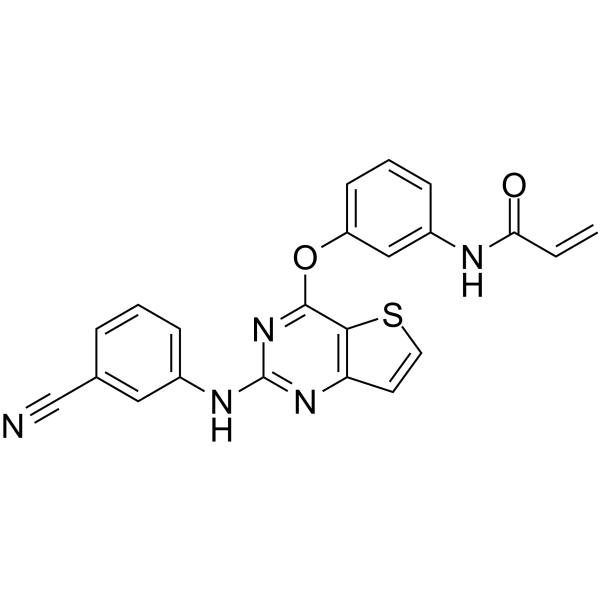
- HY-N8481
-
|
3,6-DHF
|
Apoptosis
|
Cancer
|
|
3,6-Dihydroxyflavone is an anti-cancer agent. 3,6-Dihydroxyflavone dose- and time-dependently decreases cell viability and induces apoptosis by activating caspase cascade, cleaving poly (ADP-ribose) polymerase (PARP). 3,6-Dihydroxyflavone increases intracellular oxidative stress and lipid peroxidation .
|
-
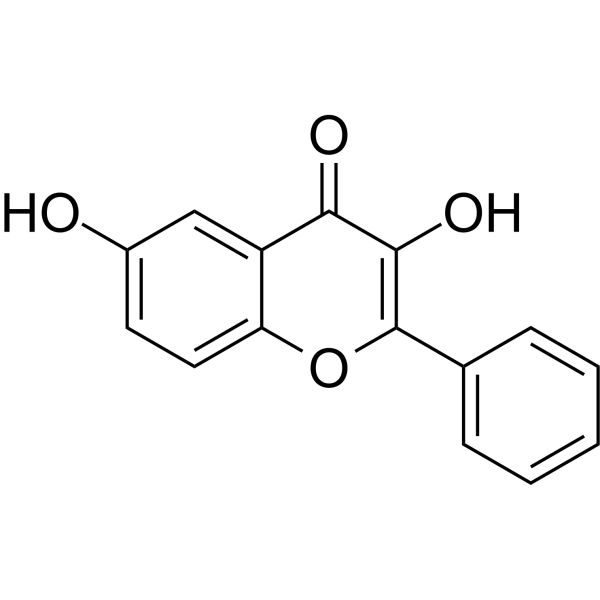
- HY-N7934
-
|
(-)-Trachelogenin
|
HCV
|
Infection
Neurological Disease
Inflammation/Immunology
|
|
Trachelogenin ((-)-Trachelogenin) is an HCV entry inhibitor without genotype specificity, and with low cytotoxicity. Trachelogenin inhibits HCVcc infection and HCVpp cell entry in a dose-dependent manner with an IC50 of 0.325 and 0.259 μg/mL in HCVcc and HCVpp models, respectively. Trachelogenin exhibits effective antiviral, anti-inflammatory and analgesic effects .
|
-
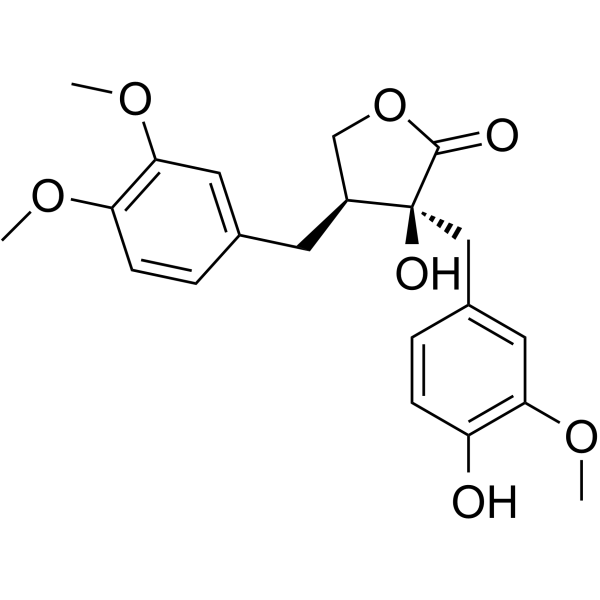
- HY-152535
-
|
|
Others
|
Infection
Inflammation/Immunology
|
|
ATV041 is an orally active Ibuprofen (HY-78131) and nucleotide analogue. ATV041 improves oral pharmacokinetic (PK) profile and tissue distribution with anti-mouse hepatitis virus (MHV) activity. ATV041 reduces viral load, tissue damage and virus-induced inflammation in a dose-dependent manner .
|
-
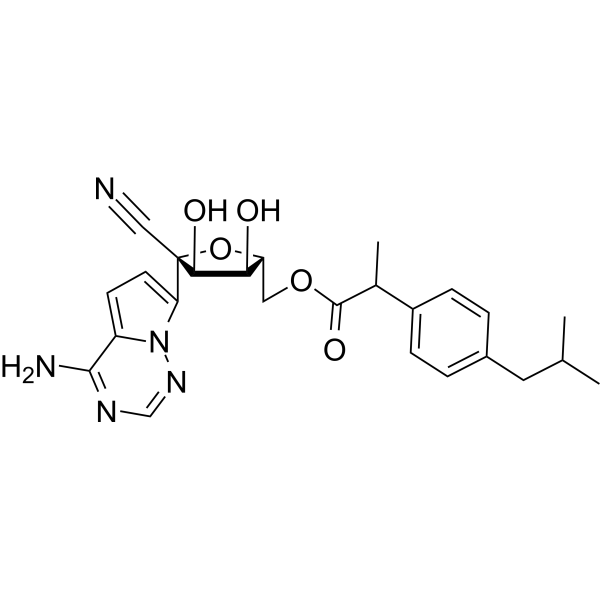
- HY-154995
-
|
|
Others
|
Infection
|
|
N-4′-(p-Trifluoromethylphenyl)butyl-DAB (compound 5g) is an agonit of lysosomal acid α-glucosidase (GAA). N-4′-(p-Trifluoromethylphenyl)butyl-DAB increases intracellular GAA activities dose-dependently, in Pompe patient's fibroblasts with the M519V mutation .
|
-
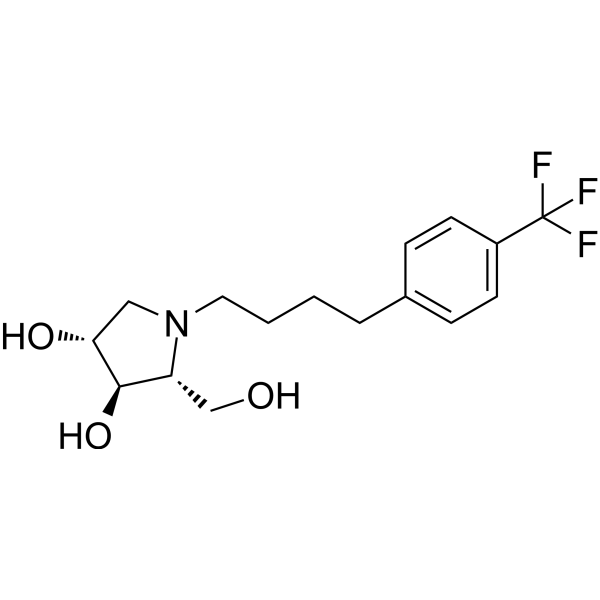
- HY-124022
-
|
|
HDAC
|
Others
|
|
APHA Compound 8 (Compound 4) is a histone deacetylase (HDAC) inhibitor. APHA Compound 8 has antimouse HDAC1 activity with an IC50 value of 0.78 μM. APHA Compound 8, as antiproliferative and cytodifferentiating agent on MEL cells, shows dose-dependent growth inhibition and hemoglobin accumulation effects .
|
-

- HY-B0607
-
|
NTBC; Nitisone; SC0735
|
HPPD
|
Metabolic Disease
|
|
Nitisinone is an orally active, competitive and reversible 4-hydroxyphenylpyruvate dioxygenase (4-HPPD) inhibitor with an IC50 of 173 nM. Nitisinone promotes tyrosine accumulation in a dose-dependent manner. nitisinone can be used in studies of hereditary tyrosinemia type 1 (HT-1) (a rare genetic disorder) and albinism .
|
-
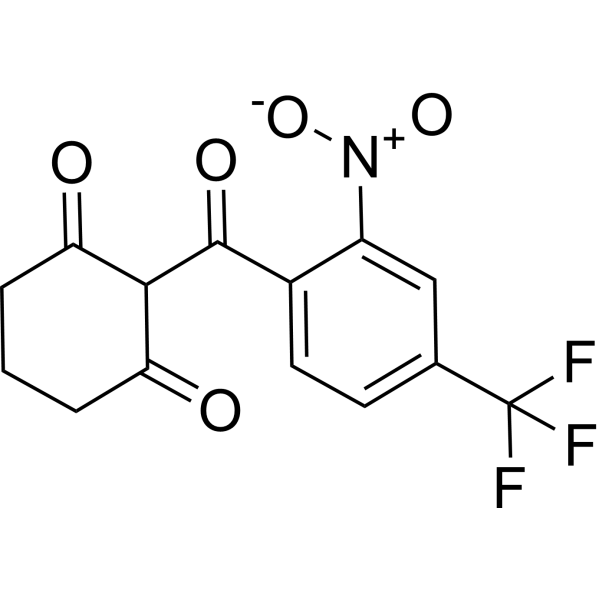
- HY-P1235
-
|
Atrial Natriuretic Peptide (ANP) (1-28), human, porcine
|
Endothelin Receptor
|
Cardiovascular Disease
Endocrinology
|
|
Carperitide (Atrial Natriuretic Peptide (ANP) (1-28), human, porcine) is a 28-amino acid hormone, that is normally produced and secreted by the human heart in response to cardiac injury and mechanical stretch. Carperitide (Atrial Natriuretic Peptide (ANP) (1-28), human, porcine) inhibits endothelin-1 secretion in a dose-dependent way.
|
-
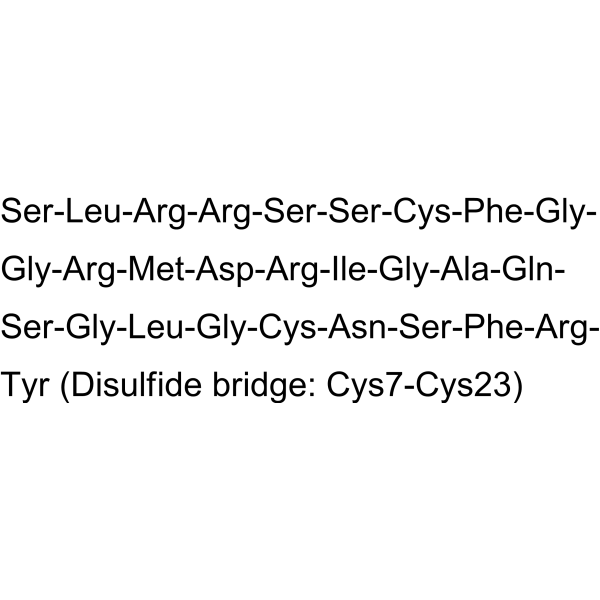
- HY-121356S1
-
|
|
Isotope-Labeled Compounds
Histamine Receptor
|
Endocrinology
Cancer
|
|
Carebastine-d5 Methyl Ester is the deuterium labeled Carebastine. Carebastine is the active metabolite of Ebastine. Carebastine is a histamine H1 receptor antagonist. Carebastine inhibits VEGF-induced HUVEC and HPAEC proliferation, migration and angiogenesis in a dose-dependent manner[1]. Carebastine suppresses the expression of macrophage migration inhibitory factor[2].
|
-

- HY-121356S
-
|
|
Isotope-Labeled Compounds
Histamine Receptor
|
Endocrinology
Cancer
|
|
Carebastine-d5 is the deuterium labeled Carebastine. Carebastine is the active metabolite of Ebastine. Carebastine is a histamine H1 receptor antagonist. Carebastine inhibits VEGF-induced HUVEC and HPAEC proliferation, migration and angiogenesis in a dose-dependent manner[1]. Carebastine suppresses the expression of macrophage migration inhibitory factor[2].
|
-
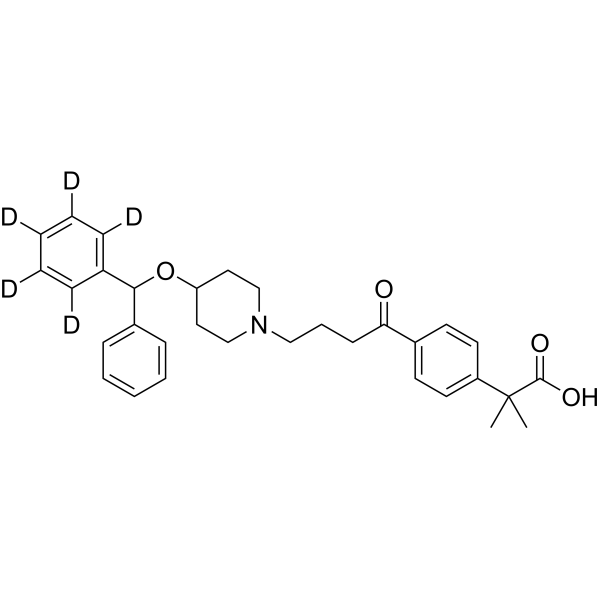
- HY-N6745
-
|
|
Na+/K+ ATPase
Apoptosis
|
Infection
Cardiovascular Disease
|
|
Citreoviridin, a toxin from Penicillium citreoviride NRRL 2579, inhibits brain synaptosomal Na +/K +-ATPase whereas in microsomes, both Na +/K +-ATPase and Mg 2+-ATPase activities are significantly stimulated in a dose-dependent manner . Citreoviridin inhibits cell proliferation and enhances apoptosis of human umbilical vein endothelial cells .
|
-
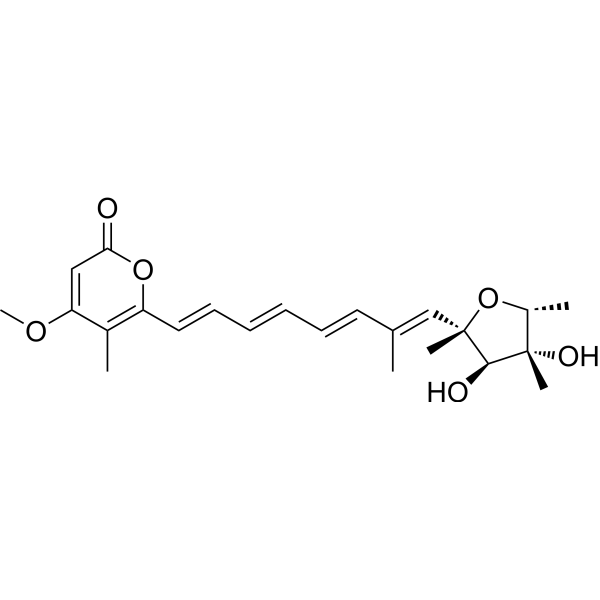
- HY-102051
-
|
|
IAP
|
Cancer
|
|
XIAP/cIAP1 antagonist-1 is a potent and orally active XIAP/cIAP1 antagonist with EC50s of 5.1 nM and 0.32 nM for XIAP and cIAP1, respectively. XIAP/cIAP1 antagonist-1 inhibits the tumor growth in dose-dependent manner in vivo .
|
-
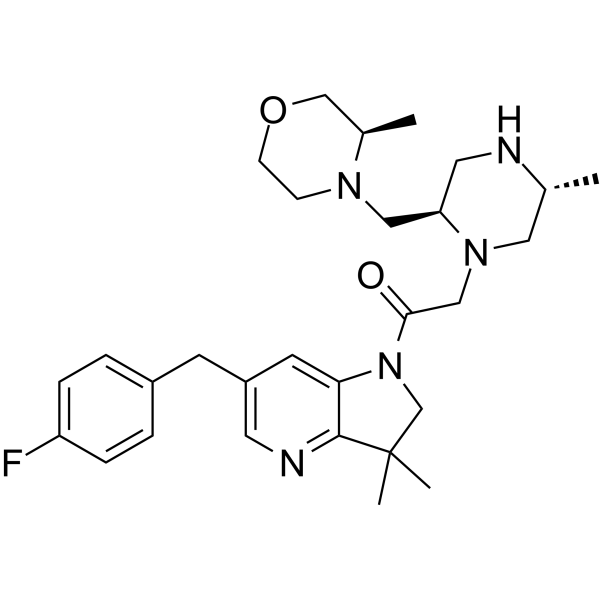
- HY-107551
-
|
|
Gli
|
Cancer
|
|
GLI antagonist-1 is a potent GLI antagonist with an IC50 value of 1.1 µM. GLI antagonist-1 shows anti-proliferative activity. GLI antagonist-1 decreases the GLI1 mRNA expression. GLI antagonist-1 inhibits colony formation in a dose-dependent manner .
|
-
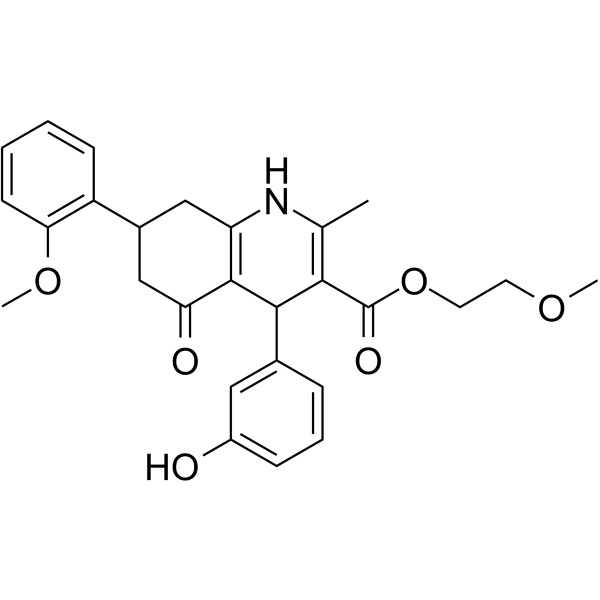
- HY-120727
-
|
|
mGluR
|
Neurological Disease
|
|
VU0364289 is a highly selective mGlu5 positive allosteric modulator (PAM) (binds to the MPEP (HY-14609A) site), with an EC50 of 1.6 µM. VU0364289 can reverse amphetamine-induced hyperlocomotion in a dose-dependent manner, which can be used for schizophrenia and other psychiatric research .
|
-
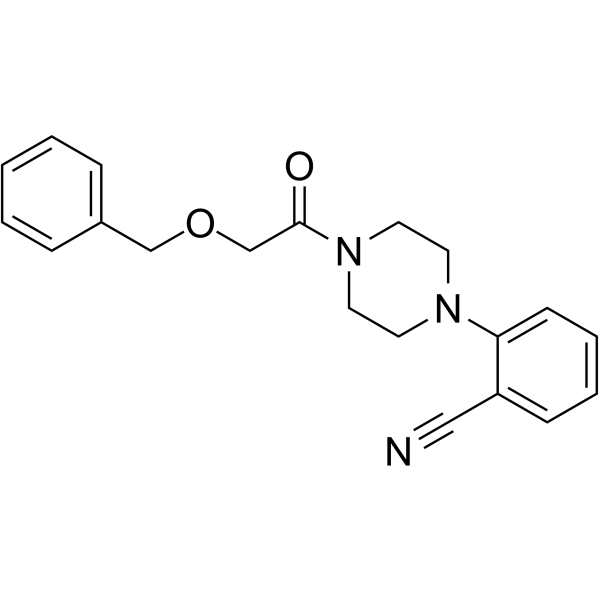
- HY-138939
-
|
|
Lipoxygenase
|
Cancer
|
|
5-LOX-IN-2, an inhibitor of 5-lipoxygenase (5-LOX) with an IC50 of 0.33 μM, inhibits 5-LOX in a dose-dependent manner . 5-LOX-IN-2, reduces the cell viability of renal cancer cells and induces apoptosis, can be used for cancer research .
|
-

- HY-162001
-
|
|
CDK
|
Cancer
|
|
INX-315 is an orally active and selective CDK2 inhibitor that induces cell cycle arrest in the G1 phase. INX-315 reduces CDK2 substrate phosphorylation and inhibits tumor growth in a dose-dependent manner in xenograft mouse models. INX-315 may be used in cancer research .
|
-

- HY-163106
-
|
|
Ceramidase
|
Cancer
|
|
W000113414_I13 is an acid ceramidase (AC) inhibitor. W000113414_I13 exhibits dose-dependent inhibition of AC with an IC50 value of 6.6?μM. W000113414_I13 can be used for the research of cancer .
|
-
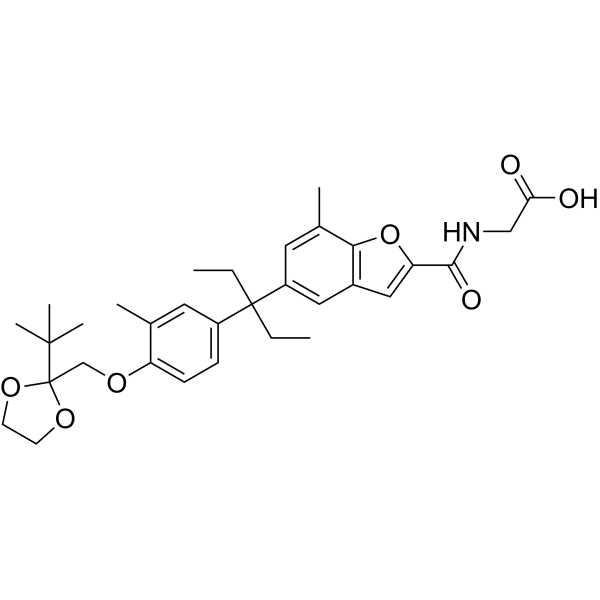
- HY-116431
-
|
|
Prostaglandin Receptor
|
Cardiovascular Disease
Neurological Disease
|
|
I-BOP is an agonist for thromboxane A2 receptor (TP) with a KD of 0.61 nM. I-BOP promotes proliferation through activation of PI3K pathway in vascular smooth muscle . I-BOP dose-dependently biphasicly affects the excitatory postsynaptic potential (e.p.s.p.) in hippocampal neurons .
|
-

- HY-B0006
-
-

- HY-115579
-
|
|
Others
|
Cancer
|
|
MALAT1-IN-1 (compounds 5) is a potent and specific Malat1 (Metastasis-associated lung adenocarcinoma transcript 1) inhibitor. MALAT1-IN-1 modulated Malat1 downstream genes in a dose-dependent manner without affecting expression of nuclear enriched abundant transcript 1 (Neat1) .
|
-
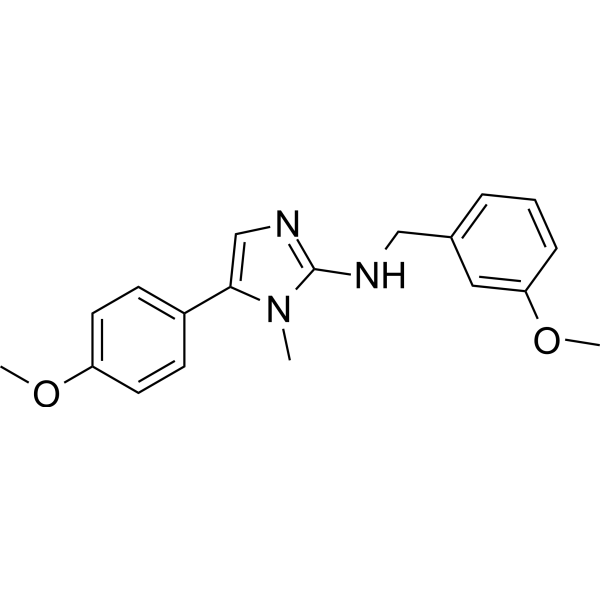
- HY-103461
-
|
|
FAAH
|
Neurological Disease
|
|
FAAH-IN-6 (compound 21d) is a potent, orally active and cross the blood-brain barrier fatty acid amide hydrolase (FAAH) inhibitor with IC50s of 0.72, 0.28 nM for hFAAH, rFAAH, respectively. FAAH-IN-6 shows dose-dependent analgesic efficacy in animal models of both neuropathic and inflammatory pain .
|
-
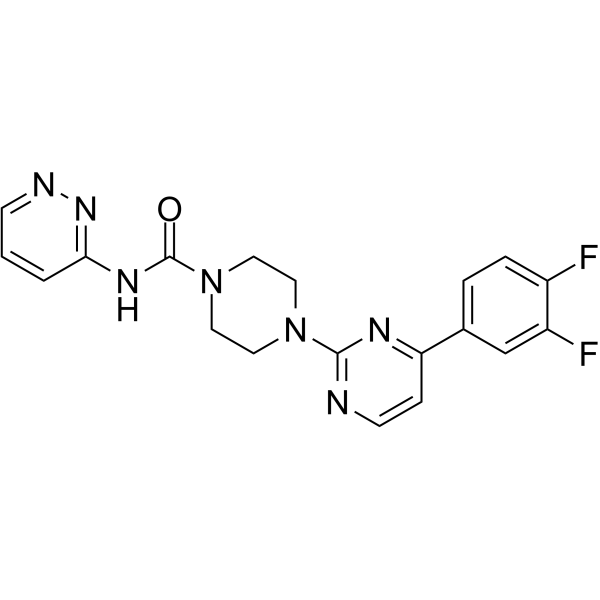
- HY-N3734
-
|
|
Beta-secretase
Phosphatase
|
Neurological Disease
|
|
Deoxyneocryptotanshinone, a natural tanshinone, is a high affinity BACE1 (Beta-secretase) inhibitor with an IC50 value of 11.53 μM. Deoxyneocryptotanshinone shows a promising dose-dependent inhibition of protein tyrosine phosphatase 1B (PTP1B) with an IC50 value of 133.5 μM. Deoxyneocryptotanshinone can be used for Alzheimer's disease research .
|
-
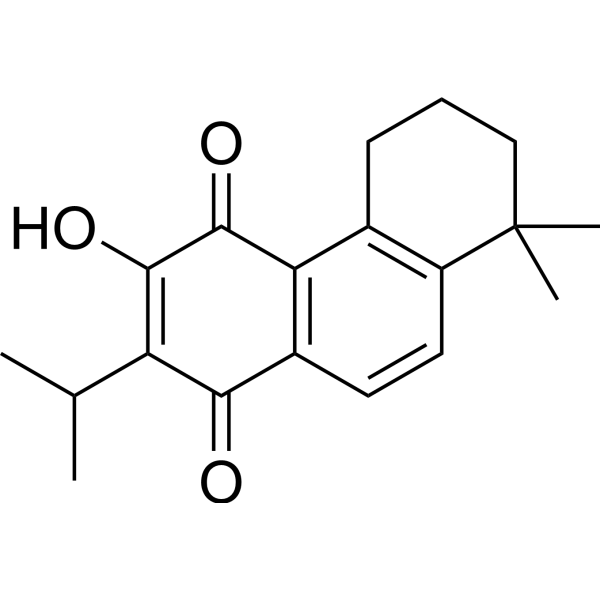
- HY-152035
-
|
|
Bacterial
|
Infection
Inflammation/Immunology
|
|
Mycobacterial Zmp1-IN-1 is a mycobacterial zinc metalloprotease-1 (Zmp1) inhibitor. Mycobacterial Zmp1-IN-1 has anti-mycobacterial activity for Mtb H37Ra in dose-dependent inhibition. Mycobacterial Zmp1-IN-1 can be used for the research of tuberculosis (TB) .
|
-
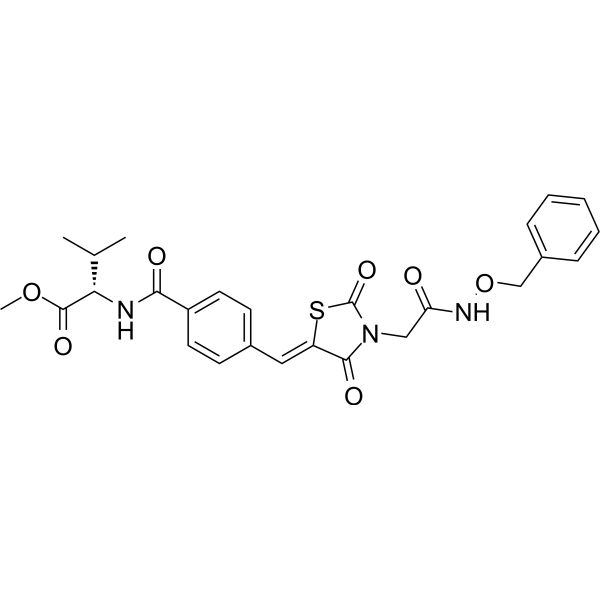
- HY-142088
-
|
|
Endogenous Metabolite
|
Metabolic Disease
|
|
Beauverolide Ka, a cyclotetradepsipeptide, is a metabolite of Beauveria bassiana fungus. Beauverolide Ka stimulates glucose uptake in cultured rat L6 myoblasts at 50 μM. Beauverolide Ka exhibits protecting effects on HEI-OC1 cells at 10 μM and shows dose-dependent activity in both L6 myoblasts and myotubes .
|
-
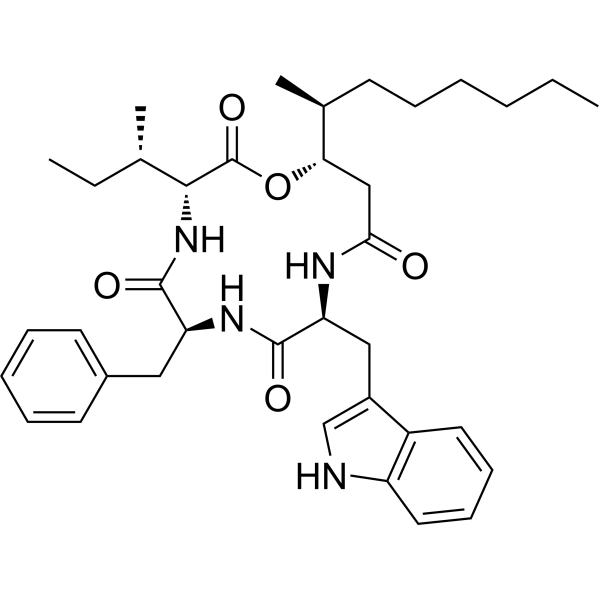
- HY-130345
-
|
|
Platelet-activating Factor Receptor (PAFR)
|
Cardiovascular Disease
|
|
C18-PAF, octadecane PAF, is the ligand of platelet-activating factor and PAF G protein-coupled receptor (PAFR). C18-PAF has renovasodilator properties and antihypertensive lipid properties. C18-PAF increases renal blood flow and causes dose-dependent systemic hypotension .
|
-
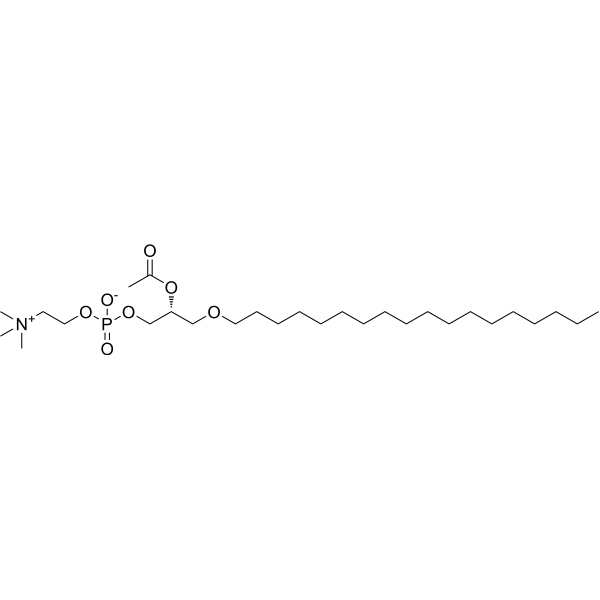
- HY-125396
-
|
11-Deoxy-PGF2β
|
Endogenous Metabolite
|
Others
|
|
11-Deoxyprostaglandin F2β (11-deoxy PGF2β) is an analog of PGF2β (HY-12956B). PGF2β is a metabolite produced by cyclooxygenase metabolism of arachidonic acid. PGF2β induces dose-dependent release of hexose containing mucin .
|
-

- HY-108630
-
U-73343
3 Publications Verification
|
Phospholipase
|
Others
|
|
U-73343, works as a protonophore, is an inactive analog of U-73122 and can be used as a negative control. U-73343 dose-dependently inhibits acid secretion irrespective of the stimulant. U-73122 is a phospholipase C (PLC) and 5-LO (5-lipoxygenase) inhibitor with an IC50 of 1-2.1 µM for PLC .
|
-
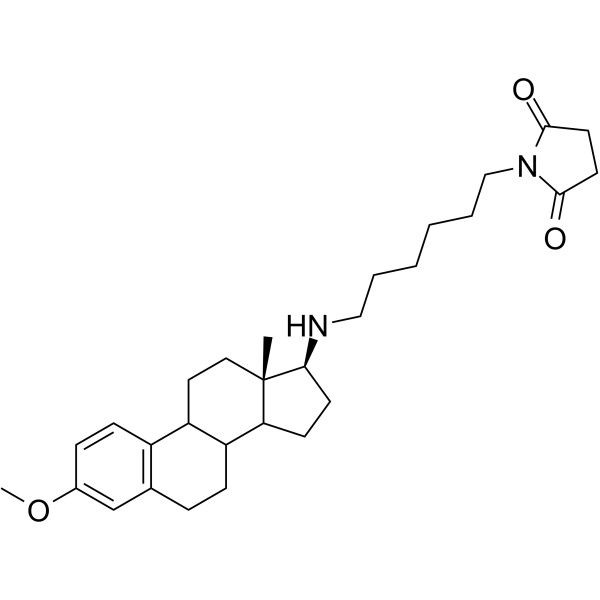
- HY-135899
-
|
|
Sirtuin
Apoptosis
|
Cancer
|
|
SIRT7 inhibitor 97491, a potent SIRT7 inhibitor with an IC50 of 325 nM, reduces deacetylase activity of SIRT7 in a dose-dependent manner. SIRT7 inhibitor 97491 prevents tumor progression by increasing p53 stability through acetylation at K373/382. SIRT7 inhibitor 97491 promotes apoptosis through caspase pathway. .
|
-
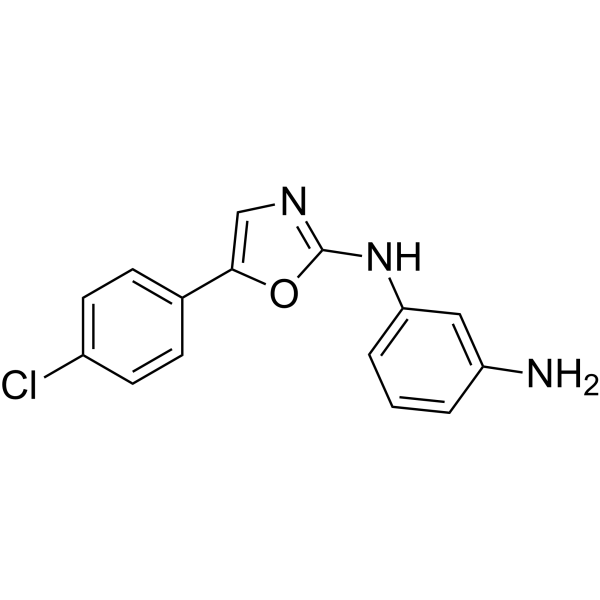
- HY-B2145
-
|
IY-81149 sodium
|
|
|
|
Ilaprazole (IY-81149) sodium is an orally active proton pump inhibitor. Ilaprazole sodium irreversibly inhibits H +/K +-ATPase in a dose-dependent manner with an IC50 of 6 μM in rabbit parietal cell preparation. Ilaprazole sodium is used for the research of gastric ulcers. Ilaprazole sodium is also a potent TOPK (T-lymphokine-activated killer cell-originated protein kinase) inhibitor .
|
-
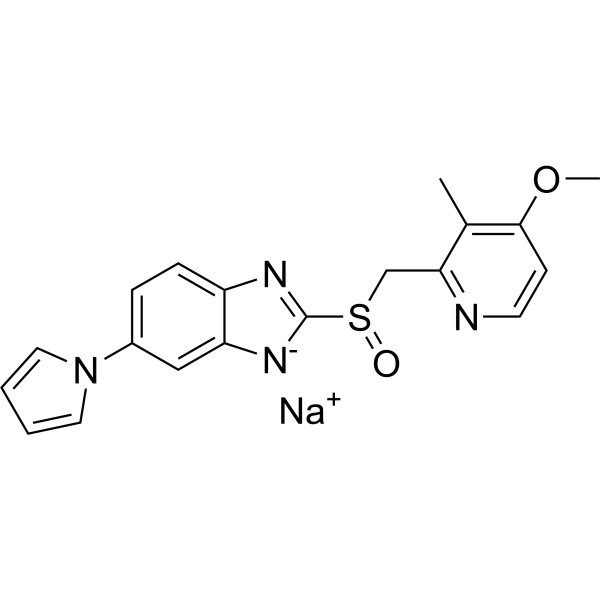
- HY-101119
-
|
|
|
|
|
GLL398, an orally active selective estrogen receptor degrader (SERD), competitively binds to the estrogen receptor with an IC50 value of 1.14 nM. GLL398 exhibits a strong dose-dependent binding profile for the ER with a Y537S point mutation (IC50= 29.5 nM). GLL398 blocks tumor growth in xenograft breast cancer models .
|
-
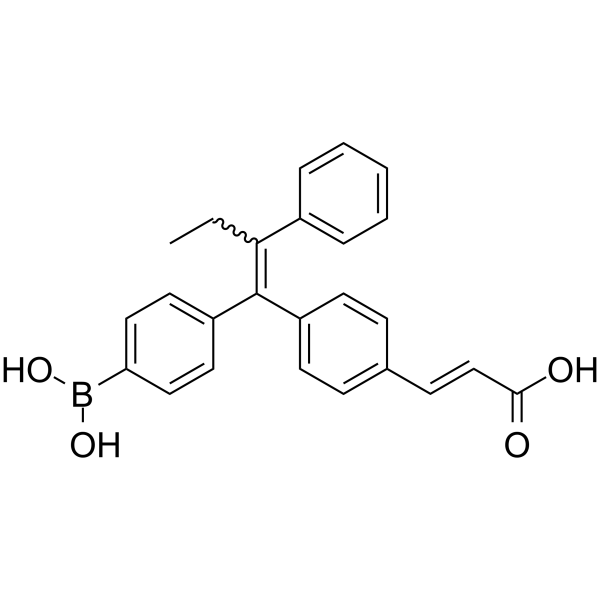
- HY-122678
-
|
|
Survivin
Apoptosis
|
Cancer
|
|
LQZ-7F, a survivin dimerization inhibitor, induces spontaneous apoptosis and synergizes with Docetaxel in prostate cancer cells. LQZ-7F dose-dependently inhibits survival of both PC-3 and C4-2 cells with IC50s of 2.99 and 2.47 µM, respectively .
|
-

- HY-122112
-
|
|
Sigma Receptor
|
Cancer
|
|
CM572 is a selective irreversible partial sigma-2 receptor agonist. CM572 has antitumor activity. CM572 induces dose-dependent cell death, with an EC50 of 7.6 μM in SK-N-SH neuroblastoma cells. CM572 can be used for the research of kinds of diseases such as neuroblastoma, breast cancer .
|
-
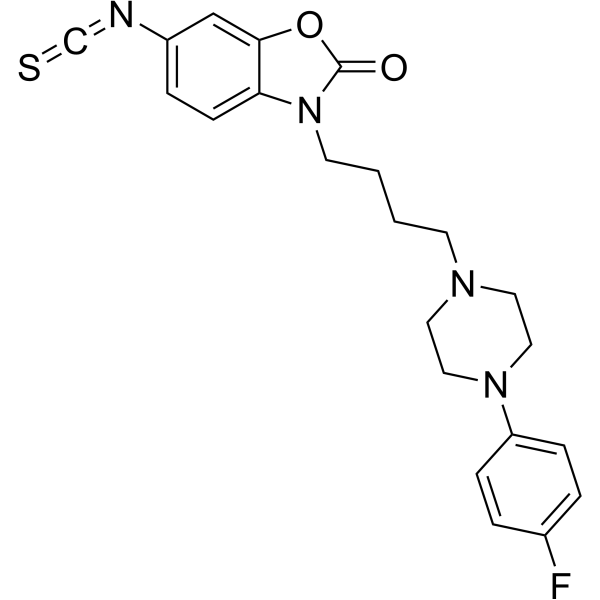
- HY-B2145A
-
|
IY-81149 sodium hydrate
|
Proton Pump
TOPK
|
Inflammation/Immunology
Cancer
|
|
Ilaprazole (IY-81149) sodium hydrate is an orally active proton pump inhibitor. Ilaprazole sodium hydrate irreversibly inhibits H +/K +-ATPase in a dose-dependent manner with an IC50 of 6 μM in rabbit parietal cell preparation. Ilaprazole sodium hydrate is used for the research of gastric ulcers. Ilaprazole sodium hydrate is also a potent TOPK (T-lymphokine-activated killer cell-originated protein kinase) inhibitor .
|
-
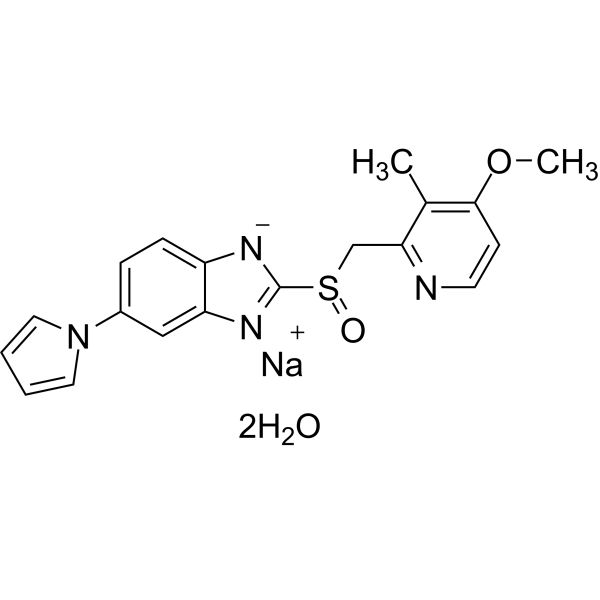
- HY-157788
-
|
|
PROTACs
Reactive Oxygen Species
Ferroptosis
Glutathione Peroxidase
|
Cancer
|
|
ZX703 (compound 5I) is a PROTAC that significantly degrades GPX4 in a dose- and time-dependent manner through the ubiquitin-proteasome and autophagy-lysosome pathways (DC50=0.315 µM). ZX703 induces ferroptosis by inducing Reactive Oxygen Species (ROS) accumulation in cells. ZX703 can be used for cancer research .
|
-
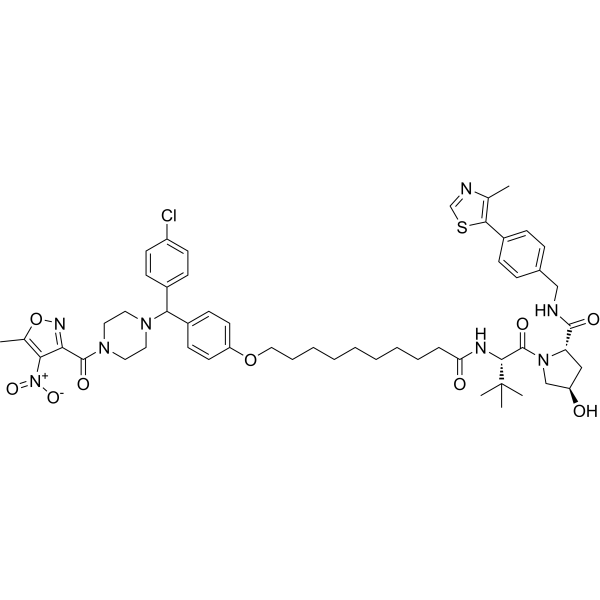
- HY-10974
-
|
|
γ-secretase
|
Neurological Disease
Cancer
|
|
MK-0752 is a potent, orally active and specific γ-secretase inhibitor, showing dose-dependent reduction of Aβ40 with an IC50 of 5 nM in human SH-SY5Y cells. MK-0752 crosses the blood-brain barrier. MK-0752 reduces newly generated CNS Aβ in vivo .
|
-
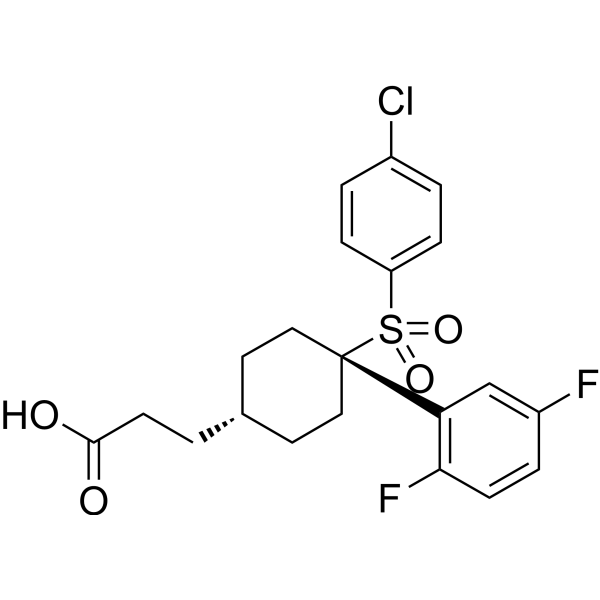
- HY-11062
-
|
AG-3-5
|
TRP Channel
|
Neurological Disease
Inflammation/Immunology
|
|
Icilin (AG-3-5) is a super-agonist of the transient receptor potential M8 (TRPM8) ion channel. Icilin activates TRPM8 in EGTA in a dose-dependent manner (EC50=1.4 μM). Icilin is a “super-cooling agent” . Icilin attenuates autoimmune neuroinflammation through modulation of the T-cell response .
|
-
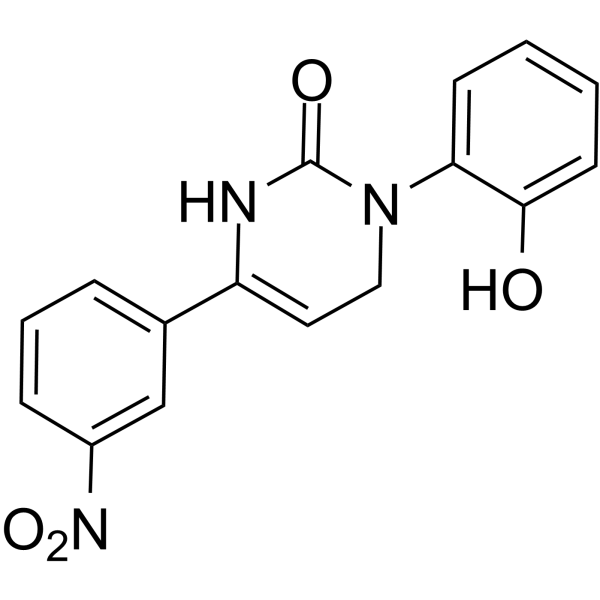
- HY-18056
-
|
|
Others
|
Metabolic Disease
|
|
PF-915275 is a potent, selective and orally active human 11β-hydroxysteroid dehydrogenase type 1 (11βHSD1) inhibitor with a Ki of 2.3 nM and an EC50 of 15 nM (in HEK293 cells). The dose-dependent effect of PF-915275 on conversion of cortisone to cortisol in primary human and monkey hepatocytes, with an EC50 of 20 and 100 nM, respectively .
|
-

- HY-12953
-
-
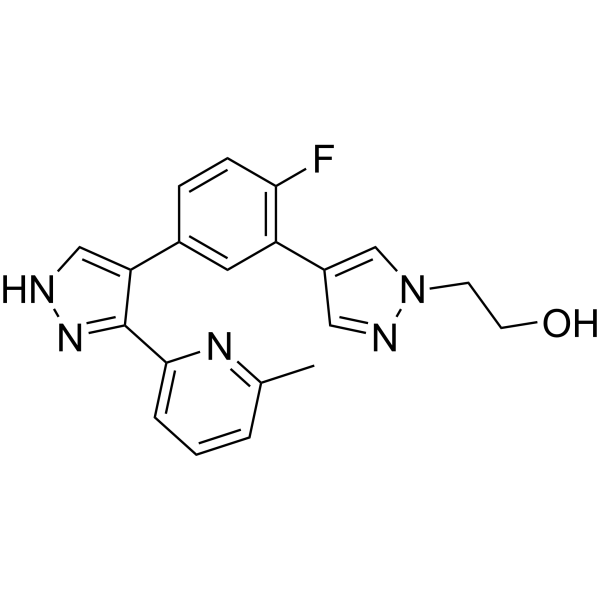
- HY-B0094S
-
|
Qinghaosu-d3; NSC 369397-d3
|
Akt
Ferroptosis
HCV
Parasite
|
Infection
Neurological Disease
Cancer
|
|
Artemisinin-d3 is the deuterium labeled Artemisinin. Artemisinin (Qinghaosu), a sesquiterpene lactone, is an anti-malarial agent isolated from the aerial parts of Artemisia annua L. plants[1]. Artemisinin inhibits AKT signaling pathway by decreasing pAKT in a dose-dependent manner. Artemisinin reduces cancer cell proliferation, migration, invasion, tumorigenesis and metastasis and has neuroprotective effects[2].
|
-

- HY-N2252
-
|
(+)-Licarin A
|
|
|
|
Licarin A ((+)-Licarin A), a neolignan, significantly and dose-dependently reduces TNF-α production (IC50=12.6 μM) in dinitrophenyl-human serum albumin (DNP-HSA)-stimulated RBL-2H3 cells. Anti-allergic effects. Licarin A reduces TNF-α and PGD2 production, and COX-2 expression .
|
-
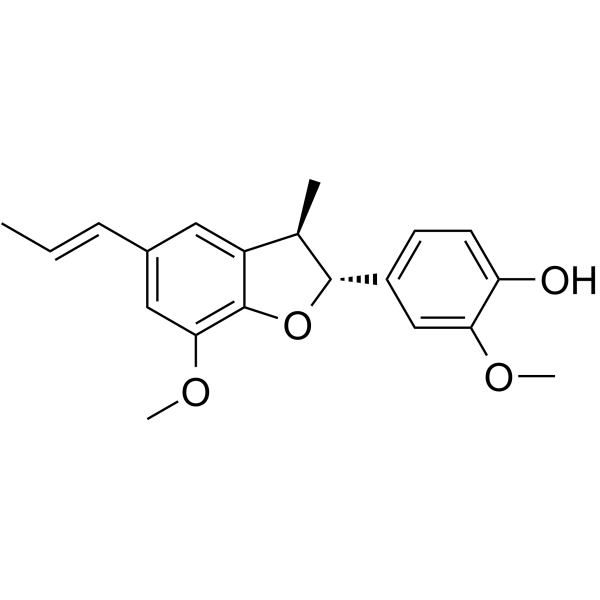
- HY-131334
-
|
|
AMPK
|
Metabolic Disease
|
|
AMPK activator 4 is a potent AMPK activator without inhibition of mitochondrial complex I. AMPK activator 4 selectively activates AMPK in the muscle tissues. AMPK activator 4 dose-dependently improves glucose tolerance in normal mice, and significantly lowers fasting blood glucose level and ameliorates insulin resistance in db/db diabetic mice. Anti-hyperglycemic effect .
|
-

- HY-145153
-
|
|
Cannabinoid Receptor
|
Neurological Disease
|
|
S-777469 is a selective and orally available cannabinoid type 2 receptor (CB2) agonist with a Ki of 36 nM. S-777469 significantly suppresses compound 48/80-induced scratching behavior in mice in a dose-dependent manner. S-777469 produces its antipruritic effects by inhibiting itch signal transmission through CB2 agonism .
|
-
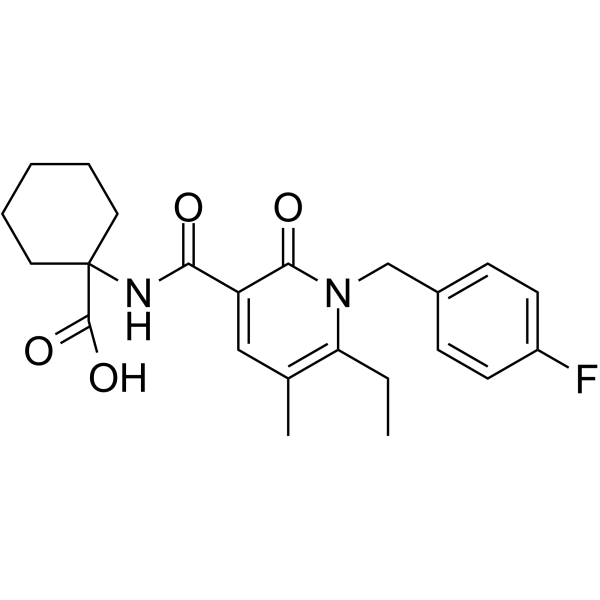
- HY-144657
-
|
|
PROTACs
Ras
|
Cancer
|
|
(4S)-PROTAC SOS1 degrader-1 is a potent PROTAC SOS1 degrader. (4S)-PROTAC SOS1 degrader-1 decreases the expression of pERK and RAS-GTP level in a dose-dependent manner. (4S)-PROTAC SOS1 degrader-1 significantly inhibits the tumor growth in vivo .
|
-
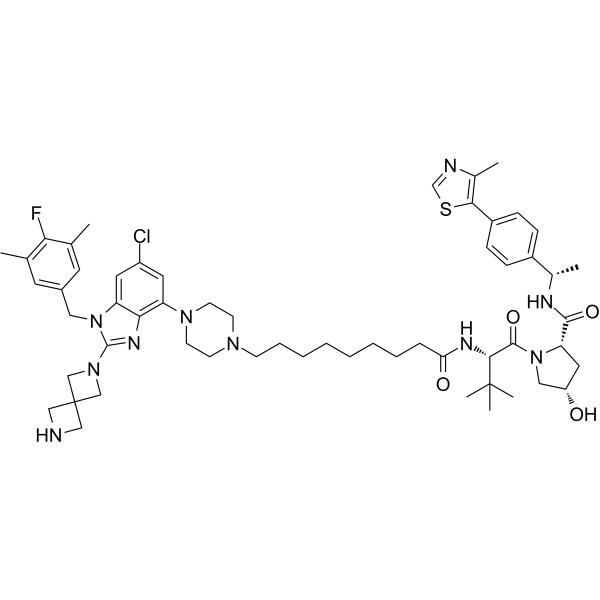
- HY-144132
-
|
|
Apoptosis
Microtubule/Tubulin
|
Cancer
|
|
αβ-Tubulin-IN-1 is a potent and orally active αβ-Tubulin inhibitor. αβ-Tubulin-IN-1 induces cell cycle arrest at G2/M and efficient apoptosis. αβ-Tubulin-IN-1 inhibits tumor cell migration and Metastasis. αβ-Tubulin-IN-1 shows significant antitumor efficacy in a dose dependent manner .
|
-
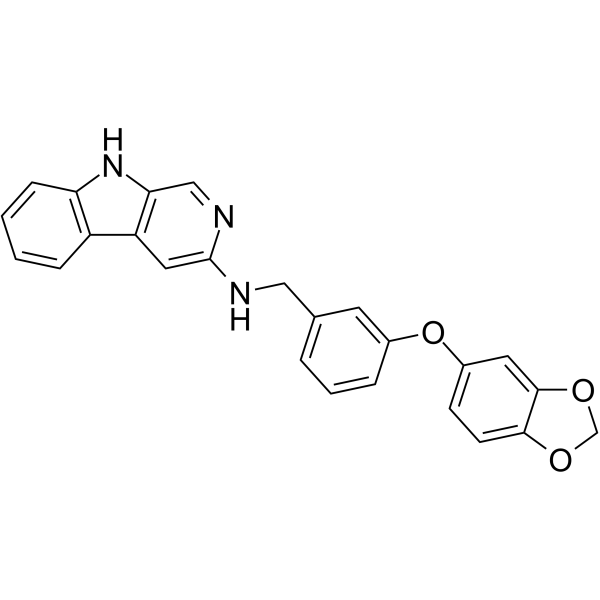
- HY-144797
-
|
|
Microtubule/Tubulin
|
Cancer
|
|
Tubulin inhibitor 22 (compound 4c) is a potent inhibitor of tubulin with anti-angiogenesis and anti-cancer properties. Tubulin inhibitor 22 arrests MGC-803 cell cycle at G2/M phase. Tubulin inhibitor 22 dose-dependently causes Caspase-induced apoptosis of MGC-803 cells through mitochondrial dysfunction .
|
-

- HY-146203
-
|
|
FAK
|
Cancer
|
|
Compound 26F not only optimized the effective inhibitory enzyme (ic50= 28.2 nm), but also showed relatively less cytotoxicity (ic50= 3.32 μ M) And induced MDA-MB-231 cell apoptosis in a dose-dependent manner, effectively blocking MDA-MB-231 cells in g0/g1 phase.
|
-

- HY-123714
-
|
|
MAP4K
Apoptosis
|
Inflammation/Immunology
Cancer
|
|
TL4-12 is a selective MAP4K2/GCK inhibitor, dose-dependently downregulates IKZF1 and BCL-6 and leads to MM cell proliferation inhibition (IC50=37 nM) accompanied by induction of apoptosis. TL4-12 can be used to overcome immunomodulatory agent resistance in multiple myeloma (MM) .
|
-
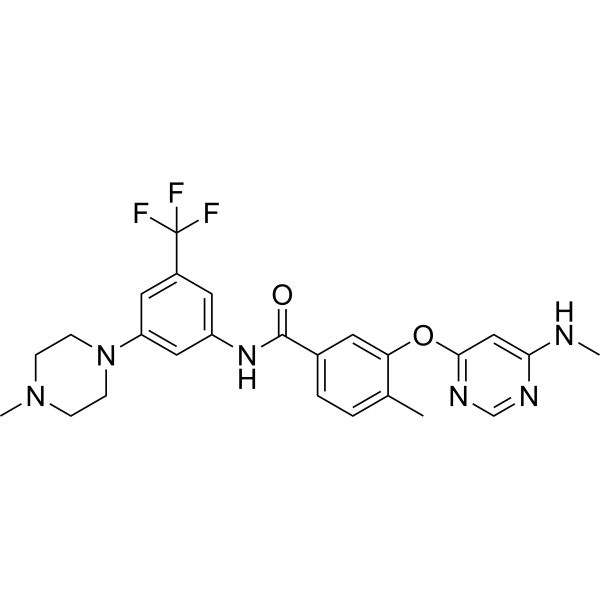
- HY-139451
-
|
|
Others
|
Neurological Disease
|
|
ELOVL6-IN-1 is a potent, orally active and selective ELOVL6 inhibitor. ELOVL6-IN-1 dose-dependently inhibits mouse ELOVL6 activities, with an IC50 value of 0.350 μM. ELOVL6-IN-1 inhibits ELOVL6 in a noncompetitive manner for malonyl-CoA (Ki=994 nM) and palmitoyl-CoA .
|
-
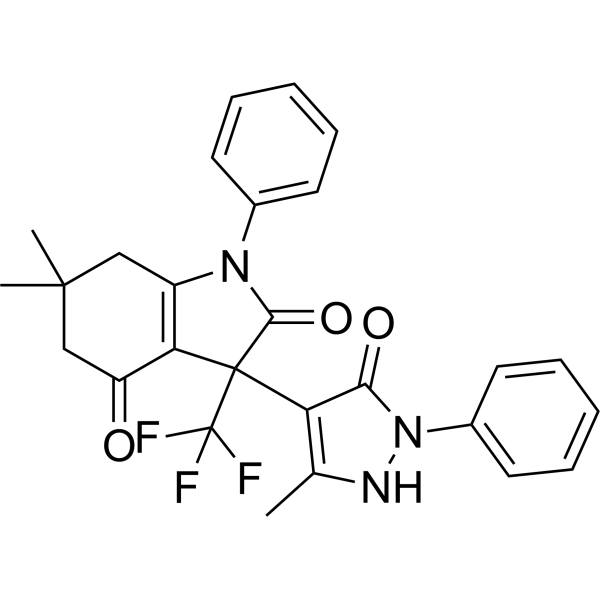
- HY-B1246
-
|
|
Bacterial
Proton Pump
|
Infection
|
|
Thonzonium bromide is an antibacterial agent that is structurally similar to Farnesol (HY-Y0248A). Thonzonium bromide is also a monocationic surface-active agent, which inhibits RANKL-induced osteoclast formation and bone resorption in vitro and prevents LPS-induced bone loss in vivo. Thonzonium bromide inhibits proton transport in a dose-dependent manner (EC50=69 μM) .
|
-
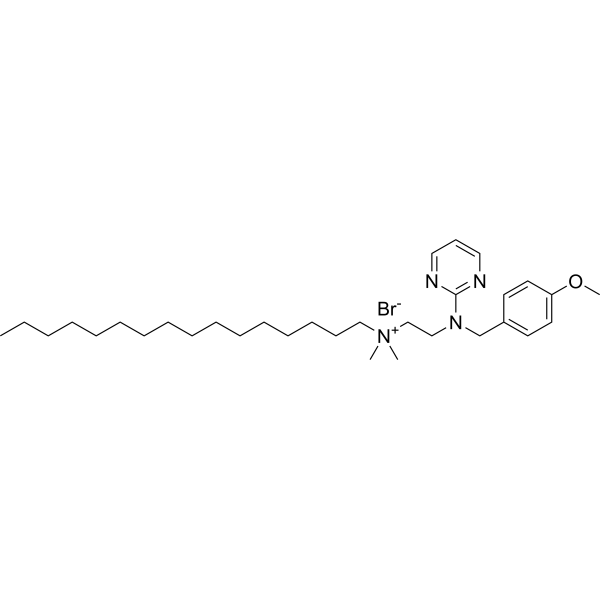
- HY-101664
-
|
IY-81149
|
Proton Pump
TOPK
|
Inflammation/Immunology
Cancer
|
|
Ilaprazole (IY-81149) is an orally active proton pump inhibitor. Ilaprazole irreversibly inhibits H +/K +-ATPase in a dose-dependent manner with an IC50 of pump inhibitory activity of 6 μM in rabbit parietal cell preparation. Ilaprazole is used for the research of gastric ulcers. Ilaprazole is also a potent TOPK (T-lymphokine-activated killer cell-originated protein kinase) inhibitor .
|
-
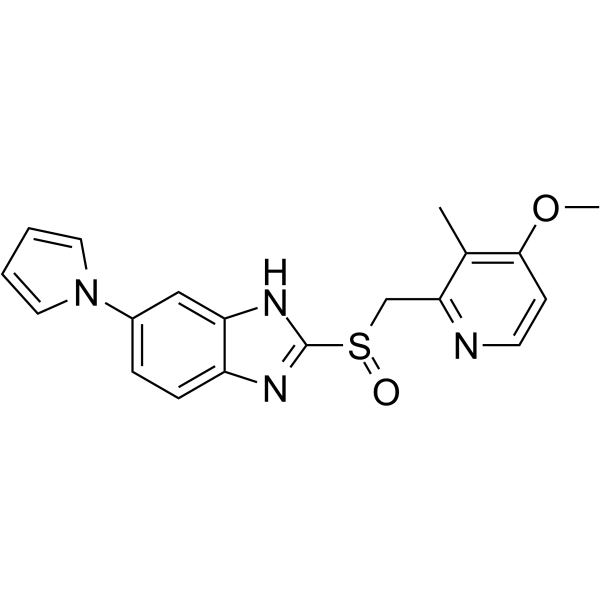
- HY-12995A
-
|
|
FLAP
|
Inflammation/Immunology
|
|
(S)-BI 665915 is an orally active oxadiazole-containing 5-lipoxygenase-activating protein (FLAP) inhibitor with an IC50 of 1.7 nM for FLAP binding. (S)-BI 665915 inhibits FLAP functional in human whole blood with an IC50 of 45 nM. (S)-BI 665915 demonstrates an excellent cross-species agent metabolism and pharmacokinetics (DMPK) profile and a dose-dependent inhibition of LTB4 production .
|
-
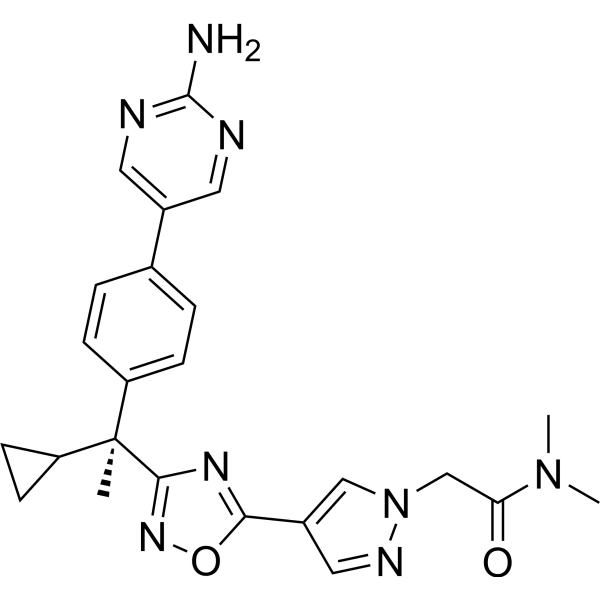
- HY-145865
-
|
|
Apoptosis
|
Cancer
|
|
Antiproliferative against-3 (comp 33) shows a prominent activity against Hela (IC50 = 0.21 µM), A549 (IC50 = 0.39 µM), and MCF-7 (IC50 = 0.33 µM), respectively. Antiproliferative against-3 (comp 33) also dose dependently induces apoptosis by arresting A549 cells at G1 phase .
|
-
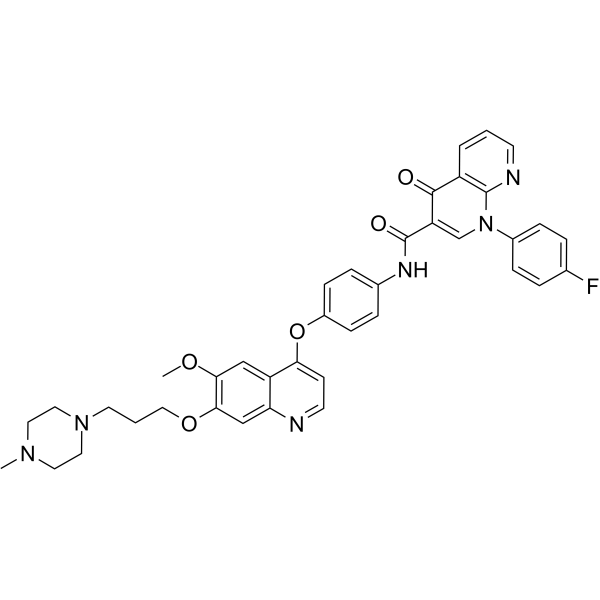
- HY-B0162S
-
|
|
HCN Channel
|
Cardiovascular Disease
|
|
Ivabradine-d6 is the deuterium labeled Ivabradine[1]. Ivabradine is a potent and orally active HCN (hyperpolarization-activated cyclic nucleotide-gated) channel blocker that inhibits the cardiac pacemaker current (If). Ivabradine reduces dose-dependently heart rate without modification of blood pressure. Ivabradine shows anticonvulsant, anti-ischaemic and anti-anginal activity[2][3][4][5].
|
-
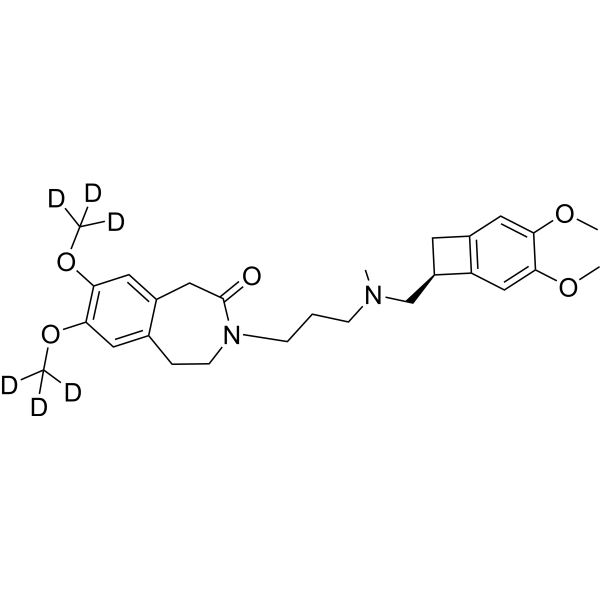
- HY-155417
-
|
|
Others
|
Neurological Disease
|
|
GPR34 receptor antagonist 3 (Compound 5e) is a class of GRP34 antagonists, IC50 is 0.680 μM. GPR34 receptor antagonist 3 inhibited ERK1/2 phosphorylation induced by lysophosphatidylserine in a dose-dependent way without obvious cytotoxicity. GPR34 receptor antagonist 3 shows antisensory activity in mouse neuropathic pain model .
|
-
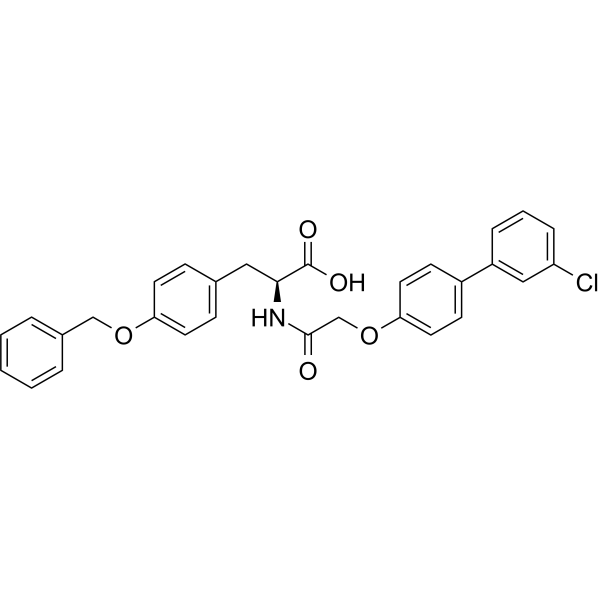
- HY-P10228
-
|
|
Fungal
Bacterial
|
Infection
|
|
S-Thanatin is an insect antimicrobial peptide with potent broad-spectrum antibacterial activity. S-Thanatin can inhibit the activity of Gram-negative bacteria, Gram-positive bacteria, and fungi, without cytotoxicity. The antibacterial activity of S-Thanatin is not affected by PH value, but monovalent cations (Na +/K +) can reduce its antibacterial activity against Gram-negative bacteria in a dose-dependent manner .
|
-

- HY-124798
-
|
|
mTOR
|
Neurological Disease
Inflammation/Immunology
Cancer
|
Rheb inhibitor NR1 is a Rheb inhibitor with an IC50 of 2.1 µM in the Rheb-IVK assay. Rheb inhibitor NR1 can directly bind Rheb in the switch II domain and selectively inhibit the activation of mechanistic target of rapamycin complex 1 (mTORC1). Rheb inhibitor NR1 inhibits the phosphorylation of mTORC1 driven T389pS6K1 and increases the phosphorylation of S473pAKT in a dose-dependent manner. Rheb inhibitor NR1 does not influence mTORC2 activity .
(Rheb-IVK: Rheb-dependent mTORC1 kinase activity)
|
-

- HY-N3504
-
|
|
Sirtuin
|
Cancer
|
|
Ophiopogonin D', isolated from the tubers of Ophiopogon japonicus, is a rare naturally occurring C29 steroidal glycoside. Ophiopogonin D' shows cytotoxic activity against two human tumor cell lines MG-63 and SNU387 with IC50s of 3.09 μM and 3.63 μM, respectively . Ophiopogonin D' activates SIRT1 in a dose-dependent manner .
|
-
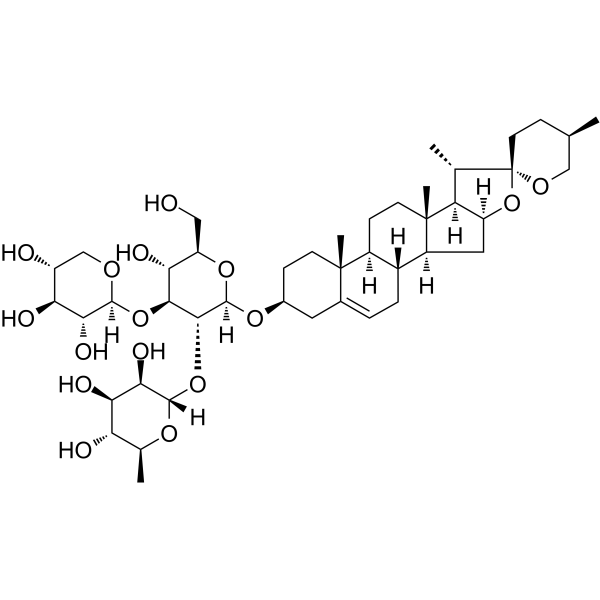
- HY-110100
-
CPYPP
2 Publications Verification
|
Others
|
Inflammation/Immunology
|
|
CPYPP is a DOCK2-Rac1 interaction inhibitor. CPYPP binds to DOCK2 DHR-2 domain and inhibits the guanine nucleotide exchange factor (GEF) activity of DOCK2 DHR-2 for Rac1 in a dose-dependent manner with an IC50 of 22.8 µM. CPYPP also inhibits DOCK180 and DOCK5 and less inhibits DOCK9 .
|
-
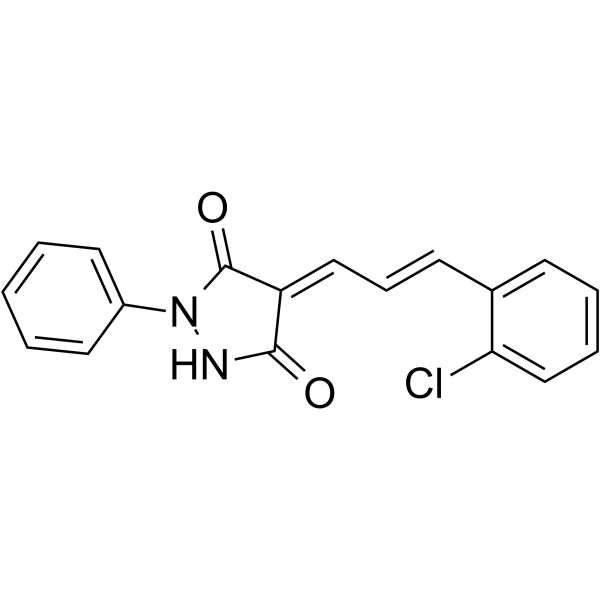
- HY-113439
-
|
|
Apoptosis
|
Cardiovascular Disease
Inflammation/Immunology
|
|
12-HETE, a major metabolic product of arachidonic acid using 12-LOX catalysis, inhibits cell apoptosis in a dose-dependent manner. 12-HETE promotes the activation and nuclear translocation of NF-κB through the integrin-linked kinase (ILK) pathway .12-HETE has both anti-thrombotic and pro-thrombotic effects . 12-HETE is a neuromodulator .
|
-
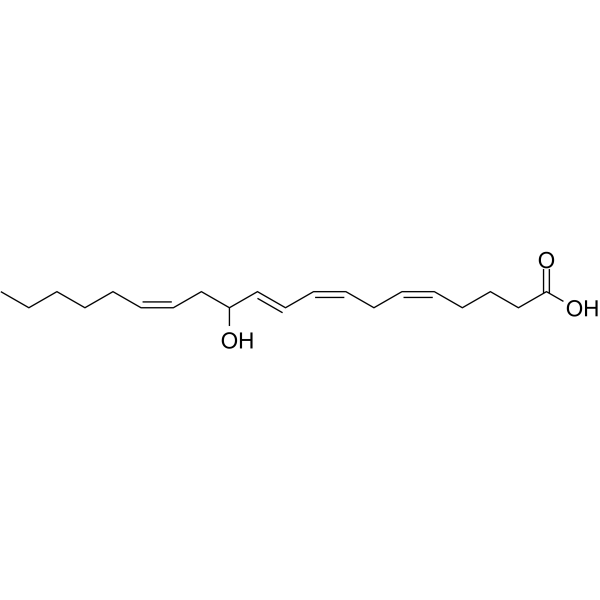
- HY-143653
-
|
|
BCL6
|
Cancer
|
|
BCL6-IN-6 is a potent inhibitor of transcriptional repressor B-cell lymphoma 6 (BCL6). BCL6-IN-6 significantly blocks the interaction of BCL6 with its corepressors and reactivates BCL6 target genes in a dose-dependent manner. BCL6-IN-6 has the potential for the research of diffuse large B-cell lymphoma (DLBCL) .
|
-
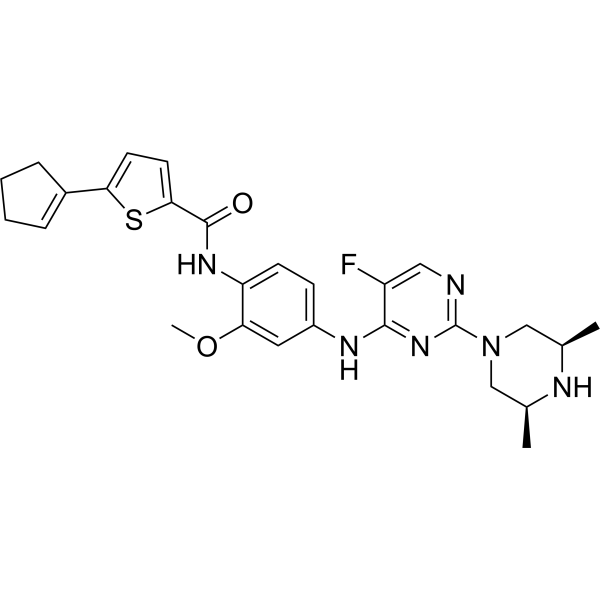
- HY-144731
-
|
|
HIV
|
Inflammation/Immunology
|
|
gp120-IN-2 (compound 4i) is a potent HIV-1 gp120 inhibitor with an IC50 of 7.5 µM and CC50 of 112.93 µM. gp120-IN-2 shows anti-HIV-1 activity. gp120-IN-2 shows cytotoxicity in a dose dependent manner in SUP-T1 cells .
|
-

- HY-144657A
-
|
|
PROTACs
Ras
|
Cancer
|
|
(4S)-PROTAC SOS1 degrader-1 (diTFA) is a potent PROTAC SOS1 degrader. (4S)-PROTAC SOS1 degrader-1 (diTFA) decreases the expression of pERK and RAS-GTP level in a dose-dependent manner. (4S)-PROTAC SOS1 degrader-1 (diTFA) significantly inhibits the tumor growth in vivo .
|
-
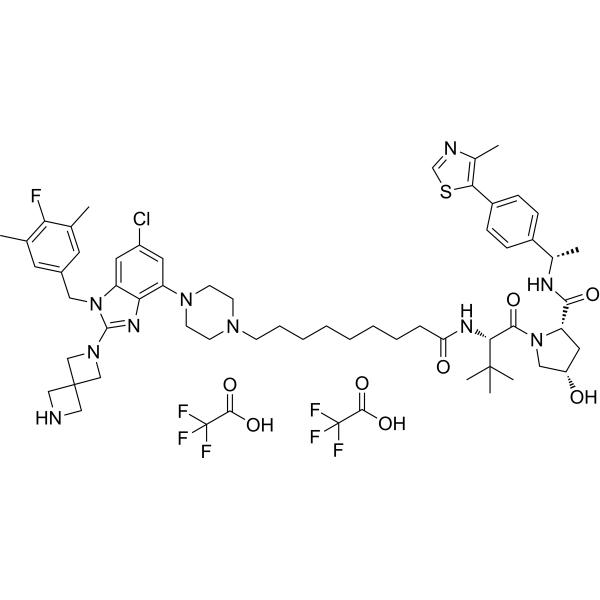
- HY-101906
-
|
|
Free Fatty Acid Receptor
Apoptosis
|
Metabolic Disease
|
|
DC260126 is a potent antagonist of GPR40 (FFAR1). DC260126 dose-dependently inhibits GPR40-mediated Ca 2+ elevations stimulated by linoleic acid, oleic acid, palmitoleic acid and lauric acid (IC50: 6.28, 5.96, 7.07, 4.58 μM, respectively) . DC260126 could protect MIN6 β cells from palmitate-induced ER stress and apoptosis .
|
-
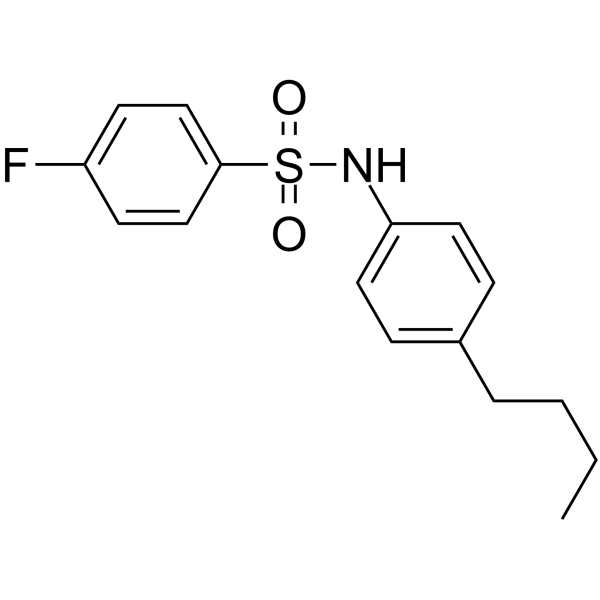
- HY-B0006S
-
|
|
Adrenergic Receptor
Autophagy
|
Cardiovascular Disease
Inflammation/Immunology
Cancer
|
|
Carvedilol-d3 is the deuterium labeled Carvedilol. Carvedilol (BM 14190) is a non-selective β/α-1 blocker[1]. Carvedilol inhibits lipid peroxidation in a dose-dependent manner with an IC50 of 5 μM. Carvedilol is a multiple action antihypertensive agent with potential use in angina and congestive heart failure[2]. Carvedilol is an autophagy inducer that inhibits the NLRP3 inflammasome[3].
|
-
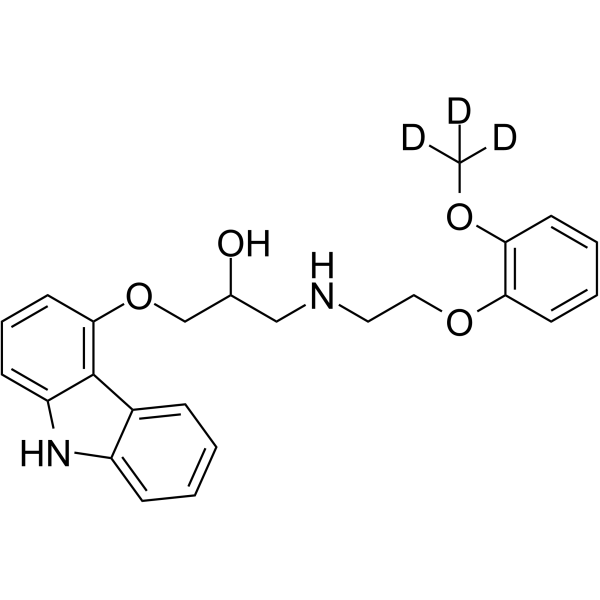
- HY-B0006S1
-
|
BM 14190-d4
|
Adrenergic Receptor
Autophagy
|
Cardiovascular Disease
Inflammation/Immunology
Cancer
|
|
Carvedilol-d4 is the deuterium labeled Carvedilol. Carvedilol (BM 14190) is a non-selective β/α-1 blocker[1]. Carvedilol inhibits lipid peroxidation in a dose-dependent manner with an IC50 of 5 μM. Carvedilol is a multiple action antihypertensive agent with potential use in angina and congestive heart failure[2]. Carvedilol is an autophagy inducer that inhibits the NLRP3 inflammasome[3].
|
-
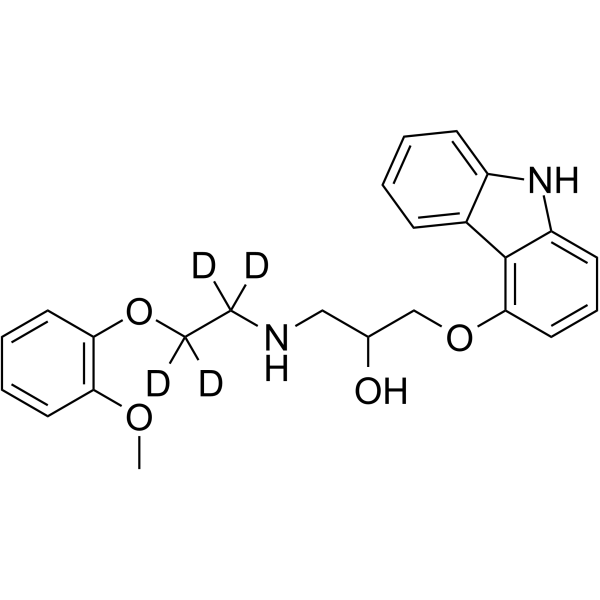
- HY-134539
-
IMT1
3 Publications Verification
|
Oxidative Phosphorylation
Mitochondrial Metabolism
DNA/RNA Synthesis
|
Metabolic Disease
Cancer
|
|
IMT1 is a first-in-class specific and noncompetitive human mitochondrial RNA polymerase (POLRMT) inhibitor. IMT1 causes a conformational change of POLRMT, which blocks substrate binding and transcription in a dose-dependent way in vitro. IMT1 reduces deoxynucleoside triphosphate levels and citric acid cycle intermediates, resulting in a marked depletion of cellular amino acid levels. IMT1 has the potential for mitochondrial transcription disorders related diseases .
|
-
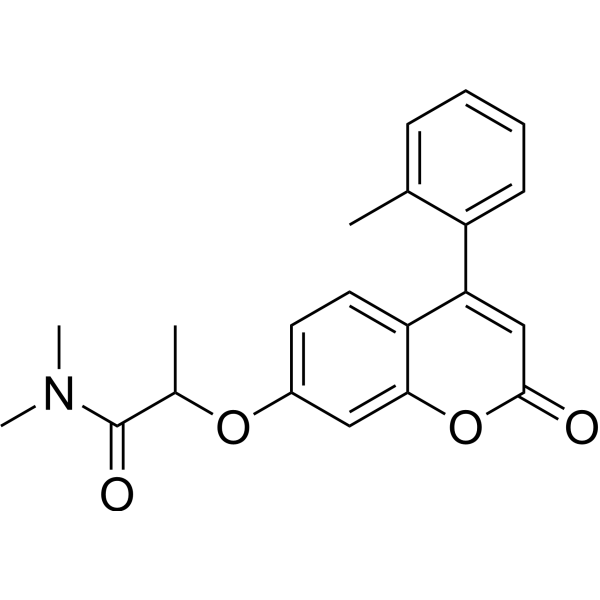
- HY-B0006S2
-
-
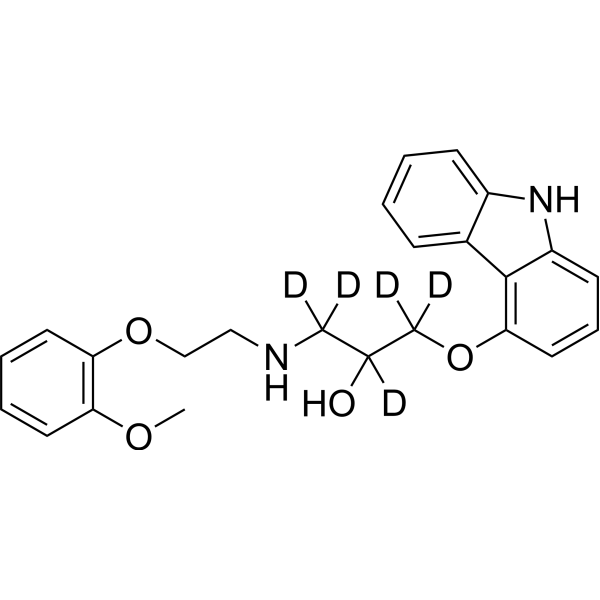
- HY-152019
-
|
|
EGFR
|
Cancer
|
|
EGFR/C797S-IN-1 is a potent EGFR-C797S inhibitor with an IC50 value of 0.128 µM. EGFR/C797S-IN-1 shows anti-proliferative activity and anti-tumor activity. EGFR/C797S-IN-1 inhibits the expression of p-EGFR in a dose-dependent manner .
|
-
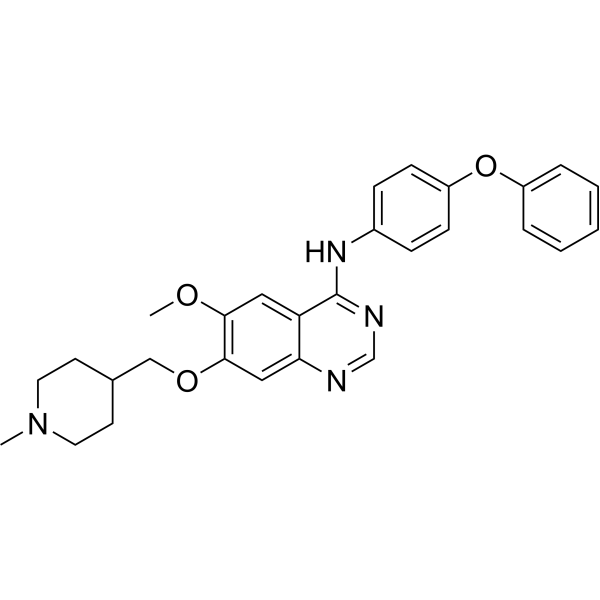
- HY-108554
-
|
|
Protease Activated Receptor (PAR)
|
Others
|
|
Q94 hydrochloride, a selective PAR1 antagonist (IC50=916 nM), can selectively block PAR1/Gαq interaction and signalling. Q94 hydrochloride blocks PAR1-mediated increases in both CCL2 mRNA and protein levels in a dose-dependent manner. Q94 hydrochloride also completely blocks thrombin-induced ERK1/2 and MLC phosphorylation .
|
-

- HY-B0006R
-
|
BM 14190 (Standard)
|
Adrenergic Receptor
Autophagy
Bacterial
|
Cardiovascular Disease
Inflammation/Immunology
Cancer
|
|
Carvedilol (Standard) is the analytical standard of Carvedilol. This product is intended for research and analytical applications. Carvedilol (BM 14190) is a non-selective β/α-1 blocker . Carvedilol inhibits lipid peroxidation in a dose-dependent manner with an IC50 of 5 μM. Carvedilol is a multiple action antihypertensive agent with potential use in angina and congestive heart failure . Carvedilol is an autophagy inducer that inhibits the NLRP3 inflammasome .
|
-

- HY-103484
-
|
|
Others
|
Cardiovascular Disease
|
|
GATA4-NKX2-5-IN-1 (Compound 3) dose-dependently inhibits the GATA4–NKX2-5 transcriptional synergy with an IC50 of 3 μM. GATA4-NKX2-5-IN-1 exhibits no activity on the protein kinases involved in the regulation of GATA4 phosphorylation, and it modulates the hypertrophic agonist-induced cardiac gene expression .
|
-
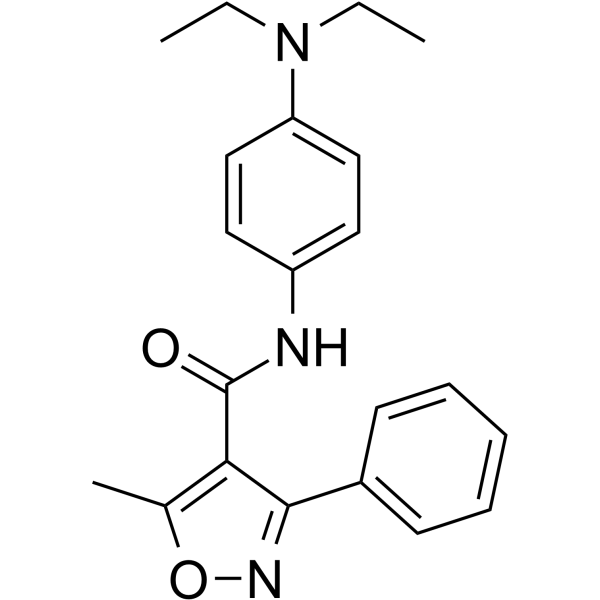
- HY-111751
-
|
|
iGluR
|
Neurological Disease
|
|
JNJ-61432059 is an oral active and selective negative modulator of AMPAR associated with trans-membrane AMPAR regulatory protein (TARP) γ-8, with a pIC50 of 9.7 for GluA1/γ-8. Exhibits time- and dose-dependent AMPAR/γ-8 receptor occupancy in mouse hippocampus, resulting in robust seizure protection in corneal kindling and pentylenetetrazole (PTZ) anticonvulsant models .
|
-
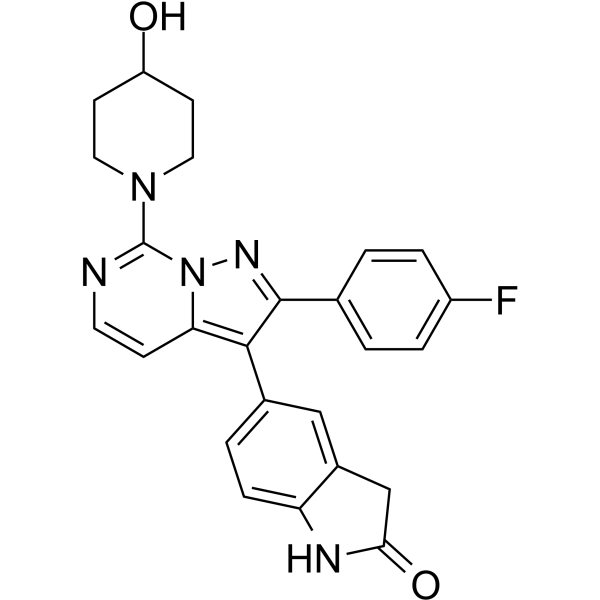
- HY-N0241
-
|
|
Cholinesterase (ChE)
|
Metabolic Disease
|
|
Rhodionin, isolated from the root of Rhodiola crenulata, is a specific non-competitive cytochrome P450 2D6 inhibitor with an IC50 of 0.761 μM and a Ki of 0.769 μM . Rhodionin exhibits potent, dose-dependent inhibitory effects on acetylcholinesterase (AChE) with IC50 ranged from 57.50 to 2.43 μg/mL . Rhodionin exhibits potent DPPH free radical scavenging activities, with an IC50 of 19.49 μM .
|
-
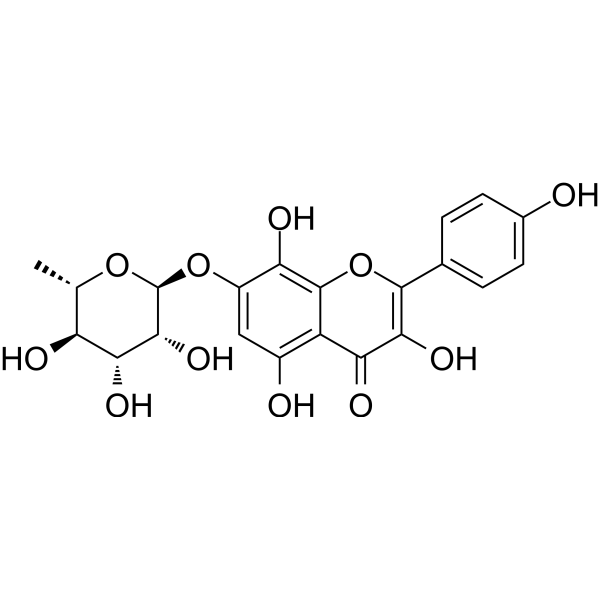
- HY-115497
-
|
|
E1/E2/E3 Enzyme
|
Infection
Inflammation/Immunology
|
|
BRD5529 is an effective dose-dependent CARD9-TRIM62 protein–protein interaction (PPI) inhibitor with an IC50 value of 8.6 μM. BRD5529 has potency and complete inhibition of CARD9 ubiquitinylation in vitro, also has favorable solubility. BRD5529 can be used for the research of inflammatory bowel disease (IBD) such as Crohn’s disease (CD) and ulcerative colitis (UC) .
|
-
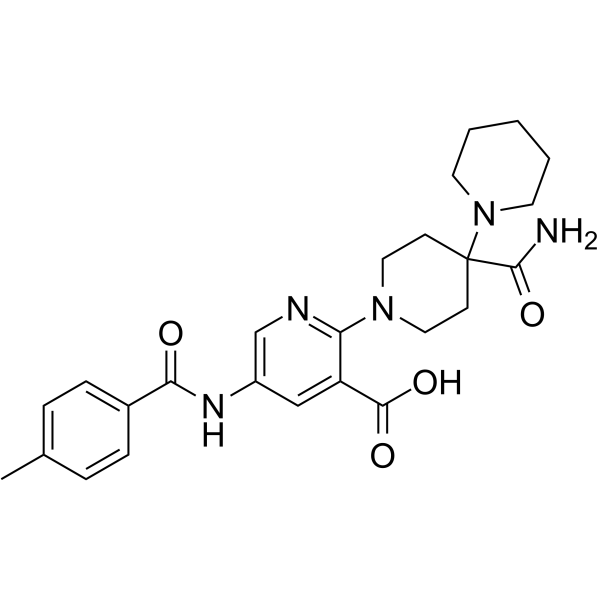
- HY-19541A
-
|
|
Epigenetic Reader Domain
|
Cancer
|
|
I-CBP112 hydrochloride is a selective inhibitor of CBP/P300 that directly binds their bromodomains (Kds = 142 and 625 nM, respectively). I-CBP112 significantly reduces the leukemia-initiating potential of MLL-AF9(+) acute myeloid leukemia cells in a dose-dependent manner in vitro and in vivo. I-CBP112 increases the cytotoxic activity of BET bromodomain inhibitor JQ1 as well as doxorubicin .
|
-
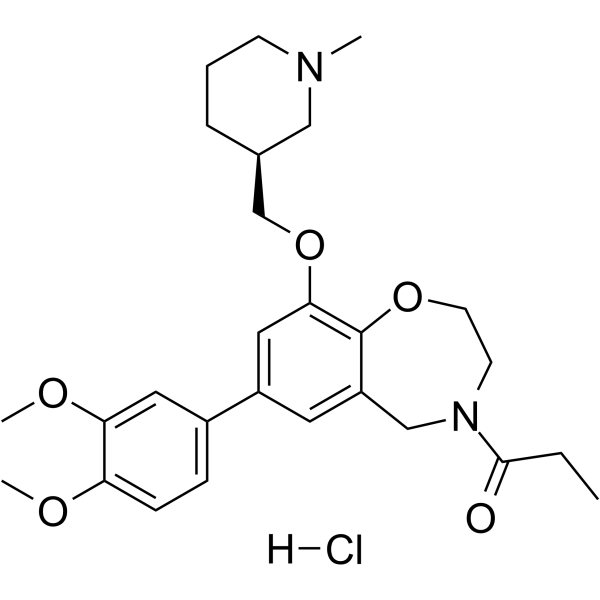
- HY-111140
-
|
|
PGE synthase
Lipoxygenase
|
Inflammation/Immunology
|
|
YS121 is a dual inhibitor of microsomal prostaglandin E2 synthase-1 (mPGES-1; IC50=3.4 μM) and 5-lipoxygenase (5-LOX; IC50=6.5 μM). YS121 dose- dependently reduces PGE2 production with EC50=12 μM in IL-1β-stimulated A549 cells .
|
-
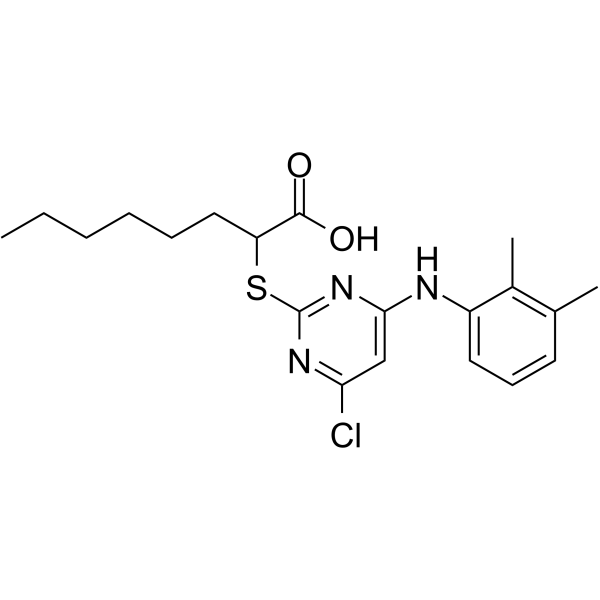
- HY-150582
-
|
|
c-Met/HGFR
c-Kit
FLT3
Apoptosis
|
Cancer
|
|
c-Met-IN-14 (compound 26af) is a selective inhibitor of c-Met kinase from N-sulfonylamidine-based derivatives, with an IC50 value of 2.89 nM. c-Met-IN-14 shows anticancer activity by blocking phosphorylation of c-Met, and arrests cell cycle at G2/M phase. c-Met-IN-14 induces apoptosis of A549 cells in a dose-dependent manner .
|
-

- HY-161260
-
|
|
P-glycoprotein
|
Cancer
|
|
P-gp inhibitor 20 (compound H27) is a low cytotoxicity P-glycoprotein (P-gp) inhibitor. P-gp inhibitor 20 inhibits the efflux function of P-gp in a dose-dependent manner (without affecting the expression of P-gp), thereby reversing the multidrug resistance (MDR) of MCF-7/ADR cells, with an IC50 value of 46.6 nM. P-gp inhibitor 20 can be used for cancer research .
|
-
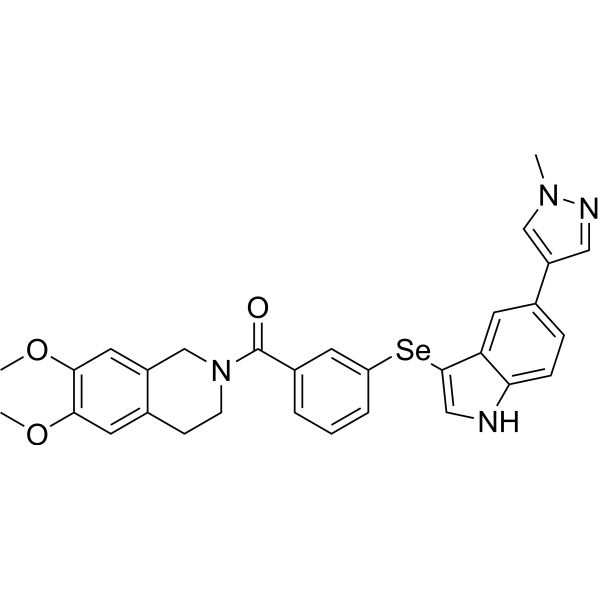
- HY-100022
-
|
eFT508
|
MNK
PD-1/PD-L1
|
Cancer
|
|
Tomivosertib (eFT508) is a potent, highly selective, and orally active MNK1 and MNK2 inhibitor, with IC50s of 1-2 nM against both isoforms. Tomivosertib (eFT508) treatment leads to a dose-dependent reduction in eIF4E phosphorylation at serine 209 (IC50=2-16 nM) in tumor cell lines . Tomivosertib (eFT508) also dramatically downregulates PD-L1 protein abundance .
|
-

- HY-P0262
-
|
|
Neuropeptide Y Receptor
|
Neurological Disease
Metabolic Disease
Inflammation/Immunology
Endocrinology
|
|
Galantide, a non-specific galanin receptor antagonist, is a peptide consisting of fragments of galanin and substance P. Galantide recognizes two classes of galanin binding sites (KD<0.1 nM and ~6 nM) in the rat hypothalamus. Galantide dose dependently (IC50=1.0 nM) antagonizes the galanin-mediated inhibition of the glucose-induced insulin secretion from mouse pancreatic islets. Galantide appears to bind to a single population of SP receptors (KD~40 nM) .
|
-
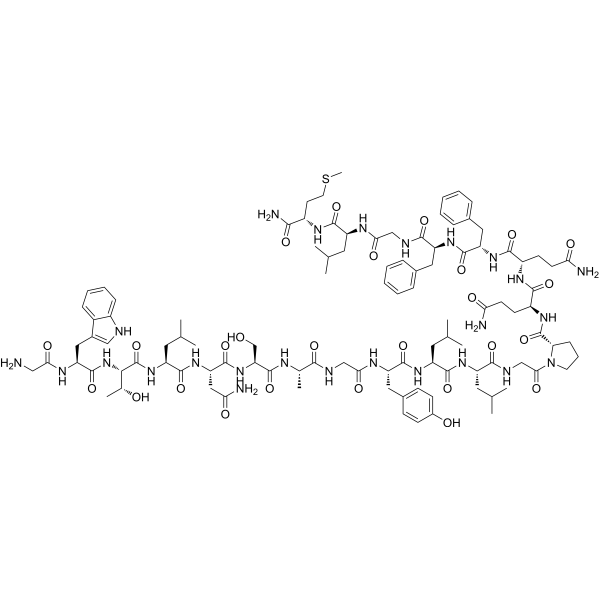
- HY-145814
-
|
|
HSP
Fungal
|
Infection
|
|
HSP90-IN-9 is a potent and selective HSP90 inhibitor. HSP90-IN-9 displays a fungicidal effect in a dose-dependent manner. HSP90-IN-9 inhibits fungal biofilm formation and fungal morphological changes after being combined with FLC. HSP90-IN-9 recovers FLC resistance by down-regulating the expression of related genes (ERG11, CDR1 and CDR2) .
|
-

- HY-143472
-
|
|
PI3K
Akt
Apoptosis
|
Cancer
|
|
PI3Kδ-IN-11 is a highly potent and selective PI3Kδ inhibitor with IC50 value of 27.5 nM. PI3Kδ-IN-11 dose-dependently blocks the activity of PI3K/Akt pathway. PI3Kδ-IN-11 can be used for researching B or T cell-related malignancies .
|
-
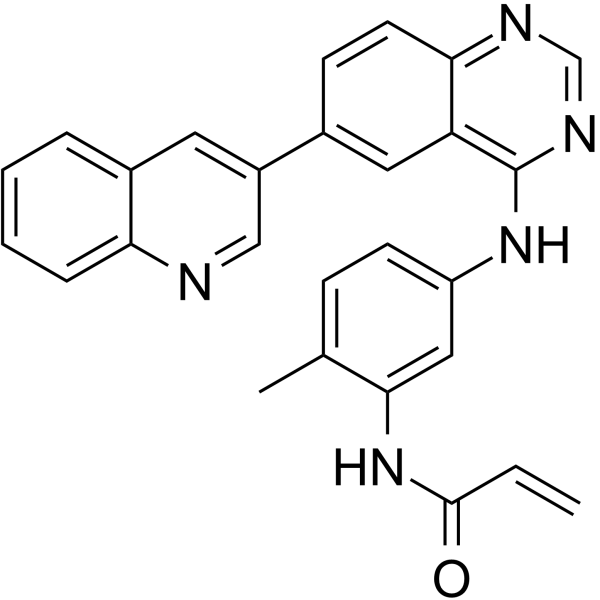
- HY-151285
-
|
|
Apoptosis
JAK
|
Inflammation/Immunology
Cancer
|
|
JAK-2-/3-IN-3 (compound ST4j) is a potent JAK2/3 inhibitor with IC50s of 13.00 and 14.86 nM for JAK2 and JAK3, respectively. JAK-2-/3-IN-3 inhibits autophosphorylation of JAK2 and induces apoptosis in a dose- and time-dependent manner. JAK-2-/3-IN-3 can be used in studies of lymph derived diseases and leukemia .
|
-
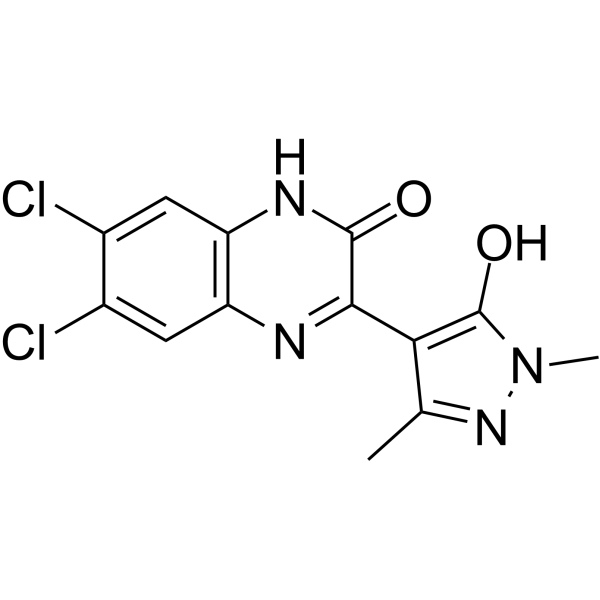
- HY-106224B
-
|
Hypocretin-1 (human, rat, mouse) (acetate)
|
Orexin Receptor (OX Receptor)
|
Neurological Disease
|
|
Orexin A (Hypocretin-1) (human, rat, mouse) acetate is a hypothalamic neuropeptide with analgesic properties (crosses the blood-brain barrier). Orexin A (human, rat, mouse) acetate is also an OX1R agonist that induces the expression of BDNF and TH proteins in SH-SY5Y cells in a time- and dose-dependent manner. Orexin A (human, rat, mouse) acetate can be used in studies of appetite regulation, neurodegenerative diseases and modulation of injurious messaging .
|
-

- HY-151799
-
|
|
p62
E1/E2/E3 Enzyme
|
Cancer
|
|
Antitumor agent-81 (compound 5a) is a low cytotoxic P62-RNF168 agonist that promotes the interaction of P62 with RNF168. Antitumor agent-81 induces a decrease in RNF168-mediated H2A ubiquitination and impairs homologous recombination-mediated DNA repair. Antitumor agent-81 also inhibits mice xenograft tumor growth in a dose-dependent manner .
|
-
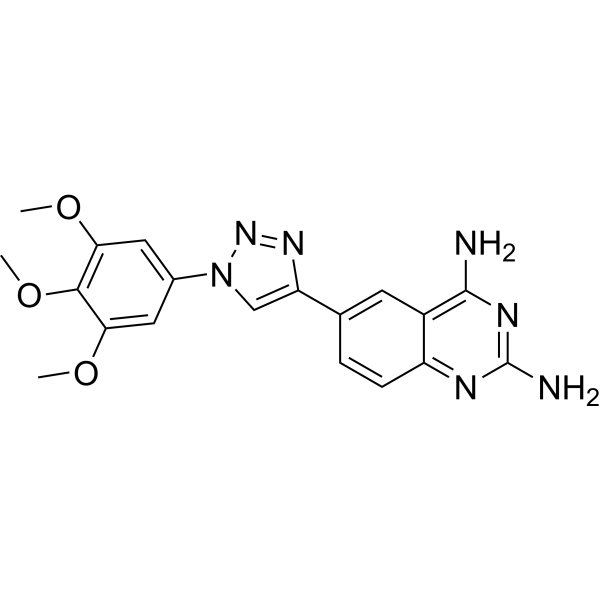
- HY-P4641
-
|
|
Angiotensin-converting Enzyme (ACE)
|
Cardiovascular Disease
|
|
H-Trp-Phe-OH is a dipeptide consisting of tryptophan and phenylalanine (Trp-Phe). H-Trp-Phe-OH is also an antihypertensive peptide with inhibitory activity on angiotensin-converting enzyme (ACE), dose-dependently increases NO levels, and decreases endothelin-1 (ET-1) levels. H-Trp-Phe-OH (2 mg/kg; subcutaneous injection; 6 injections over 3 days) causes an increase in ovarian weight in female mice .
|
-
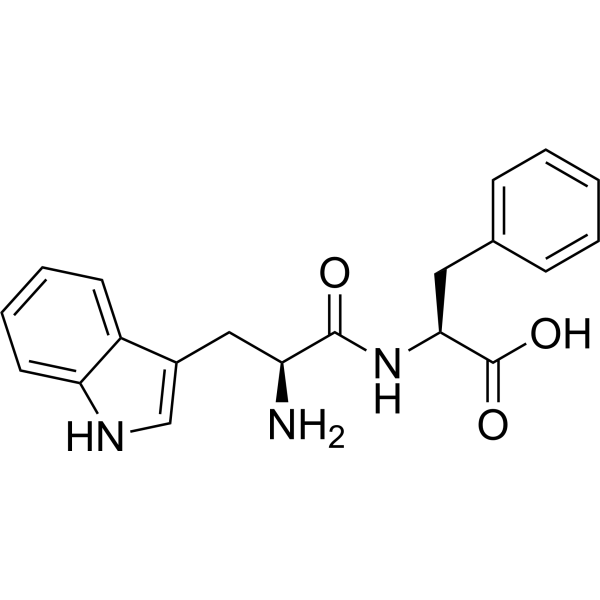
- HY-107655
-
|
ABET
|
mAChR
|
Cardiovascular Disease
|
|
Arecaidine but-2-ynyl ester tosylate (ABET) is a selective mAChR M2 agonist that dose-dependently decreases mean arterial pressure and heart rate in rats. Arecaidine but-2-ynyl ester tosylate can be used for cardiovascular disease research . Arecaidine but-2-ynyl ester (tosylate) is a click chemistry reagent, it contains an Alkyne group and can undergo copper-catalyzed azide-alkyne cycloaddition (CuAAc) with molecules containing Azide groups.
|
-
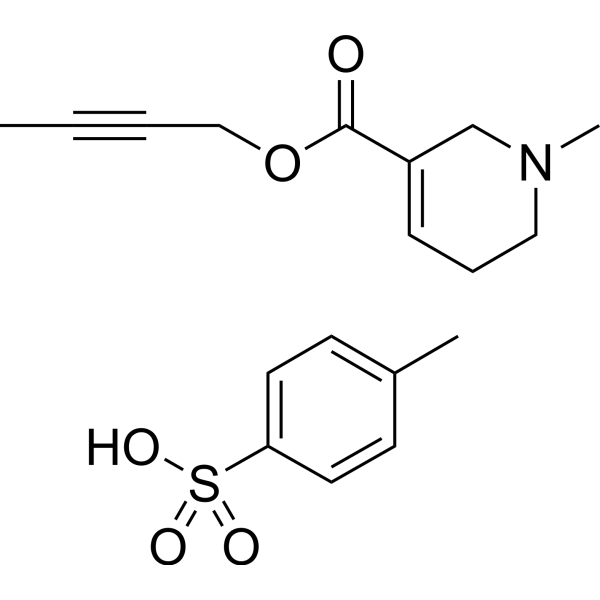
- HY-P4984
-
|
|
Biochemical Assay Reagents
|
Inflammation/Immunology
Cancer
|
|
Toxic Shock Syndrome Toxin-1 (TSST-1) (58-78) is a T cell proliferation activator. Toxic Shock Syndrome Toxin-1 (TSST-1) (58-78) promotes the in vitro proliferation of human peripheral blood mononuclear cells (PBMC) in a dose-dependent manner. Toxic Shock Syndrome Toxin-1 (TSST-1) (58-78) can be used in research on inflammatory and immunity, as well as cancer .
|
-

- HY-162011
-
|
|
EBI2/GPR183
|
Inflammation/Immunology
|
|
GPR183 antagonist-2 (compound 32) is a selective GPR183 antagonist with good water solubility and excellent pharmacokinetic properties. GPR183 antagonist-2 significantly reduces paw and joint swelling and gene expression of pro-inflammatory cytokines (MCP-1, MMPs, and VEGF) in a collagen-induced arthritis (CIA) mouse model in a dose-dependent manner. GPR183 antagonist-2 can be used in the study of autoimmune diseases .
|
-

- HY-N0303
-
|
|
Mitochondrial Metabolism
Apoptosis
|
Neurological Disease
|
|
Idebenone, a well-appreciated mitochondrial protectant, exhibits protective efficacy against neurotoxicity and can be used for the research of Alzheimer's disease, Huntington's disease. Idebenone (oxidised form) has a dose-dependent inhibitory effect on the enzymatic metabolism of arachidonic acid in astroglial homogenates (IC50=16.65 μM) . Idebenone, a coenzyme Q10 analog and an antioxidant, induces apoptotic cell death in the human dopaminergic neuroblastoma SHSY-5Y cells . Idebenone quickly crosses the blood-brain barrier.
|
-

- HY-118304
-
|
|
FLT3
Apoptosis
Caspase
|
Cancer
|
|
AKN-028, a novel tyrosine kinase (TK) inhibitor, is a potent, orally active FMS-like receptor tyrosine kinase 3 (FLT3) inhibitor with an IC50 value of 6 nM. AKN-028 inhibits FLT3 autophosphorylation. AKN-028 induces dose-dependent cytotoxic response (mean IC50=1 μM). AKN-028 induces apoptosisby activation of caspase 3. AKN-028 can be used in research of acute myeloid leukemia (AML) .
|
-
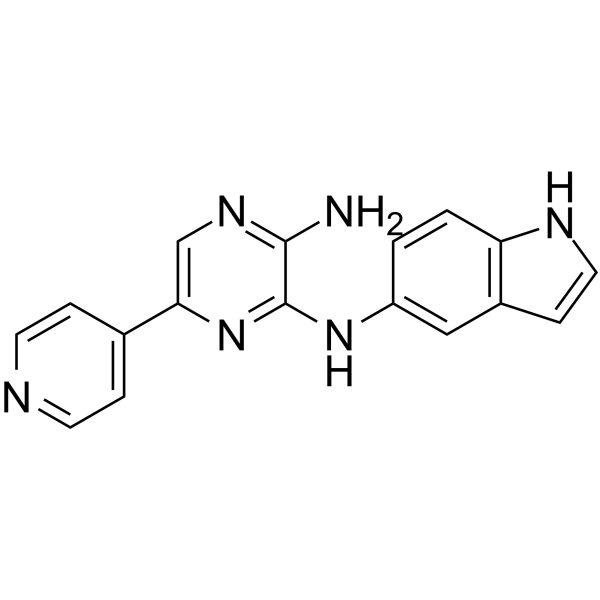
- HY-N9182
-
|
Physalien
|
Adiponectin Receptor
P2X Receptor
Autophagy
|
Inflammation/Immunology
|
|
Zeaxanthin dipalmitate (Physalien) is a wolfberry-derived carotenoid, has anti-inflammatory and anti-oxidative stress effects. Zeaxanthin dipalmitate directly interact with p2X7 receptor (Kd=81.2 nM) and adiponectin receptor 1 (AdipoR1; Kd=533 nM) in a positive dose-dependent manner. Zeaxanthin dipalmitate restores mitochondrial autophagy functions suppressed by ethanol intoxication. Zeaxanthin dipalmitate can be used in the research of alcoholic fatty liver disease (AFLD) and retinitis pigmentosa (RP) .
|
-

- HY-108020
-
|
|
Free Fatty Acid Receptor
|
Endocrinology
|
|
LY2881835 is a potent and selective agonist of G protein-coupled receptor 40 (GPR40). LY2881835 has efficacious and durable dose-dependent reductions in glucose levels along with significant increases in insulin and GLP-1 secretion. LY2881835 has the potential for the research of type 2 diabetes mellitus . LY2881835 is a click chemistry reagent, it contains an Alkyne group and can undergo copper-catalyzed azide-alkyne cycloaddition (CuAAc) with molecules containing Azide groups.
|
-

- HY-146221
-
|
|
DYRK
|
Neurological Disease
|
|
Dyrk1A-IN-5 (compound 5j) is a potent and selective DYRK1A inhibitor, with an IC50 of 6 nM. Dyrk1A-IN-5 dose-dependently reduces the phosphorylation of Thr434 in SF3B1, with an IC50 of 0.5 μM. Dyrk1A-IN-5 inhibits phosphorylation of tau at Thr212, with an IC50 of 2.1 μM. Dyrk1A-IN-5 can be used for Down syndrome research .
|
-
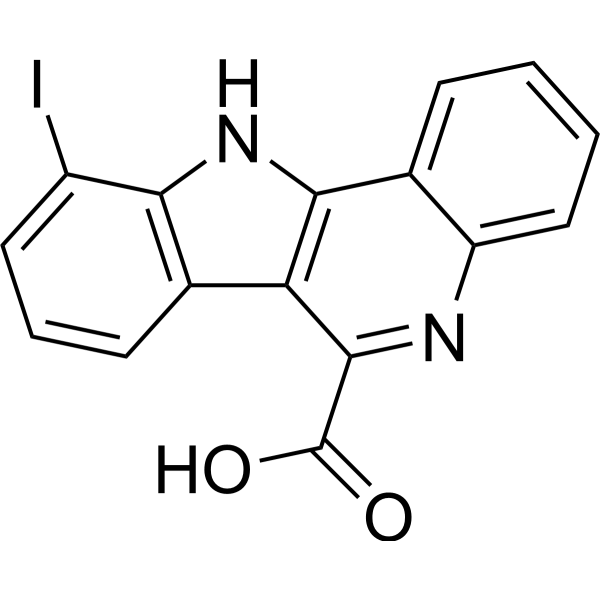
- HY-118304B
-
|
|
FLT3
Apoptosis
Caspase
|
Cancer
|
|
AKN-028 acetate, a novel tyrosine kinase (TK) inhibitor, is a potent, orally active FMS-like receptor tyrosine kinase 3 (FLT3) inhibitor with an IC50 value of 6 nM. AKN-028 acetate inhibits FLT3 autophosphorylation. AKN-028 acetate induces dose-dependent cytotoxic response (mean IC50=1 μM). AKN-028 acetate induces apoptosisby activation of caspase 3. AKN-028 acetate can be used in research of acute myeloid leukemia (AML).
|
-

- HY-N11910
-
|
|
Biochemical Assay Reagents
|
Others
|
|
Kaempferol-3-O-[(6-caffeoyl)-β-glucopyranosyl (1→3) α-rhamnopyranoside]-7-O-α-rhamnopyranoside (Compound 3) is a wound healing agent with dose-dependent wound healing ability. Kaempferol-3-O-[(6-caffeoyl)-β-glucopyranosyl (1→3) α-rhamnopyranoside]-7-O-α-rhamnopyranoside can be used for wound repair research .
|
-
![Kaempferol-3-O-[(6-caffeoyl)-β-glucopyranosyl (1→3) α-rhamnopyranoside]-7-O-α-rhamnopyranoside](//file.medchemexpress.com/product_pic/hy-n11910.gif)
- HY-157325
-
|
|
RIP kinase
|
Inflammation/Immunology
|
|
RIPK2-IN-5 (compound 14) is a high affinity and excellent selectivity RIPK2 inhibitor with an IC50 value of 5.1nM. RIPK2-IN-5 has cellular anti-inflammatory effect and can reduce the secretion of MDP-induced TNF-α with a dose-dependent manner. RIPK2-IN-5 shows moderate stability in human liver microsome. RIPK2-IN-5 can be used for the research of immune diseases .
|
-
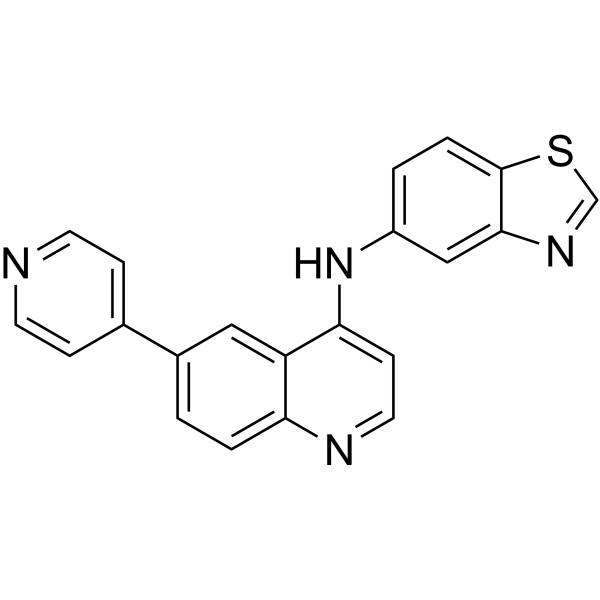
- HY-158031
-
|
|
Apoptosis
Polo-like Kinase (PLK)
Epigenetic Reader Domain
|
Cancer
|
|
PLK1/BRD4-IN-5 (Compound SC10) is an orally active PLK1 and BRD4 inhibitor with IC50 values of 0.3 nM and 60.8 nM, respectively. PLK1/BRD4-IN-5 can induce MV4-11 cell block in S phase and apoptosis) in a dose-dependent manner. PLK1/BRD4-IN-5 can be used in cancer research .
|
-
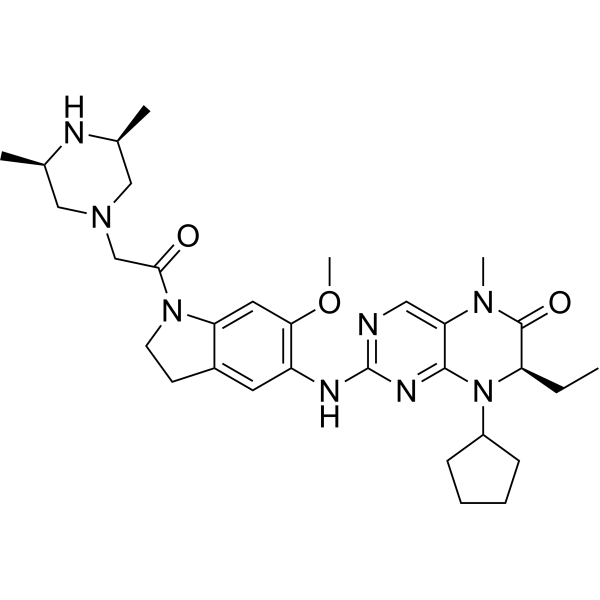
- HY-13438
-
|
|
Beta-secretase
|
Cancer
|
|
AZD3839 free base is a potent and selective orally active, brain-permeable BACE1 inhibitor (Ki=26 nM). AZD3839 free base shows 14 and >1000-fold selectivity against BACE2 and cathepsin D, respectively. AZD3839 free base exhibits dose- and time-dependent lowering of plasma, brain, and cerebrospinal fluid Aβ levels in mouse, guinea pig, and non-human primate. AZD3839 free base can be used for the research of Alzheimer's disease .
|
-

- HY-113439S
-
|
|
Apoptosis
|
Cardiovascular Disease
Inflammation/Immunology
|
|
12-HETE-d8 is the deuterium labeled 12-HETE. 12-HETE, a major metabolic product of arachidonic acid using 12-LOX catalysis, inhibits cell apoptosis in a dose-dependent manner. 12-HETE promotes the activation and nuclear translocation of NF-κB through the integrin-linked kinase (ILK) pathway[1].12-HETE has both anti-thrombotic and pro-thrombotic effects[2]. 12-HETE is a neuromodulator[3].
|
-
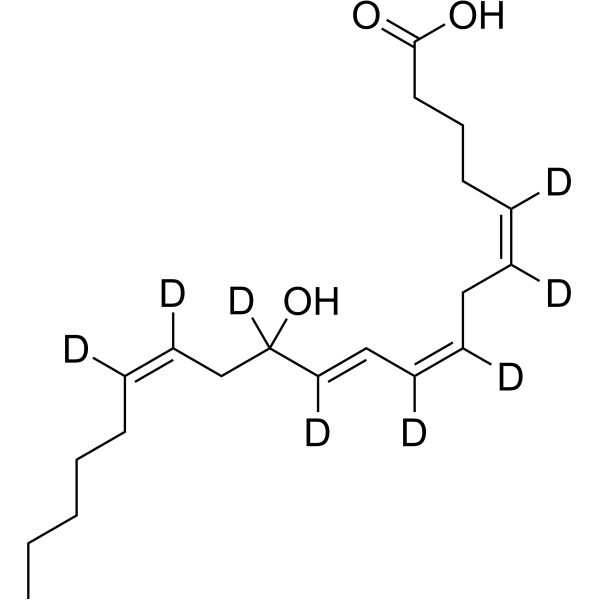
- HY-123972
-
|
KL-2
|
Others
|
Cancer
|
|
SEC inhibitor KL-2 (KL-2), a peptidomimetic lead compound, is a potent, selective super elongation complex (SEC) inhibitor and disrupts the interaction between the SEC scaffolding protein AFF4 and P-TEFb, resulting in impaired release of Pol II from promoter-proximal pause sites and a reduced average rate of processive transcription elongation. SEC inhibitor KL-2 exhibits an dose-dependent inhibitory effect on AFF4-CCNT1 interaction with a Ki of 1.50 μM .
|
-
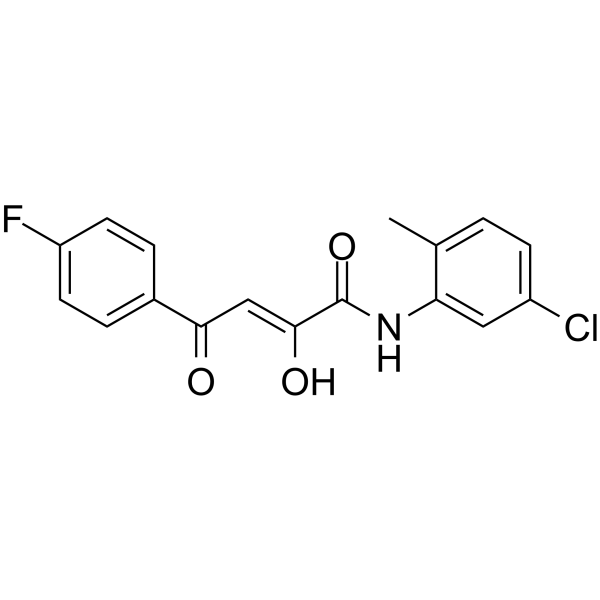
- HY-122720
-
|
KL-1
|
Others
|
Cancer
|
|
SEC inhibitor KL-1 (KL-1), a peptidomimetic lead compound, is a potent, selective super elongation complex (SEC) inhibitor and disrupts the interaction between the SEC scaffolding protein AFF4 and P-TEFb, resulting in impaired release of Pol II from promoter-proximal pause sites and a reduced average rate of processive transcription elongation. SEC inhibitor KL-1 exhibits an dose-dependent inhibitory effect on AFF4-CCNT1 interaction with a Ki of 3.48 μM .
|
-

- HY-144730
-
|
|
HIV
|
Inflammation/Immunology
|
|
gp120-IN-1 (compound 4e) is a potent HIV-1 gp120 inhibitor with an IC50 of 2.2 µM and CC50 of 100.90 µM. gp120-IN-1 shows anti-HIV-1 activity. gp120-IN-1 shows cytotoxicity in a dose dependent manner in SUP-T1 cells. gp120-IN-1 shows inhibition of gp120-mediated virus enter into cells .
|
-
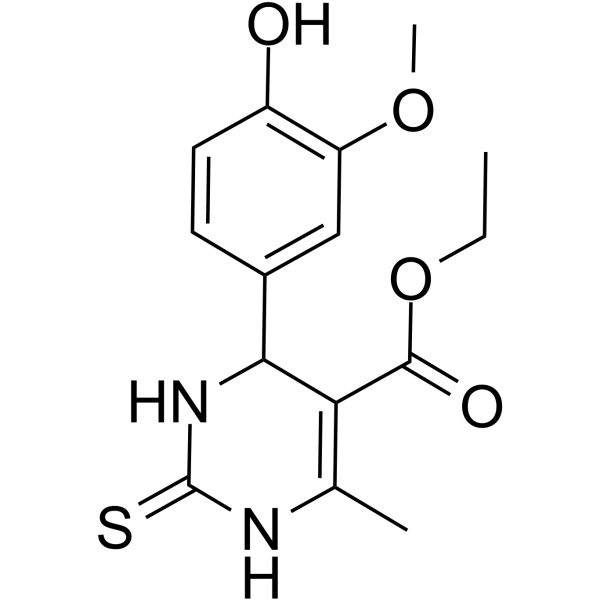
- HY-146169
-
|
|
Reactive Oxygen Species
Microtubule/Tubulin
|
Cancer
|
|
Antitumor agent-68 is a potent tubulin inhibitor. Antitumor agent-68 shows potent anticancer activity with IC50s of 3.6 and 3.8 μM for HeLa and MCF-7 cells, respectively. Antitumor agent-68 exhibits good scavenging activity of ROS and DPPH radical in a dose-dependent manner . Antitumor agent-68 is a click chemistry reagent, it contains an Alkyne group and can undergo copper-catalyzed azide-alkyne cycloaddition (CuAAc) with molecules containing Azide groups.
|
-
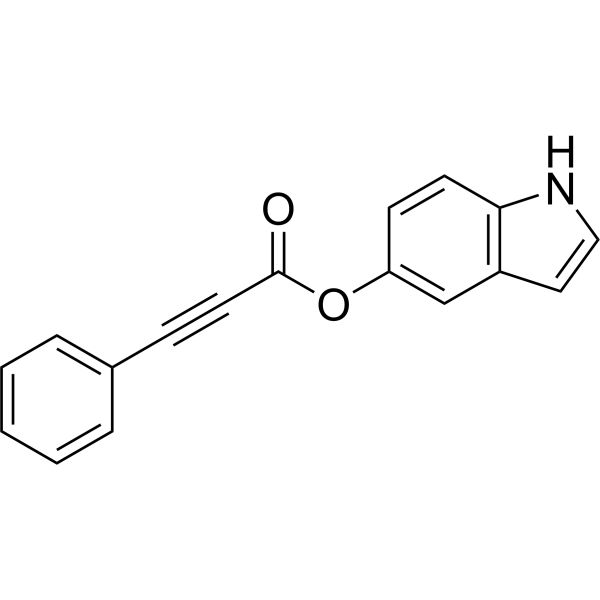
- HY-144668
-
|
|
Influenza Virus
|
Infection
|
|
RdRP-IN-4 (compound 11q), an aryl benzoyl hydrazide analog, is an orally active influenza A virus RNA-dependent RNA polymerase (RdRp) inhibitor by interacting with the PB1 subunit. RdRP-IN-4 exhibits potent inhibitory activity against the avian H5N1 flu strain with an EC50 of 18 nM in MDCK cells. RdRP-IN-4 displays excellent potency against the the H1N1 (A/PR/8/34) Flu A strain and Flu B strain (B/Lee/1940) with EC50 values of 53 nM and 20 nM, respectively. RdRP-IN-4 significantly inhibits the expression level of viral nucleoprotein (NP) in a dose-dependent manner. RdRP-IN-4 exhibits significant antiviral activity in infected mice .
|
-

- HY-12624
-
|
ON123300
|
CDK
AMPK
PDGFR
|
Cancer
|
|
Narazaciclib (ON123300), a strong and brain-penetrant multi-kinase inhibitor, inhibits CDK4 (IC50=3.9 nM), Ark5 (IC50=5 nM), PDGFRβ (IC50=26 nM), FGFR1 (IC50=26 nM), RET (IC50=9.2 nM), and FYN (IC50=11 nM). Single agent Narazaciclib causes a dose-dependent suppression of phosphorylation of Akt as well as activation of Erk in brain tumors . Narazaciclib inhibits CDK6 with an IC50 of 9.82 nM .
|
-
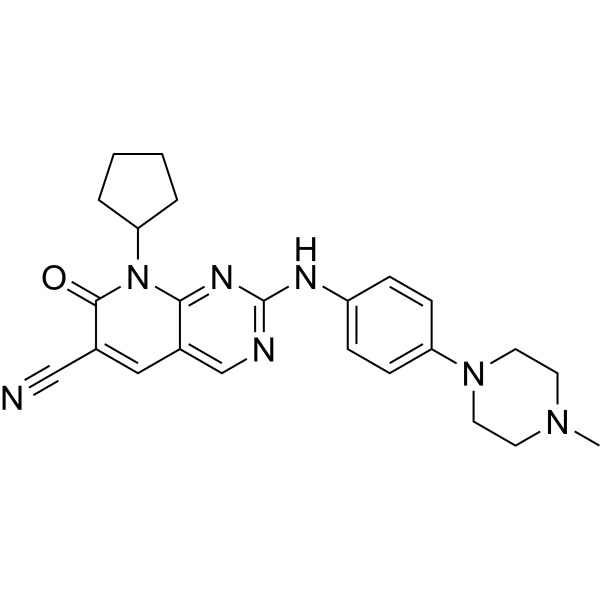
- HY-N10439
-
|
|
Glucosidase
|
Inflammation/Immunology
|
|
3β-Acetoxy-hop-22(29)-ene (compound 1) is a potent anti-inflammatory agent. 3β-Acetoxy-hop-22(29)-ene shows high inhibitory activity of yeast α-glucosidase, with an IC50 of 5.74 μM. 3β-Acetoxy-hop-22(29)-ene inhibits MPO (myeloperoxidase) activity in a dose-dependent manner in mouse ear edema model induced by 12-O-tetradecanoylphorbol acetate (TPA), with an IC50 of 0.23 μmol/ear .
|
-
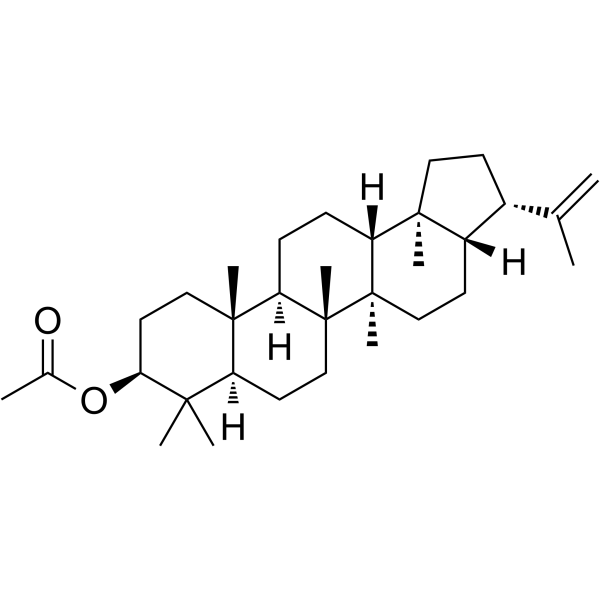
- HY-155027
-
|
|
Dipeptidyl Peptidase
TNF Receptor
Interleukin Related
|
Inflammation/Immunology
Cancer
|
|
DPP-4-IN-8 (compound 27) is a potent and selective DPP4 (dipeptidyl peptidase 4) inhibitor, with a Ki of 0.96 μM. DPP-4-IN-8 blocks the dipeptidase activity of DPP4 in both Caco-2 and HepG-2 cells. DPP-4-IN-8 also dose-dependently suppresses the expression levels of the chemokines tumor necrosis factor-α (TNF-α), interleukin-6 (IL-6), and interleukin-1β (IL-1β) .
|
-
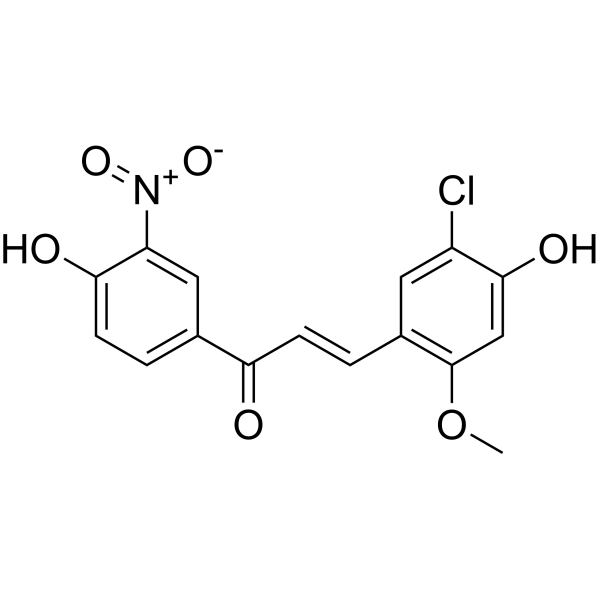
- HY-19210
-
|
|
Endothelin Receptor
|
Cardiovascular Disease
|
|
SB-209670 is an extremely potent and highly specific non-peptide, subnanomolar endothelin (ET) receptor antagonist. SB 209670 selectively inhibits binding of 125I-labeled ET-1 to cloned human ET receptor subtypes ETA and ETB (Ki=0.2 and 18 nM, respectively). SB 209670 produces a dose-dependent reduction in blood pressure in hypertensive rats, protects from ischemia-induced neuronal degeneration in a gerbil stroke model, and attenuates neointima formation following rat carotid artery balloon angioplasty .
|
-
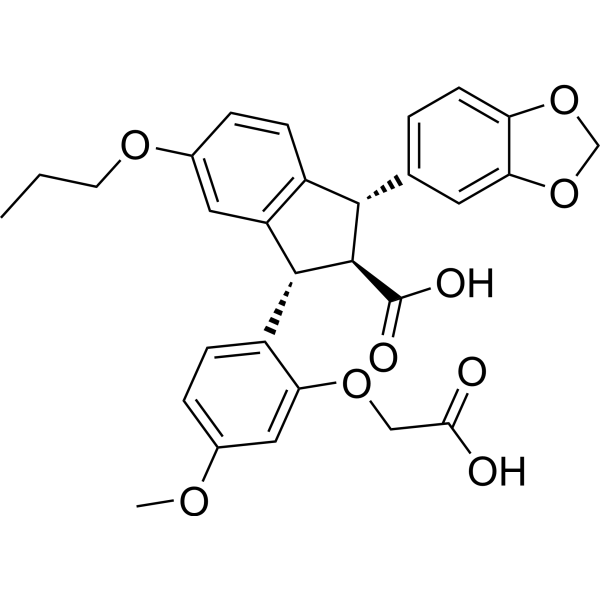
- HY-148252
-
|
|
Adrenergic Receptor
|
Endocrinology
|
|
ADRA1D receptor antagonist 1 (free base) (compound (R)-9s) is an orally active, potent and selective human α1D-adrenoceptor (α1D-AR) antagonist (Ki=1.6 nM). ADRA1D receptor antagonist 1 (free base) dose-dependently inhibits bladder contraction with an IC30 value of 15 nM. ADRA1D receptor antagonist 1 (free base) can be used in studies of overactive bladder disorders such as urinary urgency, frequency and incontinence.
|
-
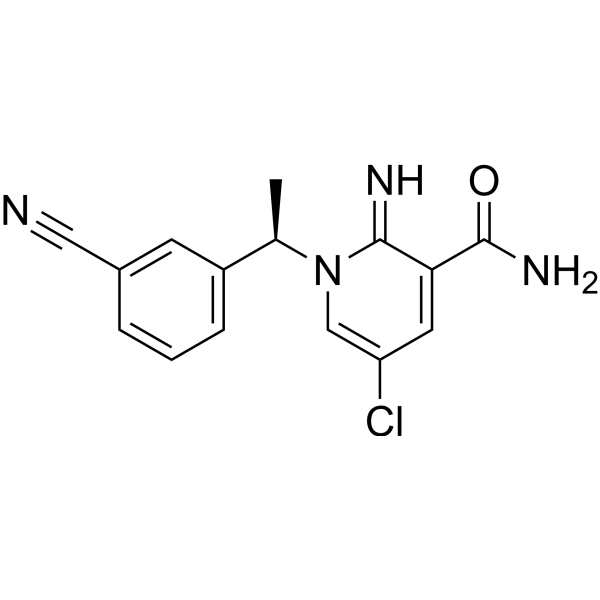
- HY-12443
-
|
|
Casein Kinase
|
Neurological Disease
|
|
PF-5006739 is a potent and selective inhibitor of CK1δ/ε with IC50s of 3.9 nM and 17.0 nM, respectively. PF-5006739 is a potential therapeutic agent for a range of psychiatric disorders with low nanomolar in vitro potency for CK1δ/ε and high kinome selectivity. PF-5006739 attenuats opioid agent-seeking behavior in a rodent operant reinstatement model in animals in a dose-dependent manner . PF-5006739 improves glucose tolerance in both diet-induced obesity (DIO) and genetic (ob/ob) mice models of obesity .
|
-

- HY-W007223
-
|
D-5-HTP; 5-Hydroxy-D-tryptophan
|
Others
5-HT Receptor
|
Neurological Disease
|
|
D-5-Hydroxytryptophan (D-5-HTP) is the D-isomer of 5-HTP and can be isolated from DL-5-hydroxytryptophan by continuous separation. Compared with intraperitoneal administration of L-5-Hydroxytryptophan, which can induce dose-dependent backward walking behavior in mice, D-5-Hydroxytryptophan has no significant effect on mouse behavior and is a negative control. D-5-Hydroxytryptophan is also a 5-HT ligand, capable of binding to the 5-HT site with affinity in the micromolar range .
|
-
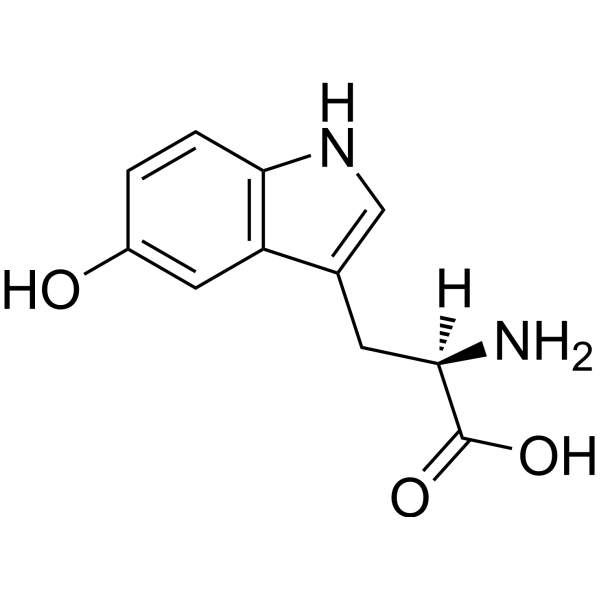
- HY-155066
-
|
|
PI3K
mTOR
|
Cancer
|
|
FD274 is a highly potent PI3K/mTOR dual inhibitor with IC50s of 0.65 nM, 1.57 nM, 0.65 nM, 0.42 nM, and 2.03 nM against PI3Kα/β/γ/δ and mTOR, respectively. FD274 exhibits significant anti-proliferation of AML cell lines (HL-60 and MOLM-16). FD274 demonstrates dose-dependent inhibition of tumor growth in the HL-60 xenograft model. FD274 has the potential for acute myeloid leukemia research .
|
-
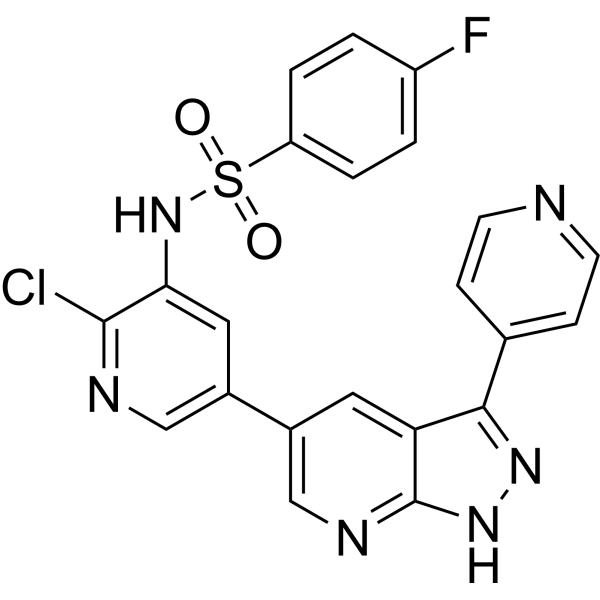
- HY-157164
-
|
|
PROTACs
Histone Methyltransferase
|
Cancer
|
|
PROTAC EZH2 Degrader-2 (compound E-3P-MDM2), an EZH2 inhibitor, is a PROTAC composed of Tazemetostat (EPZ6438) and an E3 ligase system ligand. PROTAC EZH2 Degrader-2 degrades EZH2 in SU-DHL-6 cells in a dose-dependent manner, inhibits the expression of H3K27me3, and simultaneously degrades EED and SUZ12 proteins without affecting their mRNA levels. PROTAC EZH2 Degrader-2 has anti-cancer and anti-proliferative activity .
|
-
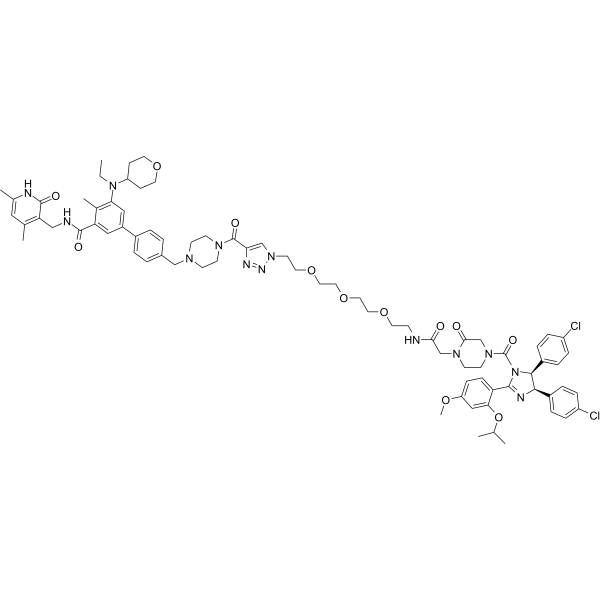
- HY-157295
-
|
|
PI3K
HDAC
|
Cancer
|
|
PI3K/HDAC-IN-3 (36) is a PI3K and HDAC dual inhibitor, with IC50 values of 0.23 nM and 172 nM for PI3Kα and HDAC1, respectively. PI3K/HDAC-IN-3 (36) suppresses AKT phosphorylation and increased H3 acetylation in MV4-11 cells. PI3K/HDAC-IN-3 (36) exhibits significant and dose-dependent anticancer efficacy in a MV4-11 xenograft model .
|
-
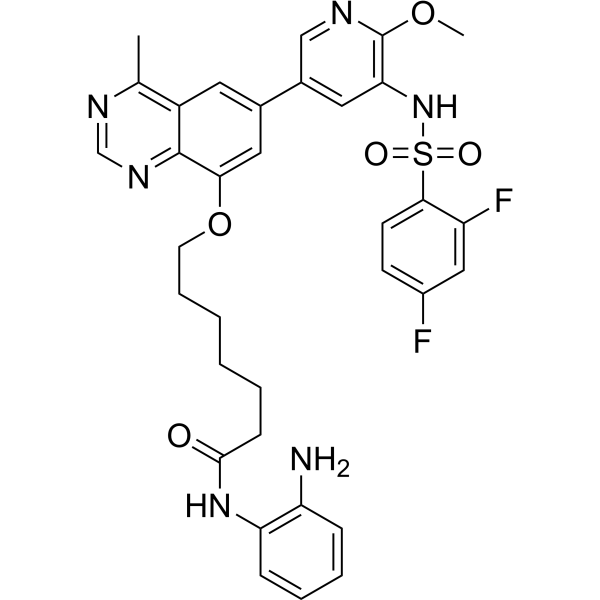
- HY-162103
-
|
|
TAM Receptor
Apoptosis
|
Cancer
|
|
Axl-IN-18 (compound 25c) is a potent and selective type II AXL inhibitor. Axl-IN-18 shows excellent AXL inhibitory activity (IC50=1.1 nM) and 343-fold selectivity over the highly homologous kinase MET in biochemical assays (IC50=377 nM). Axl-IN-18 significantly inhibits AXL-driven cell proliferation, dose-dependently suppresses 4T1 cell migration and invasion, and induces apoptosis. Axl-IN-18 shows noticeable antitumor efficacy in a BaF3/TEL-AXL xenograft model .
|
-

- HY-N6954
-
|
|
ATM/ATR
STAT
CDK
|
Cancer
|
|
Garcinone C, a xanthone derivative, is a natural compound extracted from Garcinia oblongifolia that is used as an anti-inflammatory, astringency and granulation-promoting medicine, and has potential cytotoxic effects on certain cancers. Garcinone C stimulates the expression levels of ATR and 4E-BP1, while efficiently inhibiting the expression levels of cyclin B1, cyclin D1, cyclin E2, cdc2, Stat3 and CDK7. Garcinone C significantly inhibits cell viability of the human Nasopharyngeal carcinoma (NPC) cell lines CNE1, CNE2, HK1 and HONE1 in a time‑ and dose‑dependent manner .
|
-
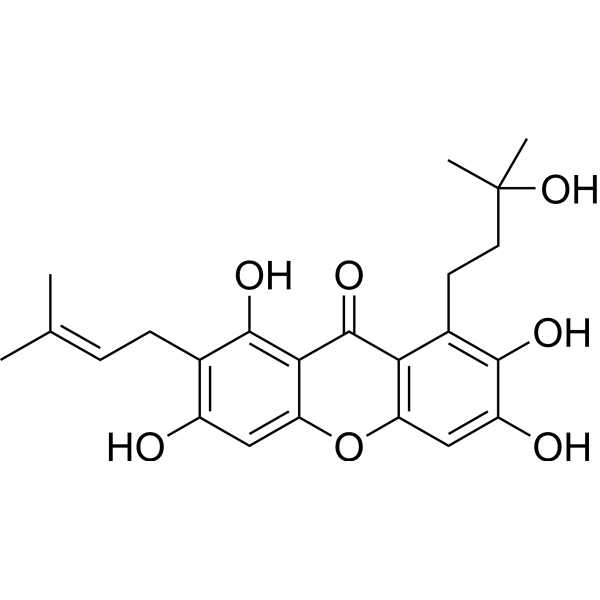
- HY-P5900
-
|
m3-HwTx-IV
|
Sodium Channel
|
Neurological Disease
|
|
m3-Huwentoxin IV (m3-HwTx-IV) is a potent NaV inhibitor with IC50s of 3.3, 6.8, 7.2, 8.4, 11.9 and 369 nM against hNaV1.7, hNaV1.6, hNaV1.3, hNaV1.1, hNaV1.2 and hNaV1.4, respectively in QPatch assay. m3-Huwentoxin IV dose-dependently suppresses spontaneous pain induced by the NaV1.7 activator OD1 in a rodent pain model .
|
-

- HY-149010
-
|
|
Keap1-Nrf2
|
Neurological Disease
|
|
NXPZ-2 is an orally active Keap1-Nrf2 protein–protein interaction (PPI) inhibitor with a Ki value of 95 nM, EC50 value of 120 and 170 nM. NXPZ-2 can dose-dependently ameliorate Aβ[1-42]-Induced cognitive dysfunction, improve brain tissue pathological changes in Alzheimer’s disease (AD) mouse by increasing neuron quantity and function. NXPZ-2 can inhibit oxidative stress by increasing Nrf2 expression levels and promoting its cytoplasm to nuclear translocation, which is helpful for Keap1-Nrf2 PPI inhibitors and AD associated disease research .
|
-

- HY-113953
-
|
|
Caspase
Apoptosis
|
Inflammation/Immunology
|
|
Z-Asp-CH2-DCB is an irreversible broad spectrum caspase inhibitor. Z-Asp-CH2-DCB also inhibits proteases with caspase-like activity. Z-D-CH2-DCB blocks the production of IL-1β, TNF-α, IL-6, and IFN-γ in staphylococcal enterotoxin B (SEB)-stimulated peripheral blood mononuclear cells (PBMC), and reduces SEB-1-stimulated T-cell proliferation in a dose-dependent manner. Z-Asp-CH2-DCB prevents SU5416-induced septal cell apoptosis and emphysema development .
|
-
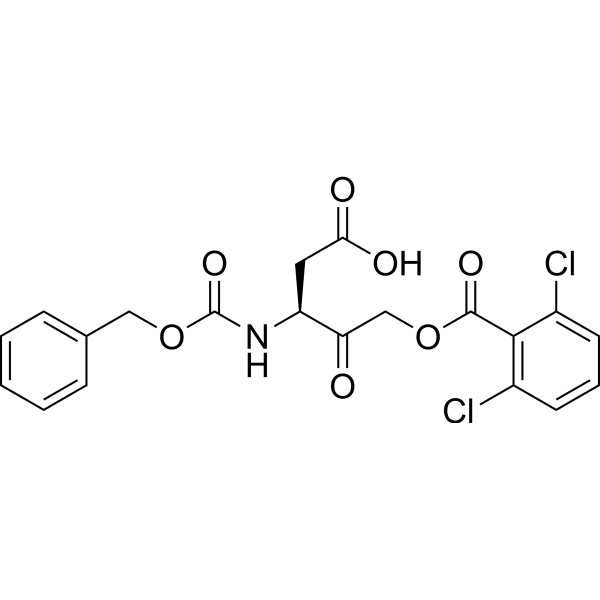
- HY-143494
-
|
|
RSV
Influenza Virus
|
Infection
|
|
RSV/IAV-IN-3 (compound 14'i) is a dual inhibitor of respiratory syncytial virus (RSV) and influenza A virus (IAV) with EC50 values of 2.92 µM and 1.90 µM,respectively. RSV/IAV-IN-3 has antiviral effect against H1N1 and H3N2 with EC50 values of 3.25 µM and 1.50 µM in MDCK cells, respectively. RSV/IAV-IN-3 significantly inhibits the activity of luciferase in a dose-dependent manner, with an EC50 of 3.89 µM. RSV/IAV-IN-3 inhibits IAV infectivity and RdRp activity. RSV/IAV-IN-3 inhibits IAV and RSV replication at the post-entry stage .
|
-
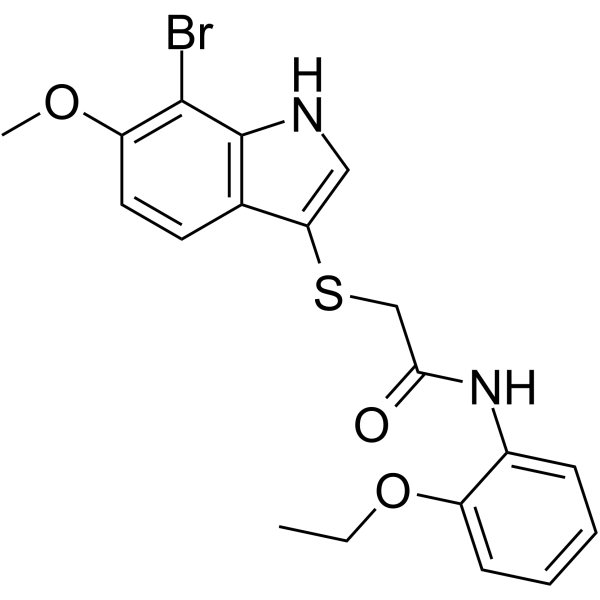
- HY-147862
-
|
|
EGFR
Apoptosis
|
Cancer
|
|
EGFR-IN-62 (compound 9h) is a potent and reversible EGFR kinase inhibitor, with IC50 values of 10 nM (L858R/T790 M), 29 nM (WT), and 242 nM (L858R/T790 M/C797S), respectively. EGFR-IN-62 shows antiproliferative activity against A549 and H1975 cell lines, with IC50 values of 2.53 and 1.56 μM, respectively. EGFR-IN-62 induces dose-dependent apoptosis process, G1/G0-phase arrestation, and the inhibition of motility on A549 and/or H1975 cell lines .
|
-

| Cat. No. |
Product Name |
Type |
-
- HY-137131
-
|
DC-Cholesterol hydrochloride
|
Drug Delivery
|
|
DC-Chol hydrochloride could inhibit Aβ40 fibril formation under appropriate experimental conditions. DC-Chol hydrochloride strongly inhibits amyloidogenesis of oxidized hCT in a dose-dependent manner .
|
-
- HY-W127334
-
|
|
Biochemical Assay Reagents
|
|
N-Palmitoyl phosphatidylethanolamine (Tripelargonin) is endogenous lipid anorectic hormone, significantly reduces food intake in a dose-dependent manner
|
| Cat. No. |
Product Name |
Target |
Research Area |
-
- HY-P2026
-
|
|
Peptides
|
Cardiovascular Disease
|
|
A 71915 is a highly potent and competitive natriuretic peptide receptor A (ANP, NPRA) antagonist (pKi= 9.18). A 71915 displaces [ 125I]ANP dose dependently, with a Ki of 0.65 nM. A71915( pA2= 9.48) against rat ANP-induced cGMP production in NB-OK-1 cells .
|
-
- HY-P1086
-
|
|
Peptides
|
Others
|
|
Cadherin Peptide, avian is a calcium-dependent glycoprotein. Cadherin Peptide, avian takes part in homophilic cell-cell adhesion and dose-dependently inhibits bovine brain microvessel endothelial cells (BBMECs) adhesion .
|
-
- HY-P0249
-
-
- HY-P0249B
-
-
- HY-P3030
-
|
|
Peptides
|
Inflammation/Immunology
|
|
CPN-219, a next-generation hexapeptidic NMUR2 agonist, achieves a dose-dependent and selective activation of NMUR2 with an EC50 value of 2.2 nM .
|
-
- HY-P3730
-
|
|
CDK
|
Cancer
|
|
Cdk2/Cyclin Inhibitory Peptide I (Tat-LFG), a CDK2 inhibitor, kills U2OS osteosarcoma cells in a dose-dependent manner .
|
-
- HY-P5921
-
|
TsTx-Kα
|
Peptides
|
Neurological Disease
|
|
Tityustoxin-Kα (TsTx-Kα) is an inhibitor of potassium voltage-gated channels. Tityustoxin-Kα shows a dose-dependent block of the sustained outward current in cultured hippocampal neurons .
|
-
- HY-P2080
-
|
|
Insulin Receptor
|
Metabolic Disease
|
|
GIP (1-30) amide,human is a glucose-dependent insulinotropic polypeptide (GIP) fragment. GIP is an incretin hormone that stimulates insulin secretion and reduces postprandial glycaemic excursions. GIP (1-30) amide,human dose-dependently promotes insulin secretion over the range 10 -9-10 -6 M .
|
-
- HY-P2080B
-
|
|
Insulin Receptor
|
Metabolic Disease
|
|
GIP (1-30) amide,human acetate is a glucose-dependent insulinotropic polypeptide (GIP) fragment. GIP is an incretin hormone that stimulates insulin secretion and reduces postprandial glycaemic excursions. GIP (1-30) amide,human acetate dose-dependently promotes insulin secretion over the range 10 -9-10 -6 M .
|
-
- HY-107627
-
|
|
Melanocortin Receptor
|
Inflammation/Immunology
|
|
MCL0020 is a potent and selective melanocortin MC4 receptor antagonist, with an IC50 of 11.63 nM. MCL0020 dose-dependently and significantly attenuates restraint stress-induced anorexia without affecting food intake .
|
-
- HY-P4663
-
|
NSC 350591
|
Peptides
|
Cancer
|
|
Val-Gly-Ser-Glu (NSC 350591) is an ECF-A tetrapeptide. Val-Gly-Ser-Glu dose-dependently increases the number of human eosinophils, but not neutrophils, rosetting with complement-coated sheep erythrocytes (EAC3b) .
|
-
- HY-P10032
-
-
- HY-P2080C
-
|
|
Insulin Receptor
|
Metabolic Disease
|
|
GIP (1-30)-Myr is the Myr-modified GIP (1-30), which is a glucose-dependent insulinotropic polypeptide (GIP) fragment. GIP is an incretin hormone that stimulates insulin secretion and reduces postprandial glycaemic excursions. GIP (1-30) dose-dependently promotes insulin secretion over the range 10 -9-10 -6 M .
|
-
- HY-P3462A
-
|
|
CGRP Receptor
|
Metabolic Disease
|
|
Cagrilintide acetate is a non-selective AMYR/CTR agonist and long-acting acylated amylase analogue. Cagrilintide acetate causes a reduction in food intake and significant weight loss in a dose-dependent manner. Cagrilintide acetate can be used in obesity studies .
|
-
- HY-P2005
-
|
|
Peptides
|
Others
|
|
Malformin C is an algicidal peptide can be isolated from Aspergillus and exhibits dose-dependent algicidal activity. Malformin C induces a significant increase in ROS levels in algal cells, resulting in impaired SOD activity and high production of MDA content .
|
-
- HY-P1235A
-
|
Atrial Natriuretic Peptide (ANP) (1-28), human, porcine acetate
|
Endothelin Receptor
|
Cardiovascular Disease
Endocrinology
|
|
Carperitide acetate (Atrial Natriuretic Peptide (ANP) (1-28), human, porcine acetate) is a 28-amino acid hormone, that is normally produced and secreted by the human heart in response to cardiac injury and mechanical stretch. Carperitide acetate inhibits endothelin-1 secretion in a dose-dependent way.
|
-
- HY-P1329
-
|
|
Opioid Receptor
|
Neurological Disease
|
|
CTOP is a potent and highly selective μ-opioid receptor antagonist. CTOP antagonizes the acute morphine-induced analgesic effect and hypermotility. CTOP enhances extracellular dopamine levels in the nucleus accumbens. CTOP dose-dependently enhances locomotor activity .
|
-
- HY-P4302
-
|
Z-Phe-Lys-2,4,6-Trimethylbenzoyloxy-methylketone
|
Peptides
|
Cardiovascular Disease
|
|
Z-FK-ck (Z-Phe-Lys-2,4,6-Trimethylbenzoyloxy-methylketone) is a potent and selective gingipain-K-specific inhibitor. Z-FK-ck prolongs plasma thrombin time (TT) in a dose- and time-dependent manner .
|
-
- HY-P5859
-
|
α-PMTX
|
Biochemical Assay Reagents
|
Neurological Disease
|
|
α-Pompilidotoxin (α-PMTX) is a neurotoxin that can be obtained from the venom of Anoplius safnariensis. α-Pompilidotoxin reversibly and dose-dependently enhances excitatory postsynaptic currents (EPSCs). α-Pompilidotoxin is a useful tool in the field of neuroscience research .
|
-
- HY-P1329A
-
|
|
Opioid Receptor
|
Neurological Disease
|
|
CTOP TFA is a potent and highly selective μ-opioid receptor antagonist. CTOP TFA antagonizes the acute analgesic effect and hypermotility. CTOP TFA enhances extracellular dopamine levels in the nucleus accumbens. CTOP TFA dose-dependently enhances locomotor activity .
|
-
- HY-P0262A
-
|
|
Neuropeptide Y Receptor
|
Neurological Disease
Metabolic Disease
|
|
Galantide TFA is a reversible and non-specific galanin (GAL) receptor antagonist. Galantide TFA dose-dependently shows antagonism to galanin-induced K + conductance with an IC50 value of 4 nM. Galantide TFA can be used for the research of neurological disease and hormone metabolism research .
|
-
- HY-P10032A
-
-
- HY-P1257
-
|
|
Peptides
|
Metabolic Disease
|
|
Xenin-8, a C-terminal octapeptide, is a biologically active fragment of Xenin. Xenin is a 25-amino acid peptide of the neurotensin/xenopsin family. Xenin-8 stimulates basal insulin secretion and potentiates the insulin response to glucose in a dose-dependent manner (EC50=0.16 nM) .
|
-
- HY-P1440A
-
|
|
Potassium Channel
|
|
|
BeKm-1 TFA is a potent and selective KV11.1 (hERG) channel blocker. BeKm-1 TFA is selective for KV11.1 over a panel of 14 other potassium channels. BeKm-1 TFA dose-dependently prolongs QTc interval in isolated rabbit heart.
|
-
- HY-P1235
-
|
Atrial Natriuretic Peptide (ANP) (1-28), human, porcine
|
Endothelin Receptor
|
Cardiovascular Disease
Endocrinology
|
|
Carperitide (Atrial Natriuretic Peptide (ANP) (1-28), human, porcine) is a 28-amino acid hormone, that is normally produced and secreted by the human heart in response to cardiac injury and mechanical stretch. Carperitide (Atrial Natriuretic Peptide (ANP) (1-28), human, porcine) inhibits endothelin-1 secretion in a dose-dependent way.
|
-
- HY-P1257A
-
|
|
Peptides
|
Metabolic Disease
|
|
Xenin-8 TFA, a C-terminal octapeptide, is a biologically active fragment of Xenin. Xenin is a 25-amino acid peptide of the neurotensin/xenopsin family. Xenin-8 TFA stimulates basal insulin secretion and potentiates the insulin response to glucose in a dose-dependent manner (EC50=0.16 nM) .
|
-
- HY-P10228
-
|
|
Fungal
Bacterial
|
Infection
|
|
S-Thanatin is an insect antimicrobial peptide with potent broad-spectrum antibacterial activity. S-Thanatin can inhibit the activity of Gram-negative bacteria, Gram-positive bacteria, and fungi, without cytotoxicity. The antibacterial activity of S-Thanatin is not affected by PH value, but monovalent cations (Na +/K +) can reduce its antibacterial activity against Gram-negative bacteria in a dose-dependent manner .
|
-
- HY-P0262
-
|
|
Neuropeptide Y Receptor
|
Neurological Disease
Metabolic Disease
Inflammation/Immunology
Endocrinology
|
|
Galantide, a non-specific galanin receptor antagonist, is a peptide consisting of fragments of galanin and substance P. Galantide recognizes two classes of galanin binding sites (KD<0.1 nM and ~6 nM) in the rat hypothalamus. Galantide dose dependently (IC50=1.0 nM) antagonizes the galanin-mediated inhibition of the glucose-induced insulin secretion from mouse pancreatic islets. Galantide appears to bind to a single population of SP receptors (KD~40 nM) .
|
-
- HY-106224B
-
|
Hypocretin-1 (human, rat, mouse) (acetate)
|
Orexin Receptor (OX Receptor)
|
Neurological Disease
|
|
Orexin A (Hypocretin-1) (human, rat, mouse) acetate is a hypothalamic neuropeptide with analgesic properties (crosses the blood-brain barrier). Orexin A (human, rat, mouse) acetate is also an OX1R agonist that induces the expression of BDNF and TH proteins in SH-SY5Y cells in a time- and dose-dependent manner. Orexin A (human, rat, mouse) acetate can be used in studies of appetite regulation, neurodegenerative diseases and modulation of injurious messaging .
|
-
- HY-P4641
-
|
|
Angiotensin-converting Enzyme (ACE)
|
Cardiovascular Disease
|
|
H-Trp-Phe-OH is a dipeptide consisting of tryptophan and phenylalanine (Trp-Phe). H-Trp-Phe-OH is also an antihypertensive peptide with inhibitory activity on angiotensin-converting enzyme (ACE), dose-dependently increases NO levels, and decreases endothelin-1 (ET-1) levels. H-Trp-Phe-OH (2 mg/kg; subcutaneous injection; 6 injections over 3 days) causes an increase in ovarian weight in female mice .
|
-
- HY-P4984
-
|
|
Biochemical Assay Reagents
|
Inflammation/Immunology
Cancer
|
|
Toxic Shock Syndrome Toxin-1 (TSST-1) (58-78) is a T cell proliferation activator. Toxic Shock Syndrome Toxin-1 (TSST-1) (58-78) promotes the in vitro proliferation of human peripheral blood mononuclear cells (PBMC) in a dose-dependent manner. Toxic Shock Syndrome Toxin-1 (TSST-1) (58-78) can be used in research on inflammatory and immunity, as well as cancer .
|
-
- HY-P4121
-
|
|
Peptides
|
Metabolic Disease
|
|
L17E, an endosomolytic peptide, is a cationic amphiphilic peptide with specific membrane lytic activity for late endosomes (LEs). L17E diminishes the TS5-p45 induced apoptosis in a dose-dependent manner. L17E is endocytosed into cells and trafficked to LEs. Within the acidic environment of LEs, L17E perturbs and lyses the LE membrane, leading to disruption of LE membrane and release of LE content to the cytosol. L17E is used to investigate the role of the endosomal protein trafficking pathway .
|
-
- HY-W007223
-
|
D-5-HTP; 5-Hydroxy-D-tryptophan
|
Peptides
5-HT Receptor
|
Neurological Disease
|
|
D-5-Hydroxytryptophan (D-5-HTP) is the D-isomer of 5-HTP and can be isolated from DL-5-hydroxytryptophan by continuous separation. Compared with intraperitoneal administration of L-5-Hydroxytryptophan, which can induce dose-dependent backward walking behavior in mice, D-5-Hydroxytryptophan has no significant effect on mouse behavior and is a negative control. D-5-Hydroxytryptophan is also a 5-HT ligand, capable of binding to the 5-HT site with affinity in the micromolar range .
|
-
- HY-P5900
-
|
m3-HwTx-IV
|
Sodium Channel
|
Neurological Disease
|
|
m3-Huwentoxin IV (m3-HwTx-IV) is a potent NaV inhibitor with IC50s of 3.3, 6.8, 7.2, 8.4, 11.9 and 369 nM against hNaV1.7, hNaV1.6, hNaV1.3, hNaV1.1, hNaV1.2 and hNaV1.4, respectively in QPatch assay. m3-Huwentoxin IV dose-dependently suppresses spontaneous pain induced by the NaV1.7 activator OD1 in a rodent pain model .
|
| Cat. No. |
Product Name |
Category |
Target |
Chemical Structure |
-
- HY-N0528
-
-

-
- HY-N5099
-
-

-
- HY-N11922
-
-

-
- HY-N2383
-
|
(1R,2S,3S,4S,6R)-4-Amino-6-(hydroxymethyl)cyclohexane-1,2,3-triol
|
Structural Classification
Microorganisms
Ketones, Aldehydes, Acids
Source classification
|
Glucosidase
|
|
Validamine competitively inhibits β-glucosidase in a pH-dependent and dose-dependent manner, with an IC50 value of 2.92mM, and the maximum inhibitory ability is at the optimum pH value of this enzyme .
|
-

-
- HY-N8816
-
-

-
- HY-B0163
-
-

-
- HY-112650
-
-

-
- HY-N0775
-
-

-
- HY-N6621
-
-

-
- HY-N1159
-
-

-
- HY-107164
-
-

-
- HY-12956B
-
-

-
- HY-N6681
-
-

-
- HY-N0220
-
-

-
- HY-N5060
-
-

-
- HY-121377
-
-

-
- HY-W042191
-
-

-
- HY-P2005
-
-

-
- HY-N0407
-
-

-
- HY-N6842
-
-

-
- HY-N4209
-
-

-
- HY-N11911
-
-

-
- HY-N5045
-
-

-
- HY-N5054
-
-

-
- HY-B0094
-
-

-
- HY-N0262
-
-

-
- HY-N7934
-
-

-
- HY-N6745
-
-

-
- HY-N3734
-
-

-
- HY-142088
-
-

-
- HY-125396
-
-

-
- HY-N3504
-
-

-
- HY-N0241
-
-

-
- HY-N9182
-
-

-
- HY-N11910
-
-
![Kaempferol-3-O-[(6-caffeoyl)-β-glucopyranosyl (1→3) α-rhamnopyranoside]-7-O-α-rhamnopyranoside](//file.medchemexpress.com/product_pic/hy-n11910.gif)
-
- HY-N10439
-
-

-
- HY-N6954
-
|
|
Structural Classification
other families
Xanthones
Classification of Application Fields
Garcinia oblongifolia Champ. ex Benth.
Source classification
Guttiferae
Phenols
Polyphenols
Plants
Disease Research Fields
Cancer
|
ATM/ATR
STAT
CDK
|
|
Garcinone C, a xanthone derivative, is a natural compound extracted from Garcinia oblongifolia that is used as an anti-inflammatory, astringency and granulation-promoting medicine, and has potential cytotoxic effects on certain cancers. Garcinone C stimulates the expression levels of ATR and 4E-BP1, while efficiently inhibiting the expression levels of cyclin B1, cyclin D1, cyclin E2, cdc2, Stat3 and CDK7. Garcinone C significantly inhibits cell viability of the human Nasopharyngeal carcinoma (NPC) cell lines CNE1, CNE2, HK1 and HONE1 in a time‑ and dose‑dependent manner .
|
-

| Cat. No. |
Product Name |
Chemical Structure |
-
- HY-157029S
-
|
|
|
KRASG12D-IN-1 (compound 22) is a KRAS G12D Inhibitor. KRASG12D-IN-1 has dose-dependent anti-tumor efficacy in the AsPC-1 xenograft mouse models with a tumor growth inhibition .
|
-

-
- HY-157031S
-
|
|
|
KRASG12D-IN-2 (compound 28) is a KRAS G12D Inhibitor. KRASG12D-IN-1 has dose-dependent anti-tumor efficacy in the AsPC-1 xenograft mouse models with a tumor growth inhibition .
|
-

-
- HY-121356S1
-
|
|
|
Carebastine-d5 Methyl Ester is the deuterium labeled Carebastine. Carebastine is the active metabolite of Ebastine. Carebastine is a histamine H1 receptor antagonist. Carebastine inhibits VEGF-induced HUVEC and HPAEC proliferation, migration and angiogenesis in a dose-dependent manner[1]. Carebastine suppresses the expression of macrophage migration inhibitory factor[2].
|
-

-
- HY-121356S
-
|
|
|
Carebastine-d5 is the deuterium labeled Carebastine. Carebastine is the active metabolite of Ebastine. Carebastine is a histamine H1 receptor antagonist. Carebastine inhibits VEGF-induced HUVEC and HPAEC proliferation, migration and angiogenesis in a dose-dependent manner[1]. Carebastine suppresses the expression of macrophage migration inhibitory factor[2].
|
-

-
- HY-B0094S
-
|
|
|
Artemisinin-d3 is the deuterium labeled Artemisinin. Artemisinin (Qinghaosu), a sesquiterpene lactone, is an anti-malarial agent isolated from the aerial parts of Artemisia annua L. plants[1]. Artemisinin inhibits AKT signaling pathway by decreasing pAKT in a dose-dependent manner. Artemisinin reduces cancer cell proliferation, migration, invasion, tumorigenesis and metastasis and has neuroprotective effects[2].
|
-

-
- HY-B0162S
-
|
|
|
Ivabradine-d6 is the deuterium labeled Ivabradine[1]. Ivabradine is a potent and orally active HCN (hyperpolarization-activated cyclic nucleotide-gated) channel blocker that inhibits the cardiac pacemaker current (If). Ivabradine reduces dose-dependently heart rate without modification of blood pressure. Ivabradine shows anticonvulsant, anti-ischaemic and anti-anginal activity[2][3][4][5].
|
-

-
- HY-B0006S
-
|
|
|
Carvedilol-d3 is the deuterium labeled Carvedilol. Carvedilol (BM 14190) is a non-selective β/α-1 blocker[1]. Carvedilol inhibits lipid peroxidation in a dose-dependent manner with an IC50 of 5 μM. Carvedilol is a multiple action antihypertensive agent with potential use in angina and congestive heart failure[2]. Carvedilol is an autophagy inducer that inhibits the NLRP3 inflammasome[3].
|
-

-
- HY-B0006S1
-
|
|
|
Carvedilol-d4 is the deuterium labeled Carvedilol. Carvedilol (BM 14190) is a non-selective β/α-1 blocker[1]. Carvedilol inhibits lipid peroxidation in a dose-dependent manner with an IC50 of 5 μM. Carvedilol is a multiple action antihypertensive agent with potential use in angina and congestive heart failure[2]. Carvedilol is an autophagy inducer that inhibits the NLRP3 inflammasome[3].
|
-

-
- HY-B0006S2
-
|
|
|
Carvedilol-d5 is deuterium labeled Carvedilol. Carvedilol (BM 14190) is a non-selective β/α-1 blocker[1]. Carvedilol inhibits lipid peroxidation in a dose-dependent manner with an IC50 of 5 μM. Carvedilol is a multiple action antihypertensive agent with potential use in angina and congestive heart failure[2]. Carvedilol is an autophagy inducer that inhibits the NLRP3 inflammasome[3].
|
-

-
- HY-113439S
-
|
|
|
12-HETE-d8 is the deuterium labeled 12-HETE. 12-HETE, a major metabolic product of arachidonic acid using 12-LOX catalysis, inhibits cell apoptosis in a dose-dependent manner. 12-HETE promotes the activation and nuclear translocation of NF-κB through the integrin-linked kinase (ILK) pathway[1].12-HETE has both anti-thrombotic and pro-thrombotic effects[2]. 12-HETE is a neuromodulator[3].
|
-

| Cat. No. |
Product Name |
|
Classification |
-
- HY-157029S
-
|
|
|
Alkynes
|
|
KRASG12D-IN-1 (compound 22) is a KRAS G12D Inhibitor. KRASG12D-IN-1 has dose-dependent anti-tumor efficacy in the AsPC-1 xenograft mouse models with a tumor growth inhibition .
|
-
- HY-157031S
-
|
|
|
Alkynes
|
|
KRASG12D-IN-2 (compound 28) is a KRAS G12D Inhibitor. KRASG12D-IN-1 has dose-dependent anti-tumor efficacy in the AsPC-1 xenograft mouse models with a tumor growth inhibition .
|
Your information is safe with us. * Required Fields.
Inquiry Information
- Product Name:
- Cat. No.:
- Quantity:
- MCE Japan Authorized Agent:






























































































































































































































![Kaempferol-3-O-[(6-caffeoyl)-β-glucopyranosyl (1→3) α-rhamnopyranoside]-7-O-α-rhamnopyranoside](http://file.medchemexpress.com/product_pic/hy-n11910.gif)





























